British Airways: Customer Relationship Management
VerifiedAdded on 2020/06/04
|43
|13561
|2105
AI Summary
This assignment delves into British Airways' implementation of customer relationship management (CRM). Students will analyze the airline's CRM strategies, employing Porter's Five Forces and SWOT analysis frameworks to assess its competitive landscape and internal strengths and weaknesses. The assignment encourages a comprehensive understanding of how British Airways leverages CRM to build customer loyalty and navigate the dynamic aviation industry.
Contribute Materials
Your contribution can guide someone’s learning journey. Share your
documents today.
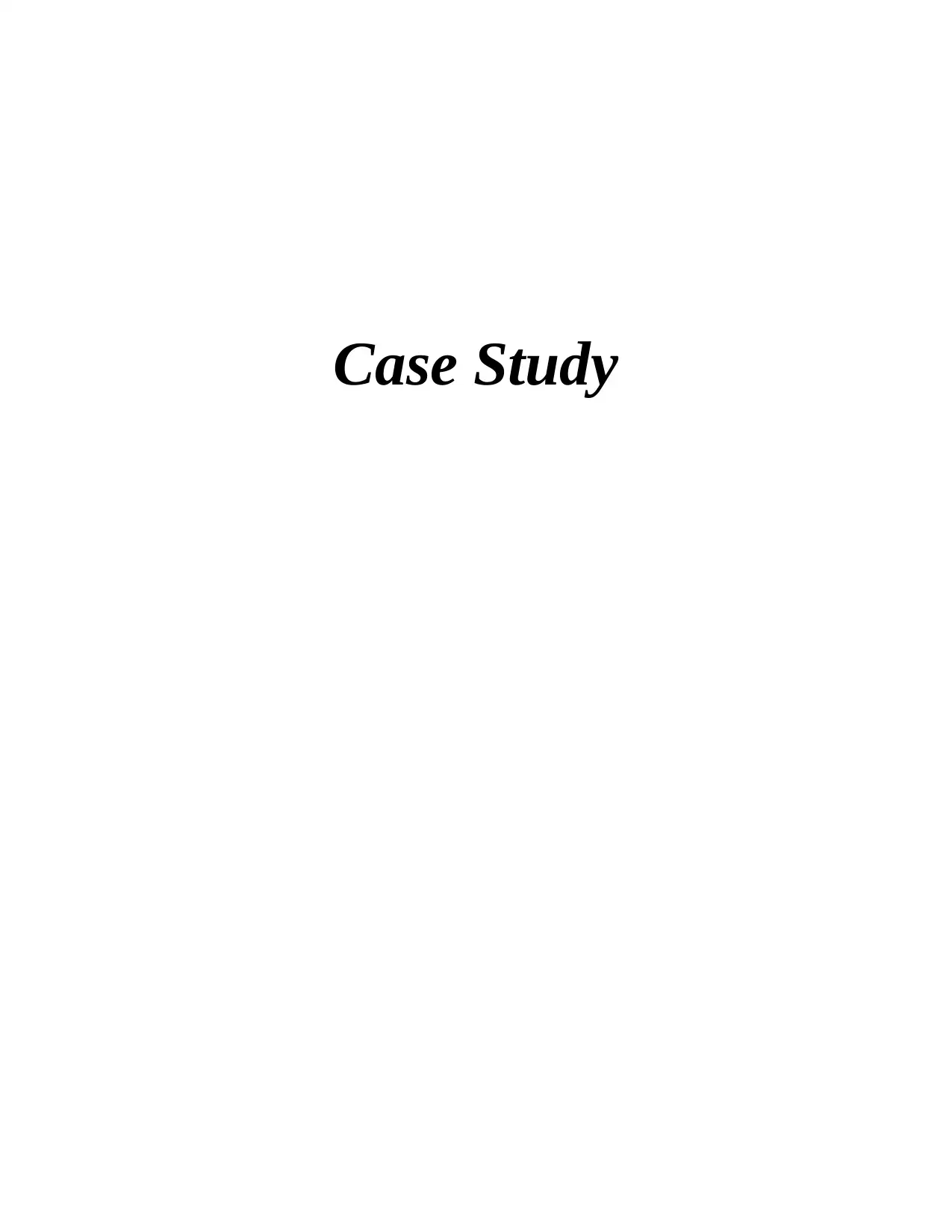
Case Study
Secure Best Marks with AI Grader
Need help grading? Try our AI Grader for instant feedback on your assignments.
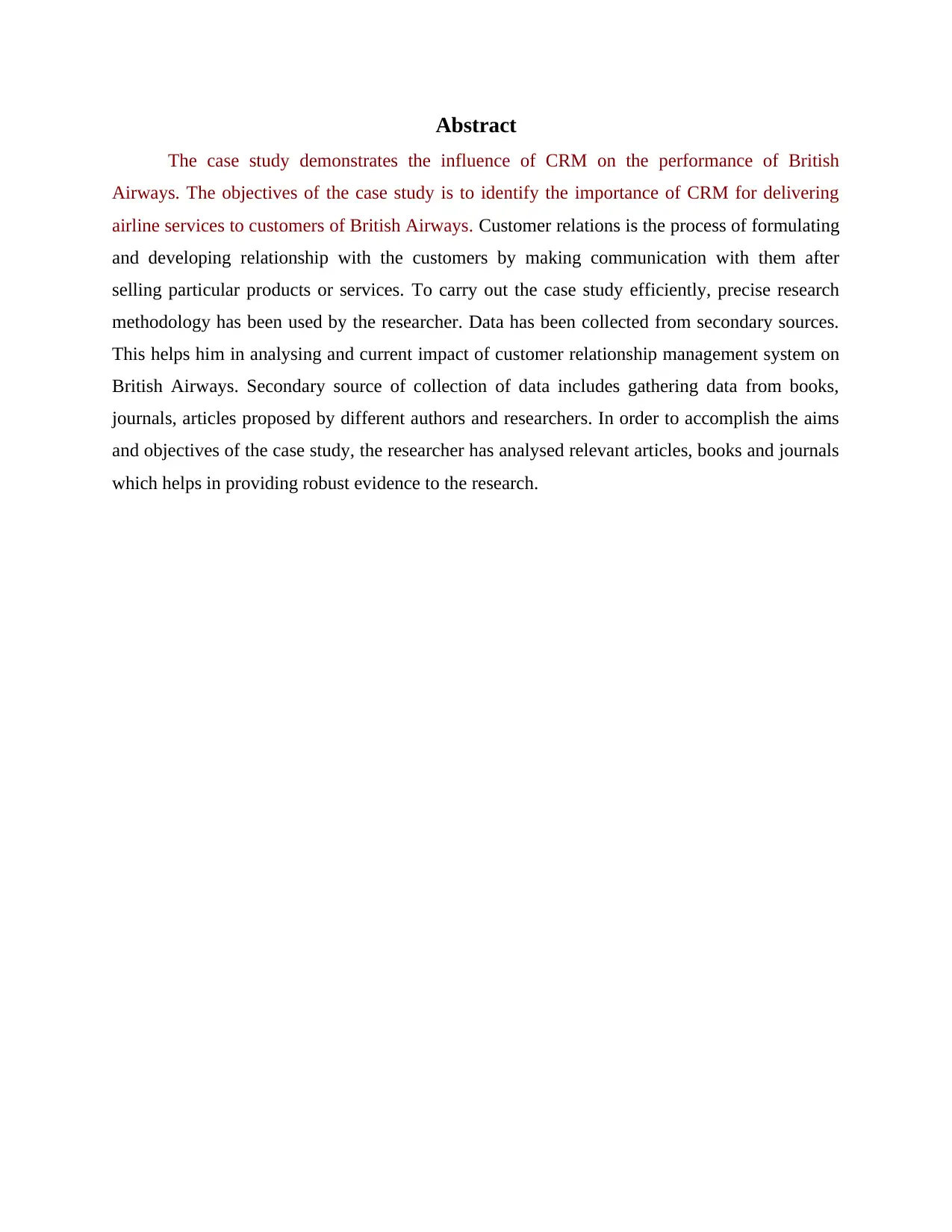
Abstract
The case study demonstrates the influence of CRM on the performance of British
Airways. The objectives of the case study is to identify the importance of CRM for delivering
airline services to customers of British Airways. Customer relations is the process of formulating
and developing relationship with the customers by making communication with them after
selling particular products or services. To carry out the case study efficiently, precise research
methodology has been used by the researcher. Data has been collected from secondary sources.
This helps him in analysing and current impact of customer relationship management system on
British Airways. Secondary source of collection of data includes gathering data from books,
journals, articles proposed by different authors and researchers. In order to accomplish the aims
and objectives of the case study, the researcher has analysed relevant articles, books and journals
which helps in providing robust evidence to the research.
The case study demonstrates the influence of CRM on the performance of British
Airways. The objectives of the case study is to identify the importance of CRM for delivering
airline services to customers of British Airways. Customer relations is the process of formulating
and developing relationship with the customers by making communication with them after
selling particular products or services. To carry out the case study efficiently, precise research
methodology has been used by the researcher. Data has been collected from secondary sources.
This helps him in analysing and current impact of customer relationship management system on
British Airways. Secondary source of collection of data includes gathering data from books,
journals, articles proposed by different authors and researchers. In order to accomplish the aims
and objectives of the case study, the researcher has analysed relevant articles, books and journals
which helps in providing robust evidence to the research.
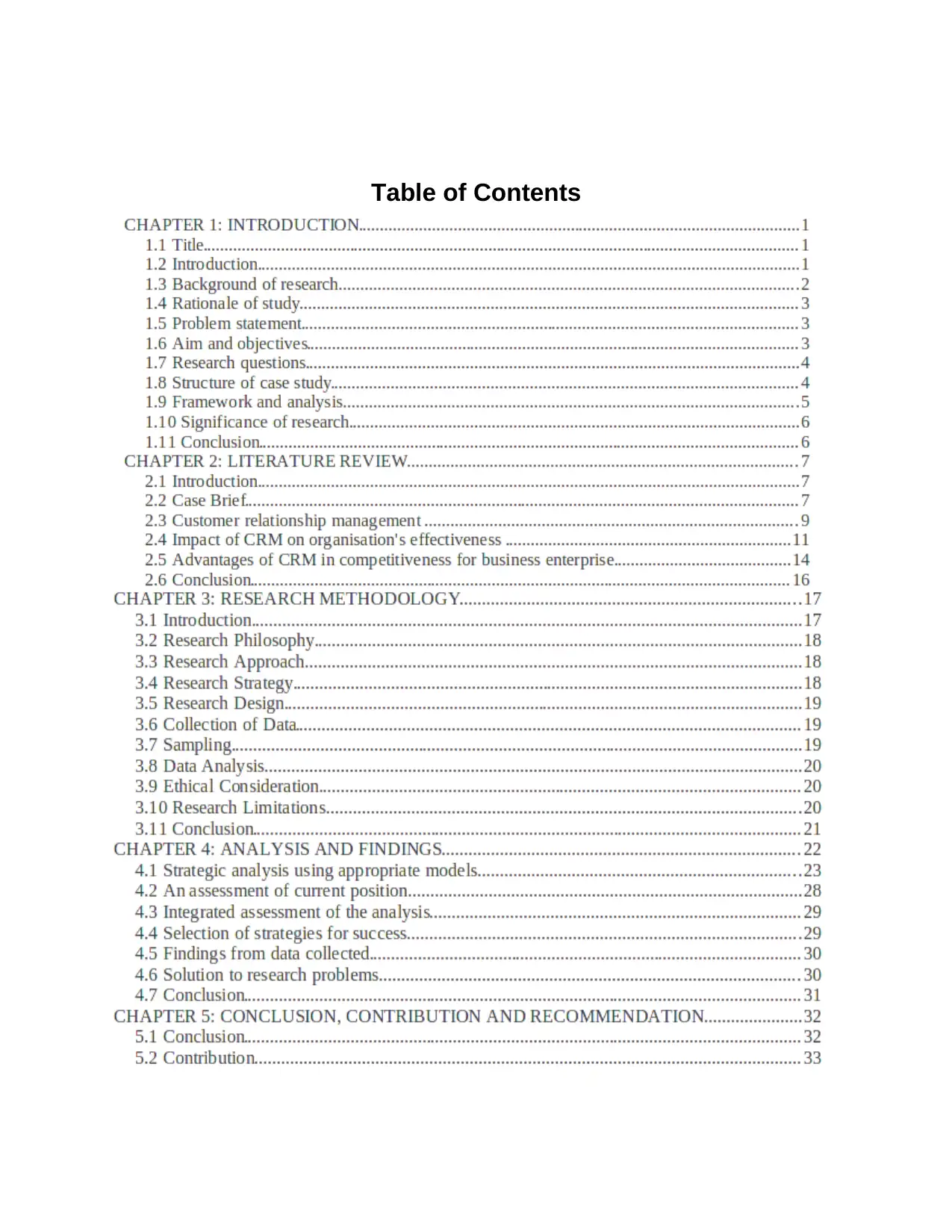
Table of Contents

Secure Best Marks with AI Grader
Need help grading? Try our AI Grader for instant feedback on your assignments.
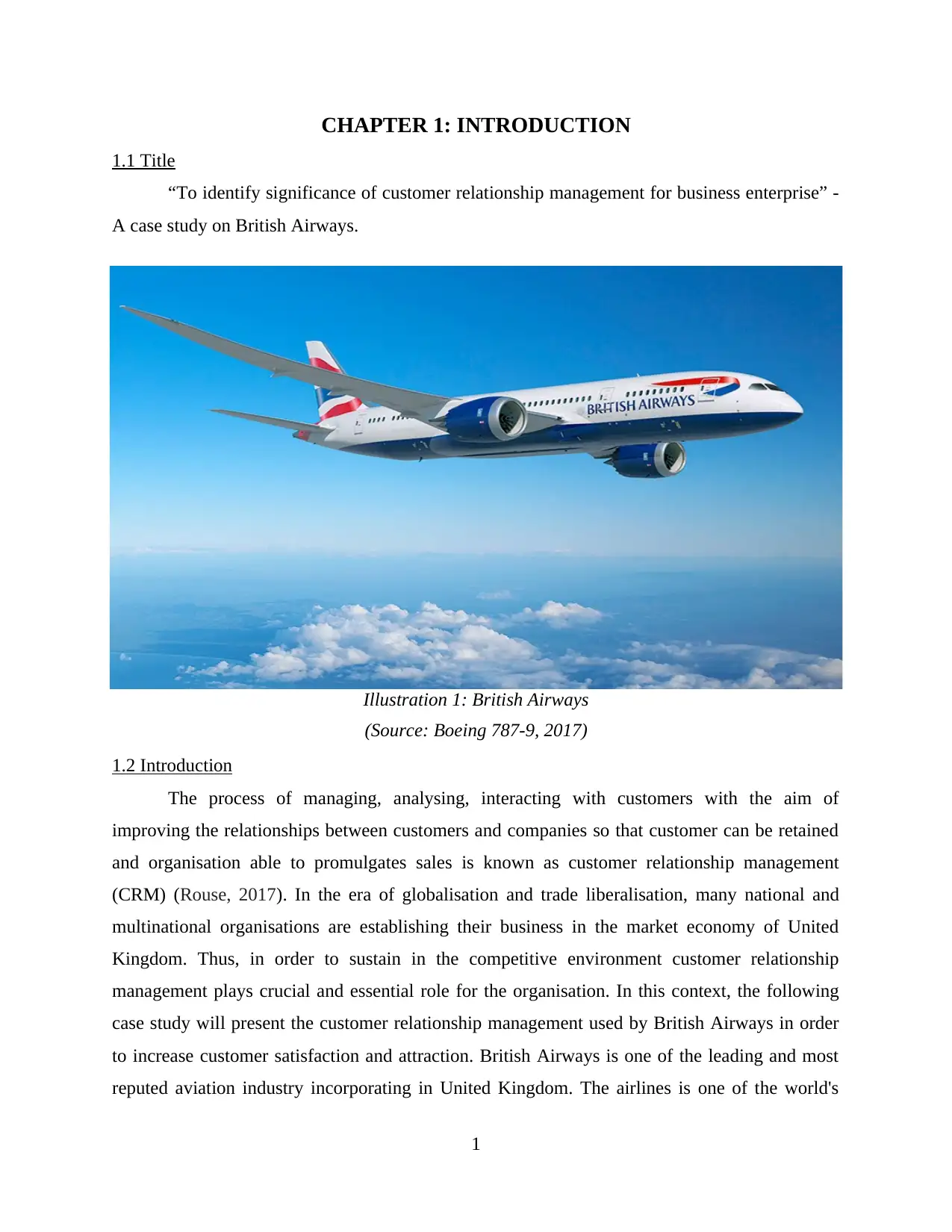
CHAPTER 1: INTRODUCTION
1.1 Title
“To identify significance of customer relationship management for business enterprise” -
A case study on British Airways.
1.2 Introduction
The process of managing, analysing, interacting with customers with the aim of
improving the relationships between customers and companies so that customer can be retained
and organisation able to promulgates sales is known as customer relationship management
(CRM) (Rouse, 2017). In the era of globalisation and trade liberalisation, many national and
multinational organisations are establishing their business in the market economy of United
Kingdom. Thus, in order to sustain in the competitive environment customer relationship
management plays crucial and essential role for the organisation. In this context, the following
case study will present the customer relationship management used by British Airways in order
to increase customer satisfaction and attraction. British Airways is one of the leading and most
reputed aviation industry incorporating in United Kingdom. The airlines is one of the world's
1
Illustration 1: British Airways
(Source: Boeing 787-9, 2017)
1.1 Title
“To identify significance of customer relationship management for business enterprise” -
A case study on British Airways.
1.2 Introduction
The process of managing, analysing, interacting with customers with the aim of
improving the relationships between customers and companies so that customer can be retained
and organisation able to promulgates sales is known as customer relationship management
(CRM) (Rouse, 2017). In the era of globalisation and trade liberalisation, many national and
multinational organisations are establishing their business in the market economy of United
Kingdom. Thus, in order to sustain in the competitive environment customer relationship
management plays crucial and essential role for the organisation. In this context, the following
case study will present the customer relationship management used by British Airways in order
to increase customer satisfaction and attraction. British Airways is one of the leading and most
reputed aviation industry incorporating in United Kingdom. The airlines is one of the world's
1
Illustration 1: British Airways
(Source: Boeing 787-9, 2017)
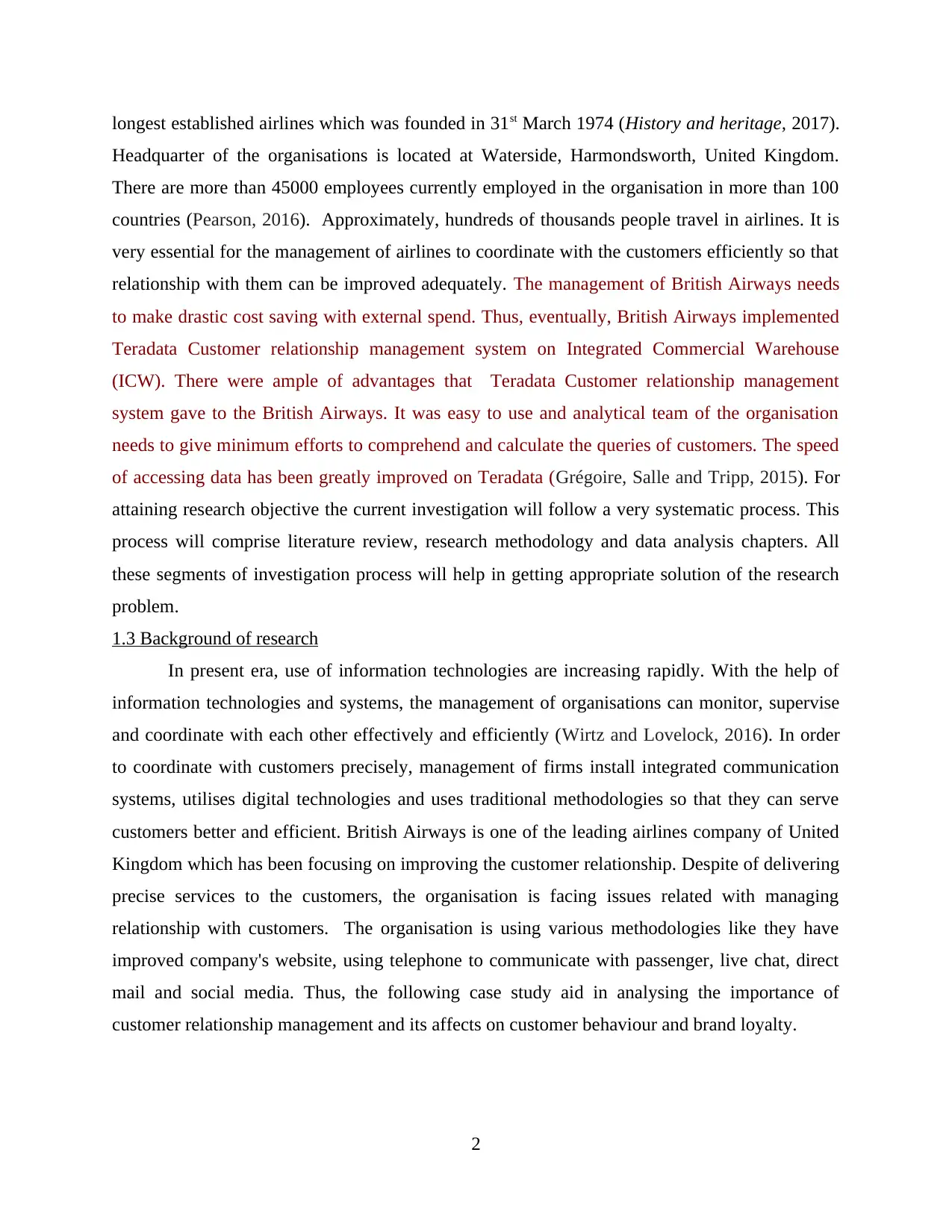
longest established airlines which was founded in 31st March 1974 (History and heritage, 2017).
Headquarter of the organisations is located at Waterside, Harmondsworth, United Kingdom.
There are more than 45000 employees currently employed in the organisation in more than 100
countries (Pearson, 2016). Approximately, hundreds of thousands people travel in airlines. It is
very essential for the management of airlines to coordinate with the customers efficiently so that
relationship with them can be improved adequately. The management of British Airways needs
to make drastic cost saving with external spend. Thus, eventually, British Airways implemented
Teradata Customer relationship management system on Integrated Commercial Warehouse
(ICW). There were ample of advantages that Teradata Customer relationship management
system gave to the British Airways. It was easy to use and analytical team of the organisation
needs to give minimum efforts to comprehend and calculate the queries of customers. The speed
of accessing data has been greatly improved on Teradata (Grégoire, Salle and Tripp, 2015). For
attaining research objective the current investigation will follow a very systematic process. This
process will comprise literature review, research methodology and data analysis chapters. All
these segments of investigation process will help in getting appropriate solution of the research
problem.
1.3 Background of research
In present era, use of information technologies are increasing rapidly. With the help of
information technologies and systems, the management of organisations can monitor, supervise
and coordinate with each other effectively and efficiently (Wirtz and Lovelock, 2016). In order
to coordinate with customers precisely, management of firms install integrated communication
systems, utilises digital technologies and uses traditional methodologies so that they can serve
customers better and efficient. British Airways is one of the leading airlines company of United
Kingdom which has been focusing on improving the customer relationship. Despite of delivering
precise services to the customers, the organisation is facing issues related with managing
relationship with customers. The organisation is using various methodologies like they have
improved company's website, using telephone to communicate with passenger, live chat, direct
mail and social media. Thus, the following case study aid in analysing the importance of
customer relationship management and its affects on customer behaviour and brand loyalty.
2
Headquarter of the organisations is located at Waterside, Harmondsworth, United Kingdom.
There are more than 45000 employees currently employed in the organisation in more than 100
countries (Pearson, 2016). Approximately, hundreds of thousands people travel in airlines. It is
very essential for the management of airlines to coordinate with the customers efficiently so that
relationship with them can be improved adequately. The management of British Airways needs
to make drastic cost saving with external spend. Thus, eventually, British Airways implemented
Teradata Customer relationship management system on Integrated Commercial Warehouse
(ICW). There were ample of advantages that Teradata Customer relationship management
system gave to the British Airways. It was easy to use and analytical team of the organisation
needs to give minimum efforts to comprehend and calculate the queries of customers. The speed
of accessing data has been greatly improved on Teradata (Grégoire, Salle and Tripp, 2015). For
attaining research objective the current investigation will follow a very systematic process. This
process will comprise literature review, research methodology and data analysis chapters. All
these segments of investigation process will help in getting appropriate solution of the research
problem.
1.3 Background of research
In present era, use of information technologies are increasing rapidly. With the help of
information technologies and systems, the management of organisations can monitor, supervise
and coordinate with each other effectively and efficiently (Wirtz and Lovelock, 2016). In order
to coordinate with customers precisely, management of firms install integrated communication
systems, utilises digital technologies and uses traditional methodologies so that they can serve
customers better and efficient. British Airways is one of the leading airlines company of United
Kingdom which has been focusing on improving the customer relationship. Despite of delivering
precise services to the customers, the organisation is facing issues related with managing
relationship with customers. The organisation is using various methodologies like they have
improved company's website, using telephone to communicate with passenger, live chat, direct
mail and social media. Thus, the following case study aid in analysing the importance of
customer relationship management and its affects on customer behaviour and brand loyalty.
2
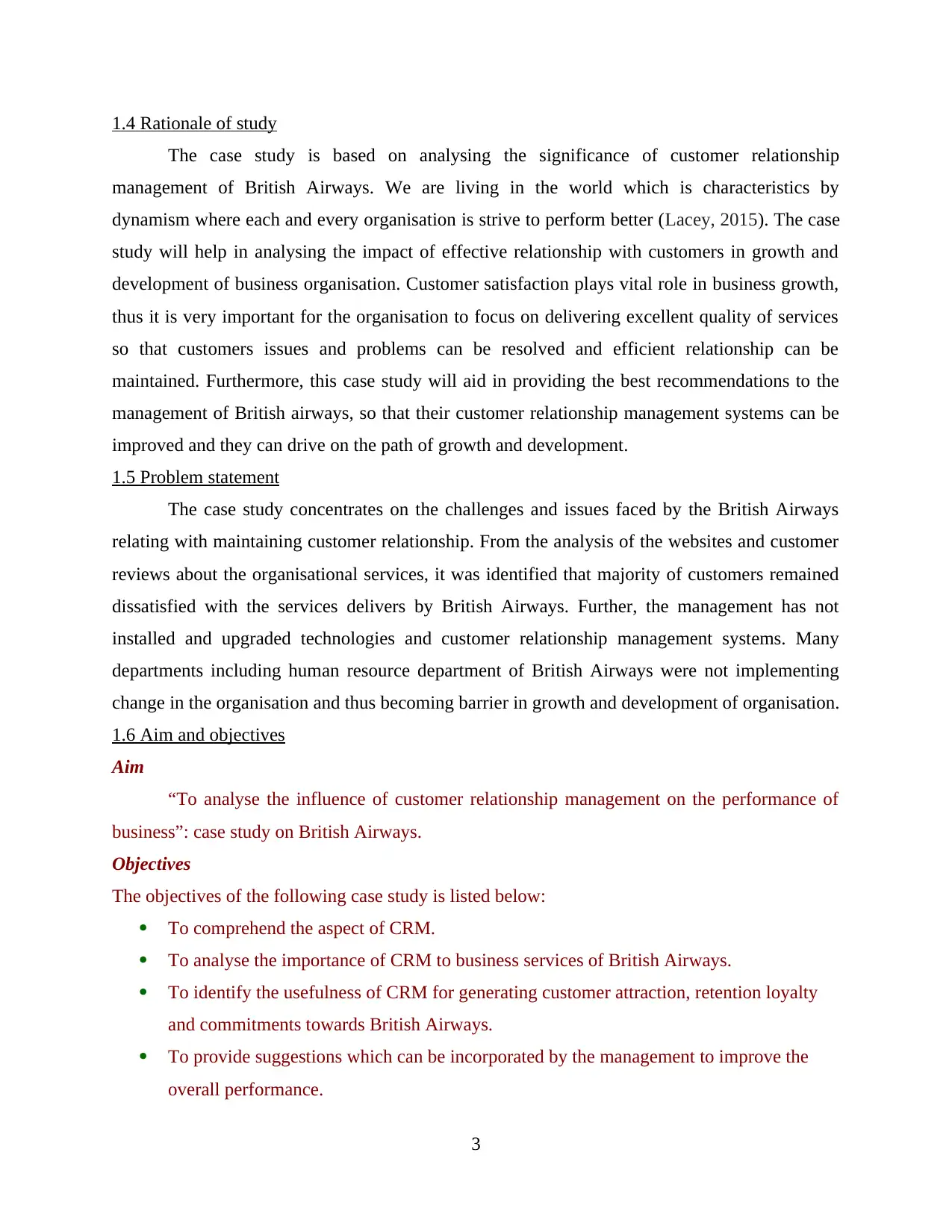
1.4 Rationale of study
The case study is based on analysing the significance of customer relationship
management of British Airways. We are living in the world which is characteristics by
dynamism where each and every organisation is strive to perform better (Lacey, 2015). The case
study will help in analysing the impact of effective relationship with customers in growth and
development of business organisation. Customer satisfaction plays vital role in business growth,
thus it is very important for the organisation to focus on delivering excellent quality of services
so that customers issues and problems can be resolved and efficient relationship can be
maintained. Furthermore, this case study will aid in providing the best recommendations to the
management of British airways, so that their customer relationship management systems can be
improved and they can drive on the path of growth and development.
1.5 Problem statement
The case study concentrates on the challenges and issues faced by the British Airways
relating with maintaining customer relationship. From the analysis of the websites and customer
reviews about the organisational services, it was identified that majority of customers remained
dissatisfied with the services delivers by British Airways. Further, the management has not
installed and upgraded technologies and customer relationship management systems. Many
departments including human resource department of British Airways were not implementing
change in the organisation and thus becoming barrier in growth and development of organisation.
1.6 Aim and objectives
Aim
“To analyse the influence of customer relationship management on the performance of
business”: case study on British Airways.
Objectives
The objectives of the following case study is listed below:
To comprehend the aspect of CRM.
To analyse the importance of CRM to business services of British Airways.
To identify the usefulness of CRM for generating customer attraction, retention loyalty
and commitments towards British Airways.
To provide suggestions which can be incorporated by the management to improve the
overall performance.
3
The case study is based on analysing the significance of customer relationship
management of British Airways. We are living in the world which is characteristics by
dynamism where each and every organisation is strive to perform better (Lacey, 2015). The case
study will help in analysing the impact of effective relationship with customers in growth and
development of business organisation. Customer satisfaction plays vital role in business growth,
thus it is very important for the organisation to focus on delivering excellent quality of services
so that customers issues and problems can be resolved and efficient relationship can be
maintained. Furthermore, this case study will aid in providing the best recommendations to the
management of British airways, so that their customer relationship management systems can be
improved and they can drive on the path of growth and development.
1.5 Problem statement
The case study concentrates on the challenges and issues faced by the British Airways
relating with maintaining customer relationship. From the analysis of the websites and customer
reviews about the organisational services, it was identified that majority of customers remained
dissatisfied with the services delivers by British Airways. Further, the management has not
installed and upgraded technologies and customer relationship management systems. Many
departments including human resource department of British Airways were not implementing
change in the organisation and thus becoming barrier in growth and development of organisation.
1.6 Aim and objectives
Aim
“To analyse the influence of customer relationship management on the performance of
business”: case study on British Airways.
Objectives
The objectives of the following case study is listed below:
To comprehend the aspect of CRM.
To analyse the importance of CRM to business services of British Airways.
To identify the usefulness of CRM for generating customer attraction, retention loyalty
and commitments towards British Airways.
To provide suggestions which can be incorporated by the management to improve the
overall performance.
3
Paraphrase This Document
Need a fresh take? Get an instant paraphrase of this document with our AI Paraphraser
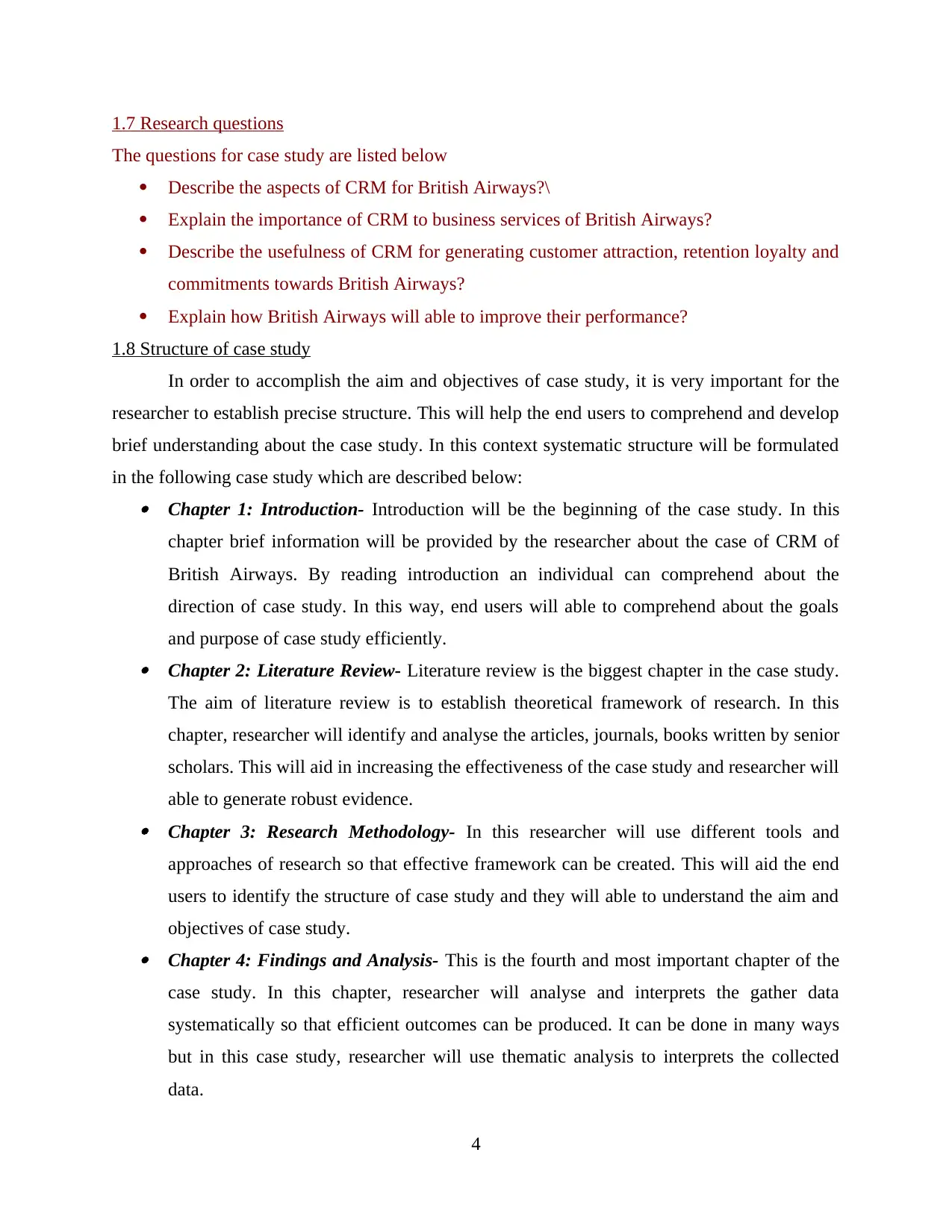
1.7 Research questions
The questions for case study are listed below
Describe the aspects of CRM for British Airways?\
Explain the importance of CRM to business services of British Airways?
Describe the usefulness of CRM for generating customer attraction, retention loyalty and
commitments towards British Airways?
Explain how British Airways will able to improve their performance?
1.8 Structure of case study
In order to accomplish the aim and objectives of case study, it is very important for the
researcher to establish precise structure. This will help the end users to comprehend and develop
brief understanding about the case study. In this context systematic structure will be formulated
in the following case study which are described below: Chapter 1: Introduction- Introduction will be the beginning of the case study. In this
chapter brief information will be provided by the researcher about the case of CRM of
British Airways. By reading introduction an individual can comprehend about the
direction of case study. In this way, end users will able to comprehend about the goals
and purpose of case study efficiently. Chapter 2: Literature Review- Literature review is the biggest chapter in the case study.
The aim of literature review is to establish theoretical framework of research. In this
chapter, researcher will identify and analyse the articles, journals, books written by senior
scholars. This will aid in increasing the effectiveness of the case study and researcher will
able to generate robust evidence. Chapter 3: Research Methodology- In this researcher will use different tools and
approaches of research so that effective framework can be created. This will aid the end
users to identify the structure of case study and they will able to understand the aim and
objectives of case study. Chapter 4: Findings and Analysis- This is the fourth and most important chapter of the
case study. In this chapter, researcher will analyse and interprets the gather data
systematically so that efficient outcomes can be produced. It can be done in many ways
but in this case study, researcher will use thematic analysis to interprets the collected
data.
4
The questions for case study are listed below
Describe the aspects of CRM for British Airways?\
Explain the importance of CRM to business services of British Airways?
Describe the usefulness of CRM for generating customer attraction, retention loyalty and
commitments towards British Airways?
Explain how British Airways will able to improve their performance?
1.8 Structure of case study
In order to accomplish the aim and objectives of case study, it is very important for the
researcher to establish precise structure. This will help the end users to comprehend and develop
brief understanding about the case study. In this context systematic structure will be formulated
in the following case study which are described below: Chapter 1: Introduction- Introduction will be the beginning of the case study. In this
chapter brief information will be provided by the researcher about the case of CRM of
British Airways. By reading introduction an individual can comprehend about the
direction of case study. In this way, end users will able to comprehend about the goals
and purpose of case study efficiently. Chapter 2: Literature Review- Literature review is the biggest chapter in the case study.
The aim of literature review is to establish theoretical framework of research. In this
chapter, researcher will identify and analyse the articles, journals, books written by senior
scholars. This will aid in increasing the effectiveness of the case study and researcher will
able to generate robust evidence. Chapter 3: Research Methodology- In this researcher will use different tools and
approaches of research so that effective framework can be created. This will aid the end
users to identify the structure of case study and they will able to understand the aim and
objectives of case study. Chapter 4: Findings and Analysis- This is the fourth and most important chapter of the
case study. In this chapter, researcher will analyse and interprets the gather data
systematically so that efficient outcomes can be produced. It can be done in many ways
but in this case study, researcher will use thematic analysis to interprets the collected
data.
4
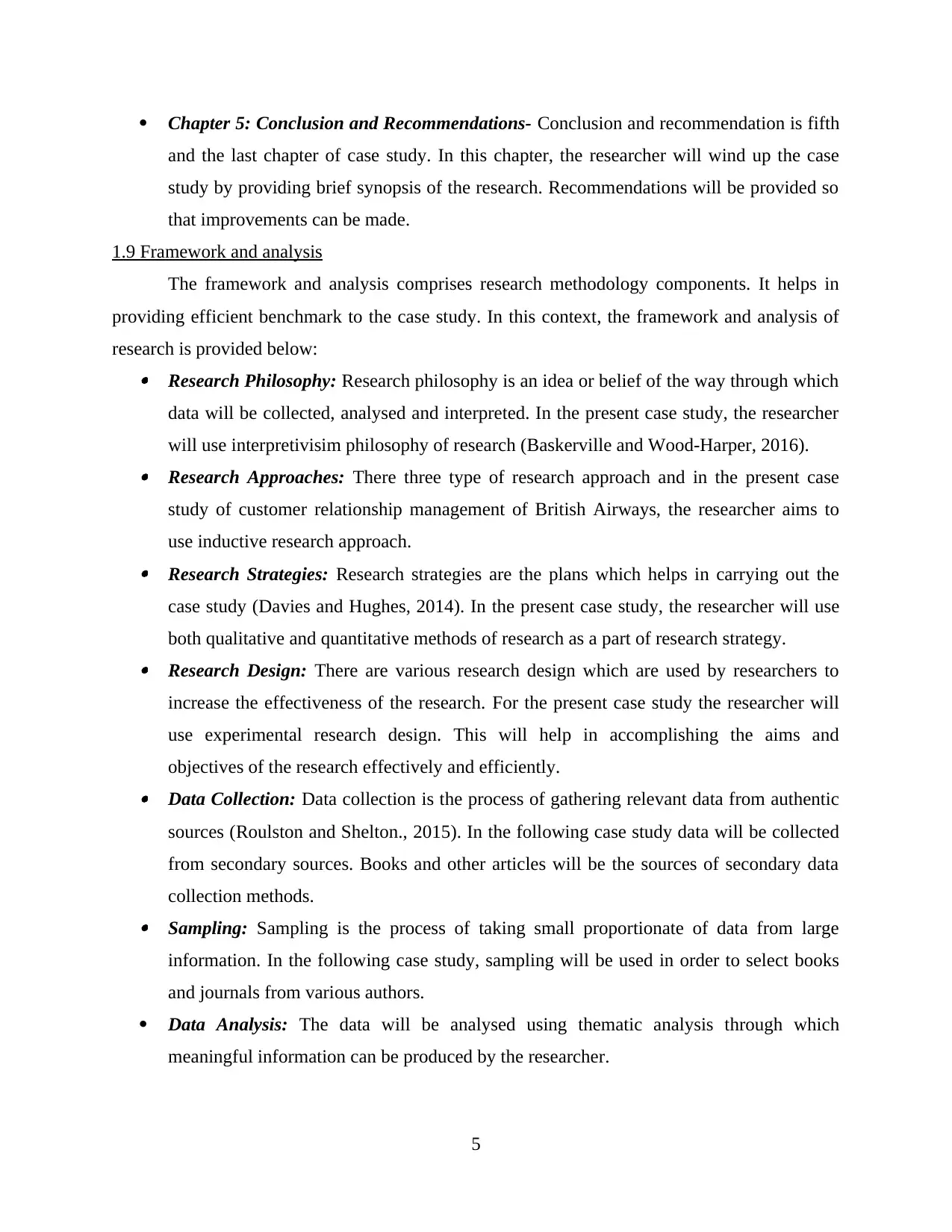
Chapter 5: Conclusion and Recommendations- Conclusion and recommendation is fifth
and the last chapter of case study. In this chapter, the researcher will wind up the case
study by providing brief synopsis of the research. Recommendations will be provided so
that improvements can be made.
1.9 Framework and analysis
The framework and analysis comprises research methodology components. It helps in
providing efficient benchmark to the case study. In this context, the framework and analysis of
research is provided below: Research Philosophy: Research philosophy is an idea or belief of the way through which
data will be collected, analysed and interpreted. In the present case study, the researcher
will use interpretivisim philosophy of research (Baskerville and Wood-Harper, 2016). Research Approaches: There three type of research approach and in the present case
study of customer relationship management of British Airways, the researcher aims to
use inductive research approach. Research Strategies: Research strategies are the plans which helps in carrying out the
case study (Davies and Hughes, 2014). In the present case study, the researcher will use
both qualitative and quantitative methods of research as a part of research strategy. Research Design: There are various research design which are used by researchers to
increase the effectiveness of the research. For the present case study the researcher will
use experimental research design. This will help in accomplishing the aims and
objectives of the research effectively and efficiently. Data Collection: Data collection is the process of gathering relevant data from authentic
sources (Roulston and Shelton., 2015). In the following case study data will be collected
from secondary sources. Books and other articles will be the sources of secondary data
collection methods. Sampling: Sampling is the process of taking small proportionate of data from large
information. In the following case study, sampling will be used in order to select books
and journals from various authors.
Data Analysis: The data will be analysed using thematic analysis through which
meaningful information can be produced by the researcher.
5
and the last chapter of case study. In this chapter, the researcher will wind up the case
study by providing brief synopsis of the research. Recommendations will be provided so
that improvements can be made.
1.9 Framework and analysis
The framework and analysis comprises research methodology components. It helps in
providing efficient benchmark to the case study. In this context, the framework and analysis of
research is provided below: Research Philosophy: Research philosophy is an idea or belief of the way through which
data will be collected, analysed and interpreted. In the present case study, the researcher
will use interpretivisim philosophy of research (Baskerville and Wood-Harper, 2016). Research Approaches: There three type of research approach and in the present case
study of customer relationship management of British Airways, the researcher aims to
use inductive research approach. Research Strategies: Research strategies are the plans which helps in carrying out the
case study (Davies and Hughes, 2014). In the present case study, the researcher will use
both qualitative and quantitative methods of research as a part of research strategy. Research Design: There are various research design which are used by researchers to
increase the effectiveness of the research. For the present case study the researcher will
use experimental research design. This will help in accomplishing the aims and
objectives of the research effectively and efficiently. Data Collection: Data collection is the process of gathering relevant data from authentic
sources (Roulston and Shelton., 2015). In the following case study data will be collected
from secondary sources. Books and other articles will be the sources of secondary data
collection methods. Sampling: Sampling is the process of taking small proportionate of data from large
information. In the following case study, sampling will be used in order to select books
and journals from various authors.
Data Analysis: The data will be analysed using thematic analysis through which
meaningful information can be produced by the researcher.
5
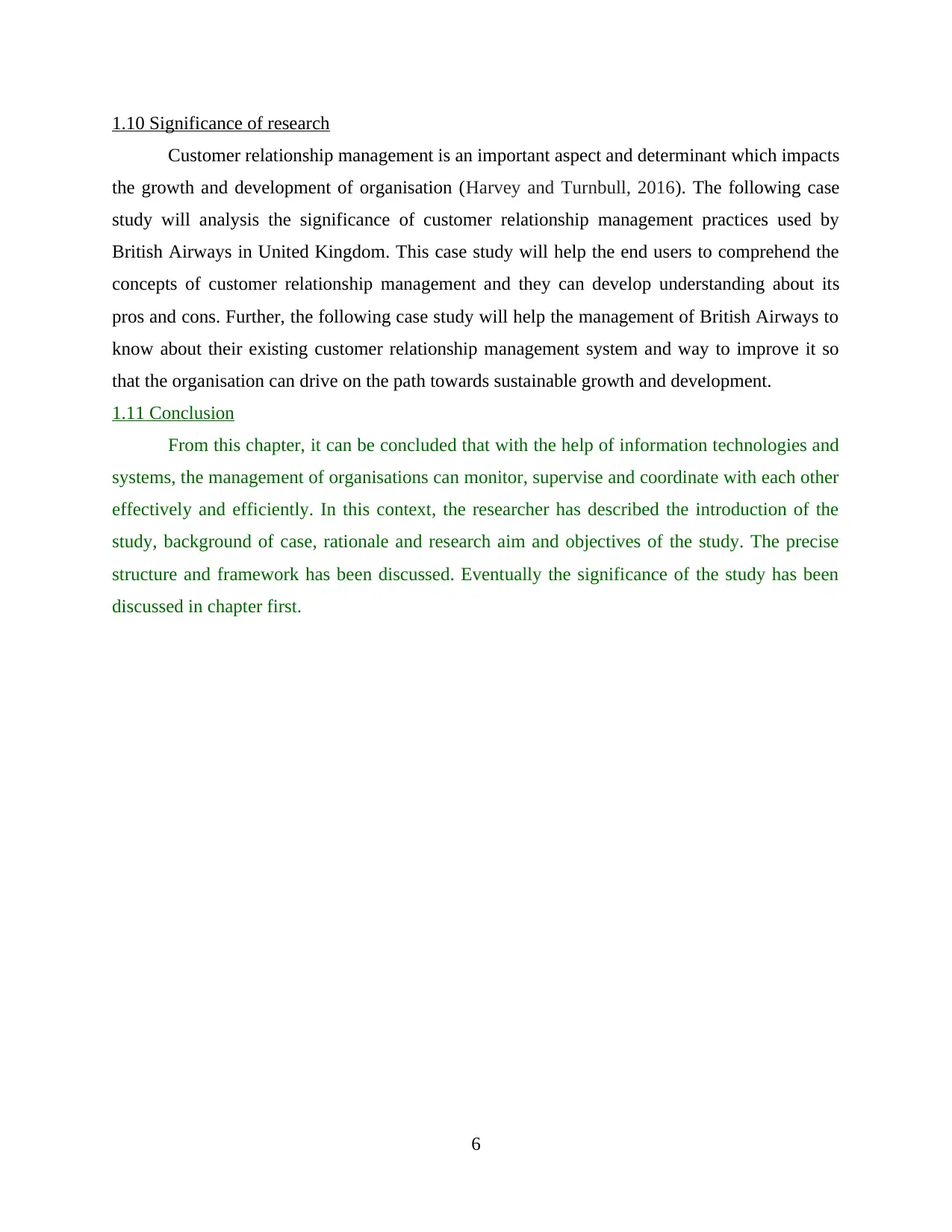
1.10 Significance of research
Customer relationship management is an important aspect and determinant which impacts
the growth and development of organisation (Harvey and Turnbull, 2016). The following case
study will analysis the significance of customer relationship management practices used by
British Airways in United Kingdom. This case study will help the end users to comprehend the
concepts of customer relationship management and they can develop understanding about its
pros and cons. Further, the following case study will help the management of British Airways to
know about their existing customer relationship management system and way to improve it so
that the organisation can drive on the path towards sustainable growth and development.
1.11 Conclusion
From this chapter, it can be concluded that with the help of information technologies and
systems, the management of organisations can monitor, supervise and coordinate with each other
effectively and efficiently. In this context, the researcher has described the introduction of the
study, background of case, rationale and research aim and objectives of the study. The precise
structure and framework has been discussed. Eventually the significance of the study has been
discussed in chapter first.
6
Customer relationship management is an important aspect and determinant which impacts
the growth and development of organisation (Harvey and Turnbull, 2016). The following case
study will analysis the significance of customer relationship management practices used by
British Airways in United Kingdom. This case study will help the end users to comprehend the
concepts of customer relationship management and they can develop understanding about its
pros and cons. Further, the following case study will help the management of British Airways to
know about their existing customer relationship management system and way to improve it so
that the organisation can drive on the path towards sustainable growth and development.
1.11 Conclusion
From this chapter, it can be concluded that with the help of information technologies and
systems, the management of organisations can monitor, supervise and coordinate with each other
effectively and efficiently. In this context, the researcher has described the introduction of the
study, background of case, rationale and research aim and objectives of the study. The precise
structure and framework has been discussed. Eventually the significance of the study has been
discussed in chapter first.
6
Secure Best Marks with AI Grader
Need help grading? Try our AI Grader for instant feedback on your assignments.
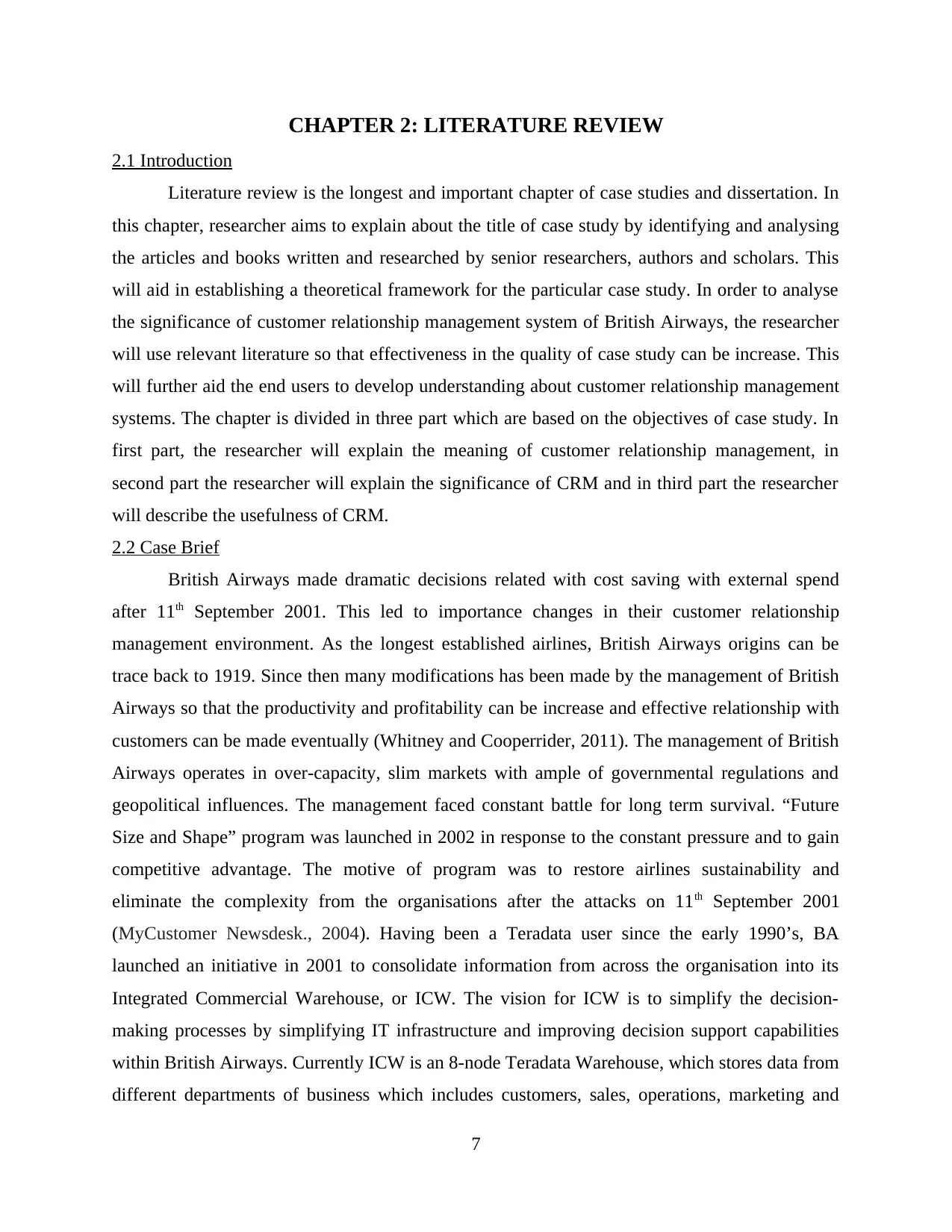
CHAPTER 2: LITERATURE REVIEW
2.1 Introduction
Literature review is the longest and important chapter of case studies and dissertation. In
this chapter, researcher aims to explain about the title of case study by identifying and analysing
the articles and books written and researched by senior researchers, authors and scholars. This
will aid in establishing a theoretical framework for the particular case study. In order to analyse
the significance of customer relationship management system of British Airways, the researcher
will use relevant literature so that effectiveness in the quality of case study can be increase. This
will further aid the end users to develop understanding about customer relationship management
systems. The chapter is divided in three part which are based on the objectives of case study. In
first part, the researcher will explain the meaning of customer relationship management, in
second part the researcher will explain the significance of CRM and in third part the researcher
will describe the usefulness of CRM.
2.2 Case Brief
British Airways made dramatic decisions related with cost saving with external spend
after 11th September 2001. This led to importance changes in their customer relationship
management environment. As the longest established airlines, British Airways origins can be
trace back to 1919. Since then many modifications has been made by the management of British
Airways so that the productivity and profitability can be increase and effective relationship with
customers can be made eventually (Whitney and Cooperrider, 2011). The management of British
Airways operates in over-capacity, slim markets with ample of governmental regulations and
geopolitical influences. The management faced constant battle for long term survival. “Future
Size and Shape” program was launched in 2002 in response to the constant pressure and to gain
competitive advantage. The motive of program was to restore airlines sustainability and
eliminate the complexity from the organisations after the attacks on 11th September 2001
(MyCustomer Newsdesk., 2004). Having been a Teradata user since the early 1990’s, BA
launched an initiative in 2001 to consolidate information from across the organisation into its
Integrated Commercial Warehouse, or ICW. The vision for ICW is to simplify the decision-
making processes by simplifying IT infrastructure and improving decision support capabilities
within British Airways. Currently ICW is an 8-node Teradata Warehouse, which stores data from
different departments of business which includes customers, sales, operations, marketing and
7
2.1 Introduction
Literature review is the longest and important chapter of case studies and dissertation. In
this chapter, researcher aims to explain about the title of case study by identifying and analysing
the articles and books written and researched by senior researchers, authors and scholars. This
will aid in establishing a theoretical framework for the particular case study. In order to analyse
the significance of customer relationship management system of British Airways, the researcher
will use relevant literature so that effectiveness in the quality of case study can be increase. This
will further aid the end users to develop understanding about customer relationship management
systems. The chapter is divided in three part which are based on the objectives of case study. In
first part, the researcher will explain the meaning of customer relationship management, in
second part the researcher will explain the significance of CRM and in third part the researcher
will describe the usefulness of CRM.
2.2 Case Brief
British Airways made dramatic decisions related with cost saving with external spend
after 11th September 2001. This led to importance changes in their customer relationship
management environment. As the longest established airlines, British Airways origins can be
trace back to 1919. Since then many modifications has been made by the management of British
Airways so that the productivity and profitability can be increase and effective relationship with
customers can be made eventually (Whitney and Cooperrider, 2011). The management of British
Airways operates in over-capacity, slim markets with ample of governmental regulations and
geopolitical influences. The management faced constant battle for long term survival. “Future
Size and Shape” program was launched in 2002 in response to the constant pressure and to gain
competitive advantage. The motive of program was to restore airlines sustainability and
eliminate the complexity from the organisations after the attacks on 11th September 2001
(MyCustomer Newsdesk., 2004). Having been a Teradata user since the early 1990’s, BA
launched an initiative in 2001 to consolidate information from across the organisation into its
Integrated Commercial Warehouse, or ICW. The vision for ICW is to simplify the decision-
making processes by simplifying IT infrastructure and improving decision support capabilities
within British Airways. Currently ICW is an 8-node Teradata Warehouse, which stores data from
different departments of business which includes customers, sales, operations, marketing and
7
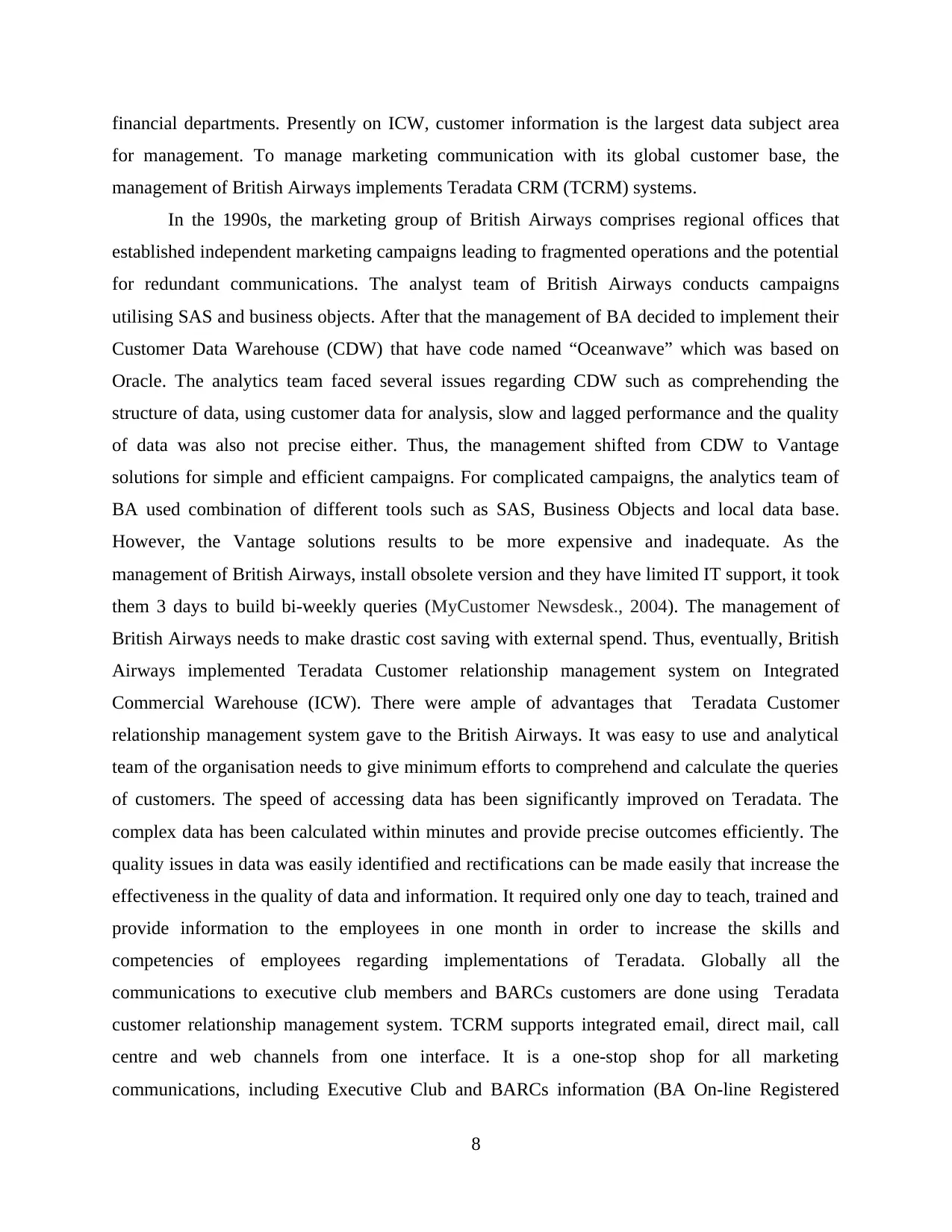
financial departments. Presently on ICW, customer information is the largest data subject area
for management. To manage marketing communication with its global customer base, the
management of British Airways implements Teradata CRM (TCRM) systems.
In the 1990s, the marketing group of British Airways comprises regional offices that
established independent marketing campaigns leading to fragmented operations and the potential
for redundant communications. The analyst team of British Airways conducts campaigns
utilising SAS and business objects. After that the management of BA decided to implement their
Customer Data Warehouse (CDW) that have code named “Oceanwave” which was based on
Oracle. The analytics team faced several issues regarding CDW such as comprehending the
structure of data, using customer data for analysis, slow and lagged performance and the quality
of data was also not precise either. Thus, the management shifted from CDW to Vantage
solutions for simple and efficient campaigns. For complicated campaigns, the analytics team of
BA used combination of different tools such as SAS, Business Objects and local data base.
However, the Vantage solutions results to be more expensive and inadequate. As the
management of British Airways, install obsolete version and they have limited IT support, it took
them 3 days to build bi-weekly queries (MyCustomer Newsdesk., 2004). The management of
British Airways needs to make drastic cost saving with external spend. Thus, eventually, British
Airways implemented Teradata Customer relationship management system on Integrated
Commercial Warehouse (ICW). There were ample of advantages that Teradata Customer
relationship management system gave to the British Airways. It was easy to use and analytical
team of the organisation needs to give minimum efforts to comprehend and calculate the queries
of customers. The speed of accessing data has been significantly improved on Teradata. The
complex data has been calculated within minutes and provide precise outcomes efficiently. The
quality issues in data was easily identified and rectifications can be made easily that increase the
effectiveness in the quality of data and information. It required only one day to teach, trained and
provide information to the employees in one month in order to increase the skills and
competencies of employees regarding implementations of Teradata. Globally all the
communications to executive club members and BARCs customers are done using Teradata
customer relationship management system. TCRM supports integrated email, direct mail, call
centre and web channels from one interface. It is a one-stop shop for all marketing
communications, including Executive Club and BARCs information (BA On-line Registered
8
for management. To manage marketing communication with its global customer base, the
management of British Airways implements Teradata CRM (TCRM) systems.
In the 1990s, the marketing group of British Airways comprises regional offices that
established independent marketing campaigns leading to fragmented operations and the potential
for redundant communications. The analyst team of British Airways conducts campaigns
utilising SAS and business objects. After that the management of BA decided to implement their
Customer Data Warehouse (CDW) that have code named “Oceanwave” which was based on
Oracle. The analytics team faced several issues regarding CDW such as comprehending the
structure of data, using customer data for analysis, slow and lagged performance and the quality
of data was also not precise either. Thus, the management shifted from CDW to Vantage
solutions for simple and efficient campaigns. For complicated campaigns, the analytics team of
BA used combination of different tools such as SAS, Business Objects and local data base.
However, the Vantage solutions results to be more expensive and inadequate. As the
management of British Airways, install obsolete version and they have limited IT support, it took
them 3 days to build bi-weekly queries (MyCustomer Newsdesk., 2004). The management of
British Airways needs to make drastic cost saving with external spend. Thus, eventually, British
Airways implemented Teradata Customer relationship management system on Integrated
Commercial Warehouse (ICW). There were ample of advantages that Teradata Customer
relationship management system gave to the British Airways. It was easy to use and analytical
team of the organisation needs to give minimum efforts to comprehend and calculate the queries
of customers. The speed of accessing data has been significantly improved on Teradata. The
complex data has been calculated within minutes and provide precise outcomes efficiently. The
quality issues in data was easily identified and rectifications can be made easily that increase the
effectiveness in the quality of data and information. It required only one day to teach, trained and
provide information to the employees in one month in order to increase the skills and
competencies of employees regarding implementations of Teradata. Globally all the
communications to executive club members and BARCs customers are done using Teradata
customer relationship management system. TCRM supports integrated email, direct mail, call
centre and web channels from one interface. It is a one-stop shop for all marketing
communications, including Executive Club and BARCs information (BA On-line Registered
8
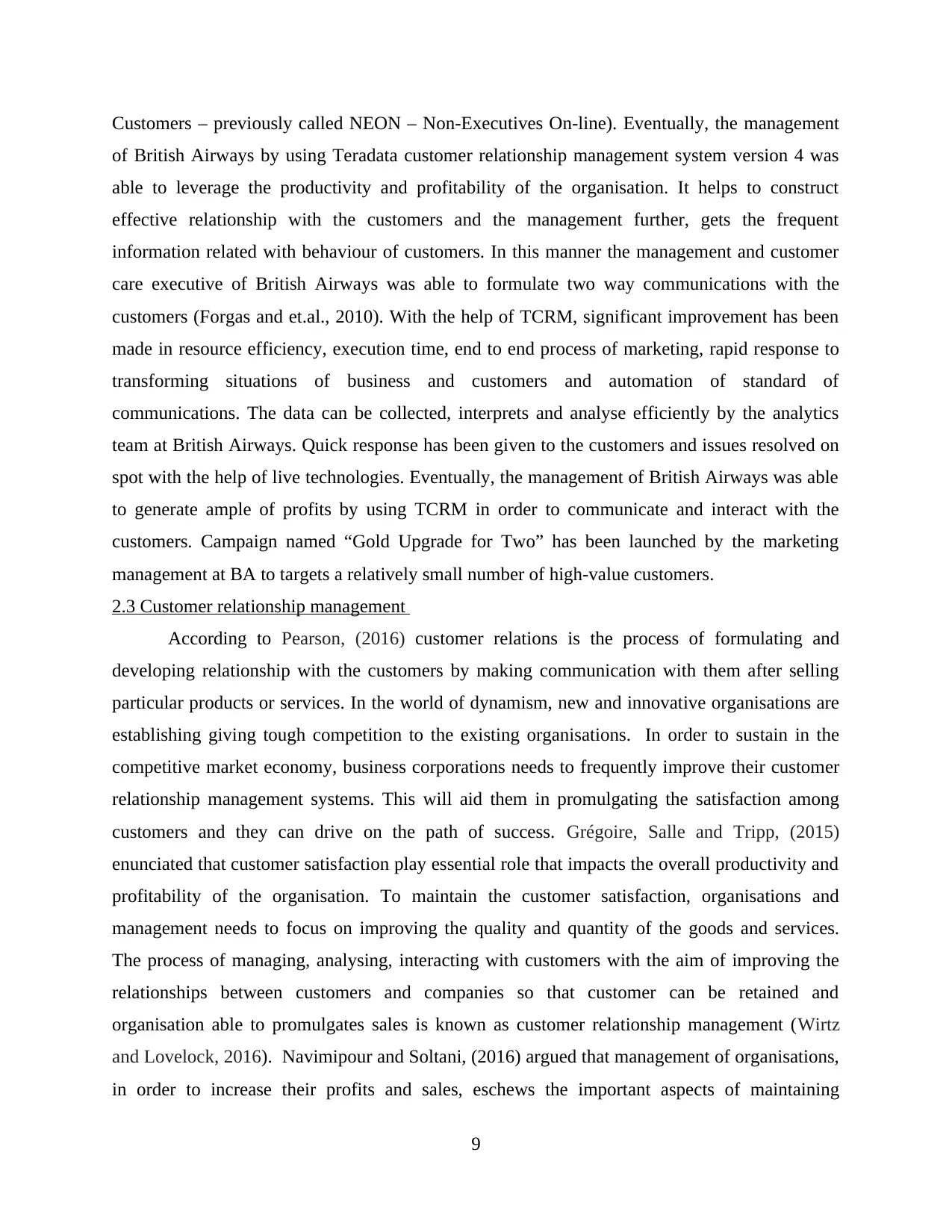
Customers – previously called NEON – Non-Executives On-line). Eventually, the management
of British Airways by using Teradata customer relationship management system version 4 was
able to leverage the productivity and profitability of the organisation. It helps to construct
effective relationship with the customers and the management further, gets the frequent
information related with behaviour of customers. In this manner the management and customer
care executive of British Airways was able to formulate two way communications with the
customers (Forgas and et.al., 2010). With the help of TCRM, significant improvement has been
made in resource efficiency, execution time, end to end process of marketing, rapid response to
transforming situations of business and customers and automation of standard of
communications. The data can be collected, interprets and analyse efficiently by the analytics
team at British Airways. Quick response has been given to the customers and issues resolved on
spot with the help of live technologies. Eventually, the management of British Airways was able
to generate ample of profits by using TCRM in order to communicate and interact with the
customers. Campaign named “Gold Upgrade for Two” has been launched by the marketing
management at BA to targets a relatively small number of high-value customers.
2.3 Customer relationship management
According to Pearson, (2016) customer relations is the process of formulating and
developing relationship with the customers by making communication with them after selling
particular products or services. In the world of dynamism, new and innovative organisations are
establishing giving tough competition to the existing organisations. In order to sustain in the
competitive market economy, business corporations needs to frequently improve their customer
relationship management systems. This will aid them in promulgating the satisfaction among
customers and they can drive on the path of success. Grégoire, Salle and Tripp, (2015)
enunciated that customer satisfaction play essential role that impacts the overall productivity and
profitability of the organisation. To maintain the customer satisfaction, organisations and
management needs to focus on improving the quality and quantity of the goods and services.
The process of managing, analysing, interacting with customers with the aim of improving the
relationships between customers and companies so that customer can be retained and
organisation able to promulgates sales is known as customer relationship management (Wirtz
and Lovelock, 2016). Navimipour and Soltani, (2016) argued that management of organisations,
in order to increase their profits and sales, eschews the important aspects of maintaining
9
of British Airways by using Teradata customer relationship management system version 4 was
able to leverage the productivity and profitability of the organisation. It helps to construct
effective relationship with the customers and the management further, gets the frequent
information related with behaviour of customers. In this manner the management and customer
care executive of British Airways was able to formulate two way communications with the
customers (Forgas and et.al., 2010). With the help of TCRM, significant improvement has been
made in resource efficiency, execution time, end to end process of marketing, rapid response to
transforming situations of business and customers and automation of standard of
communications. The data can be collected, interprets and analyse efficiently by the analytics
team at British Airways. Quick response has been given to the customers and issues resolved on
spot with the help of live technologies. Eventually, the management of British Airways was able
to generate ample of profits by using TCRM in order to communicate and interact with the
customers. Campaign named “Gold Upgrade for Two” has been launched by the marketing
management at BA to targets a relatively small number of high-value customers.
2.3 Customer relationship management
According to Pearson, (2016) customer relations is the process of formulating and
developing relationship with the customers by making communication with them after selling
particular products or services. In the world of dynamism, new and innovative organisations are
establishing giving tough competition to the existing organisations. In order to sustain in the
competitive market economy, business corporations needs to frequently improve their customer
relationship management systems. This will aid them in promulgating the satisfaction among
customers and they can drive on the path of success. Grégoire, Salle and Tripp, (2015)
enunciated that customer satisfaction play essential role that impacts the overall productivity and
profitability of the organisation. To maintain the customer satisfaction, organisations and
management needs to focus on improving the quality and quantity of the goods and services.
The process of managing, analysing, interacting with customers with the aim of improving the
relationships between customers and companies so that customer can be retained and
organisation able to promulgates sales is known as customer relationship management (Wirtz
and Lovelock, 2016). Navimipour and Soltani, (2016) argued that management of organisations,
in order to increase their profits and sales, eschews the important aspects of maintaining
9
Paraphrase This Document
Need a fresh take? Get an instant paraphrase of this document with our AI Paraphraser
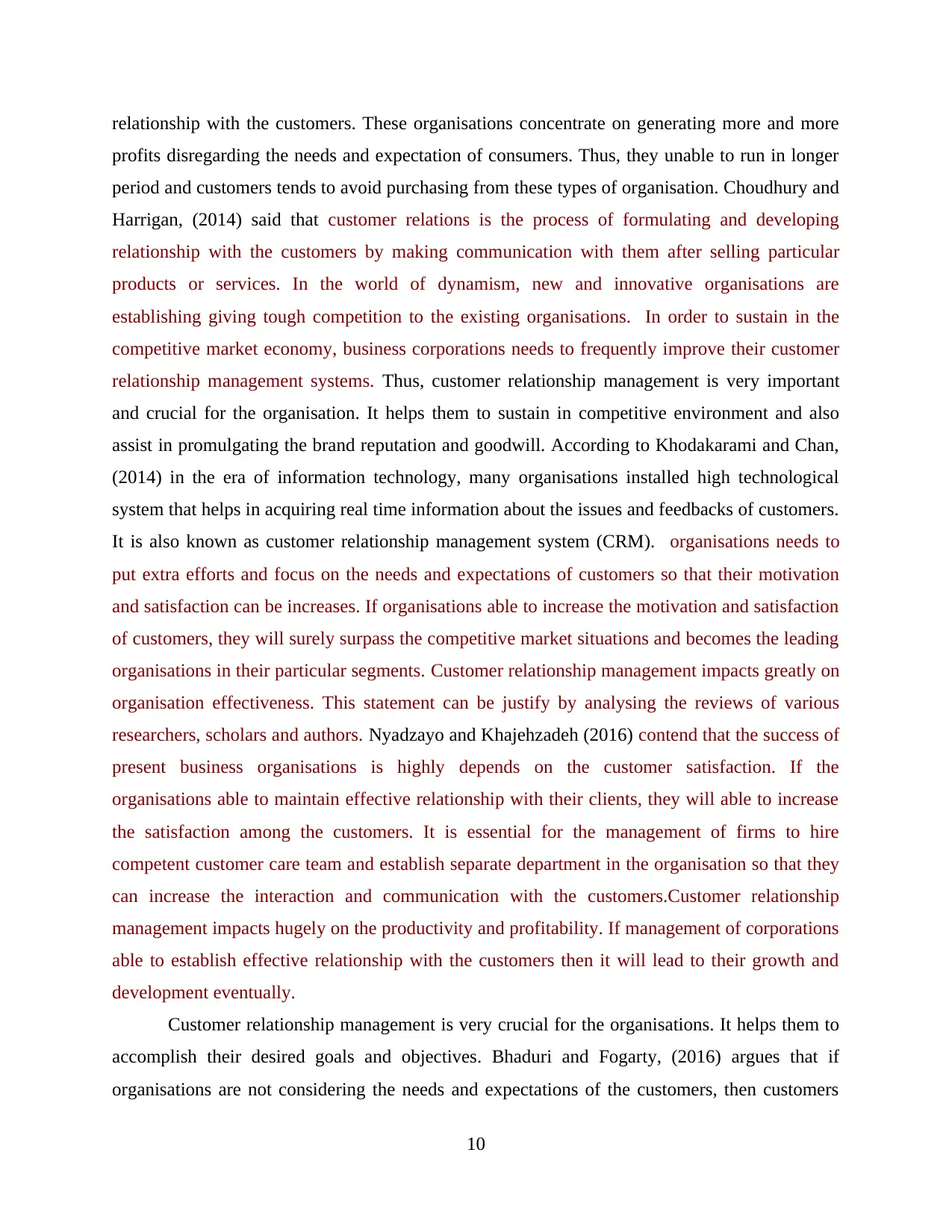
relationship with the customers. These organisations concentrate on generating more and more
profits disregarding the needs and expectation of consumers. Thus, they unable to run in longer
period and customers tends to avoid purchasing from these types of organisation. Choudhury and
Harrigan, (2014) said that customer relations is the process of formulating and developing
relationship with the customers by making communication with them after selling particular
products or services. In the world of dynamism, new and innovative organisations are
establishing giving tough competition to the existing organisations. In order to sustain in the
competitive market economy, business corporations needs to frequently improve their customer
relationship management systems. Thus, customer relationship management is very important
and crucial for the organisation. It helps them to sustain in competitive environment and also
assist in promulgating the brand reputation and goodwill. According to Khodakarami and Chan,
(2014) in the era of information technology, many organisations installed high technological
system that helps in acquiring real time information about the issues and feedbacks of customers.
It is also known as customer relationship management system (CRM). organisations needs to
put extra efforts and focus on the needs and expectations of customers so that their motivation
and satisfaction can be increases. If organisations able to increase the motivation and satisfaction
of customers, they will surely surpass the competitive market situations and becomes the leading
organisations in their particular segments. Customer relationship management impacts greatly on
organisation effectiveness. This statement can be justify by analysing the reviews of various
researchers, scholars and authors. Nyadzayo and Khajehzadeh (2016) contend that the success of
present business organisations is highly depends on the customer satisfaction. If the
organisations able to maintain effective relationship with their clients, they will able to increase
the satisfaction among the customers. It is essential for the management of firms to hire
competent customer care team and establish separate department in the organisation so that they
can increase the interaction and communication with the customers.Customer relationship
management impacts hugely on the productivity and profitability. If management of corporations
able to establish effective relationship with the customers then it will lead to their growth and
development eventually.
Customer relationship management is very crucial for the organisations. It helps them to
accomplish their desired goals and objectives. Bhaduri and Fogarty, (2016) argues that if
organisations are not considering the needs and expectations of the customers, then customers
10
profits disregarding the needs and expectation of consumers. Thus, they unable to run in longer
period and customers tends to avoid purchasing from these types of organisation. Choudhury and
Harrigan, (2014) said that customer relations is the process of formulating and developing
relationship with the customers by making communication with them after selling particular
products or services. In the world of dynamism, new and innovative organisations are
establishing giving tough competition to the existing organisations. In order to sustain in the
competitive market economy, business corporations needs to frequently improve their customer
relationship management systems. Thus, customer relationship management is very important
and crucial for the organisation. It helps them to sustain in competitive environment and also
assist in promulgating the brand reputation and goodwill. According to Khodakarami and Chan,
(2014) in the era of information technology, many organisations installed high technological
system that helps in acquiring real time information about the issues and feedbacks of customers.
It is also known as customer relationship management system (CRM). organisations needs to
put extra efforts and focus on the needs and expectations of customers so that their motivation
and satisfaction can be increases. If organisations able to increase the motivation and satisfaction
of customers, they will surely surpass the competitive market situations and becomes the leading
organisations in their particular segments. Customer relationship management impacts greatly on
organisation effectiveness. This statement can be justify by analysing the reviews of various
researchers, scholars and authors. Nyadzayo and Khajehzadeh (2016) contend that the success of
present business organisations is highly depends on the customer satisfaction. If the
organisations able to maintain effective relationship with their clients, they will able to increase
the satisfaction among the customers. It is essential for the management of firms to hire
competent customer care team and establish separate department in the organisation so that they
can increase the interaction and communication with the customers.Customer relationship
management impacts hugely on the productivity and profitability. If management of corporations
able to establish effective relationship with the customers then it will lead to their growth and
development eventually.
Customer relationship management is very crucial for the organisations. It helps them to
accomplish their desired goals and objectives. Bhaduri and Fogarty, (2016) argues that if
organisations are not considering the needs and expectations of the customers, then customers
10
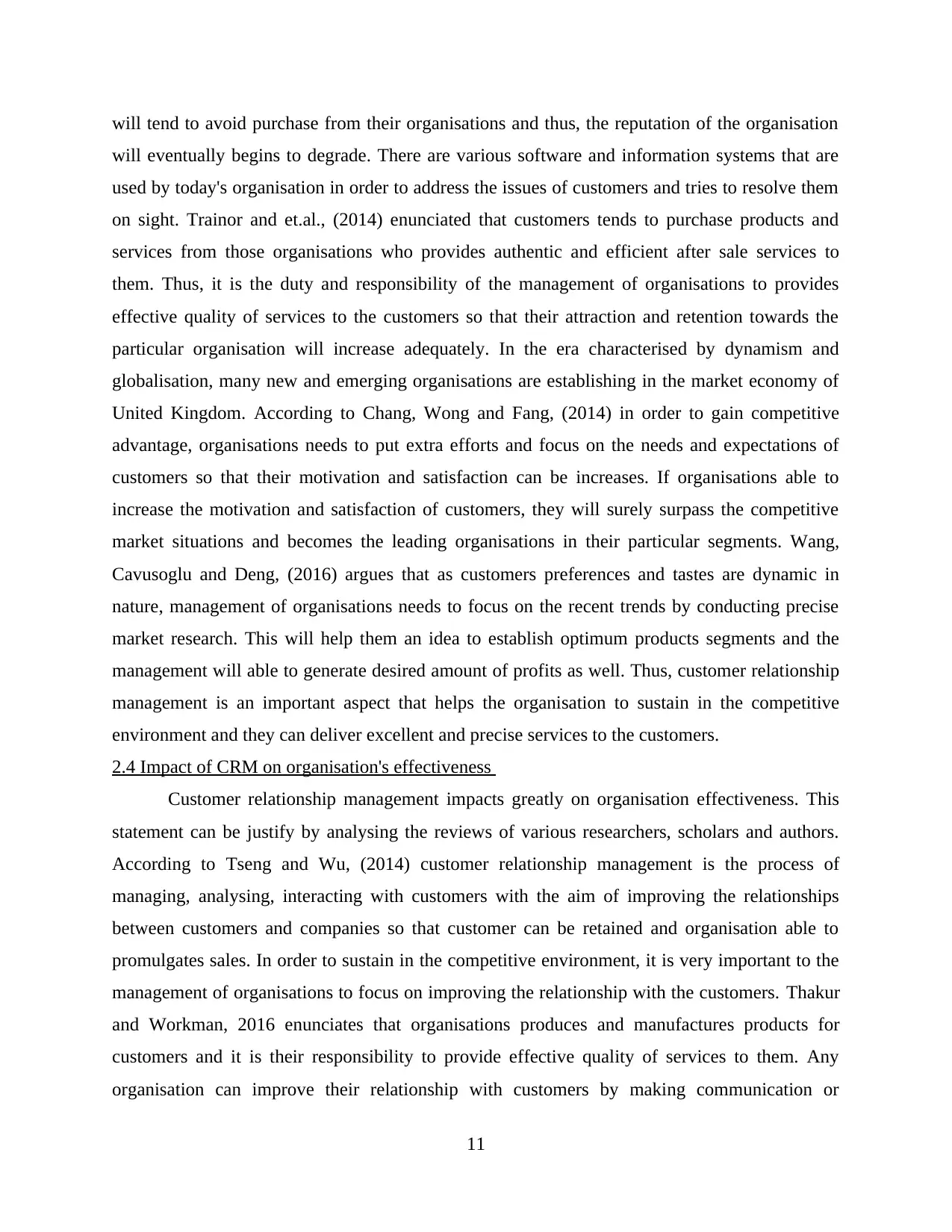
will tend to avoid purchase from their organisations and thus, the reputation of the organisation
will eventually begins to degrade. There are various software and information systems that are
used by today's organisation in order to address the issues of customers and tries to resolve them
on sight. Trainor and et.al., (2014) enunciated that customers tends to purchase products and
services from those organisations who provides authentic and efficient after sale services to
them. Thus, it is the duty and responsibility of the management of organisations to provides
effective quality of services to the customers so that their attraction and retention towards the
particular organisation will increase adequately. In the era characterised by dynamism and
globalisation, many new and emerging organisations are establishing in the market economy of
United Kingdom. According to Chang, Wong and Fang, (2014) in order to gain competitive
advantage, organisations needs to put extra efforts and focus on the needs and expectations of
customers so that their motivation and satisfaction can be increases. If organisations able to
increase the motivation and satisfaction of customers, they will surely surpass the competitive
market situations and becomes the leading organisations in their particular segments. Wang,
Cavusoglu and Deng, (2016) argues that as customers preferences and tastes are dynamic in
nature, management of organisations needs to focus on the recent trends by conducting precise
market research. This will help them an idea to establish optimum products segments and the
management will able to generate desired amount of profits as well. Thus, customer relationship
management is an important aspect that helps the organisation to sustain in the competitive
environment and they can deliver excellent and precise services to the customers.
2.4 Impact of CRM on organisation's effectiveness
Customer relationship management impacts greatly on organisation effectiveness. This
statement can be justify by analysing the reviews of various researchers, scholars and authors.
According to Tseng and Wu, (2014) customer relationship management is the process of
managing, analysing, interacting with customers with the aim of improving the relationships
between customers and companies so that customer can be retained and organisation able to
promulgates sales. In order to sustain in the competitive environment, it is very important to the
management of organisations to focus on improving the relationship with the customers. Thakur
and Workman, 2016 enunciates that organisations produces and manufactures products for
customers and it is their responsibility to provide effective quality of services to them. Any
organisation can improve their relationship with customers by making communication or
11
will eventually begins to degrade. There are various software and information systems that are
used by today's organisation in order to address the issues of customers and tries to resolve them
on sight. Trainor and et.al., (2014) enunciated that customers tends to purchase products and
services from those organisations who provides authentic and efficient after sale services to
them. Thus, it is the duty and responsibility of the management of organisations to provides
effective quality of services to the customers so that their attraction and retention towards the
particular organisation will increase adequately. In the era characterised by dynamism and
globalisation, many new and emerging organisations are establishing in the market economy of
United Kingdom. According to Chang, Wong and Fang, (2014) in order to gain competitive
advantage, organisations needs to put extra efforts and focus on the needs and expectations of
customers so that their motivation and satisfaction can be increases. If organisations able to
increase the motivation and satisfaction of customers, they will surely surpass the competitive
market situations and becomes the leading organisations in their particular segments. Wang,
Cavusoglu and Deng, (2016) argues that as customers preferences and tastes are dynamic in
nature, management of organisations needs to focus on the recent trends by conducting precise
market research. This will help them an idea to establish optimum products segments and the
management will able to generate desired amount of profits as well. Thus, customer relationship
management is an important aspect that helps the organisation to sustain in the competitive
environment and they can deliver excellent and precise services to the customers.
2.4 Impact of CRM on organisation's effectiveness
Customer relationship management impacts greatly on organisation effectiveness. This
statement can be justify by analysing the reviews of various researchers, scholars and authors.
According to Tseng and Wu, (2014) customer relationship management is the process of
managing, analysing, interacting with customers with the aim of improving the relationships
between customers and companies so that customer can be retained and organisation able to
promulgates sales. In order to sustain in the competitive environment, it is very important to the
management of organisations to focus on improving the relationship with the customers. Thakur
and Workman, 2016 enunciates that organisations produces and manufactures products for
customers and it is their responsibility to provide effective quality of services to them. Any
organisation can improve their relationship with customers by making communication or
11
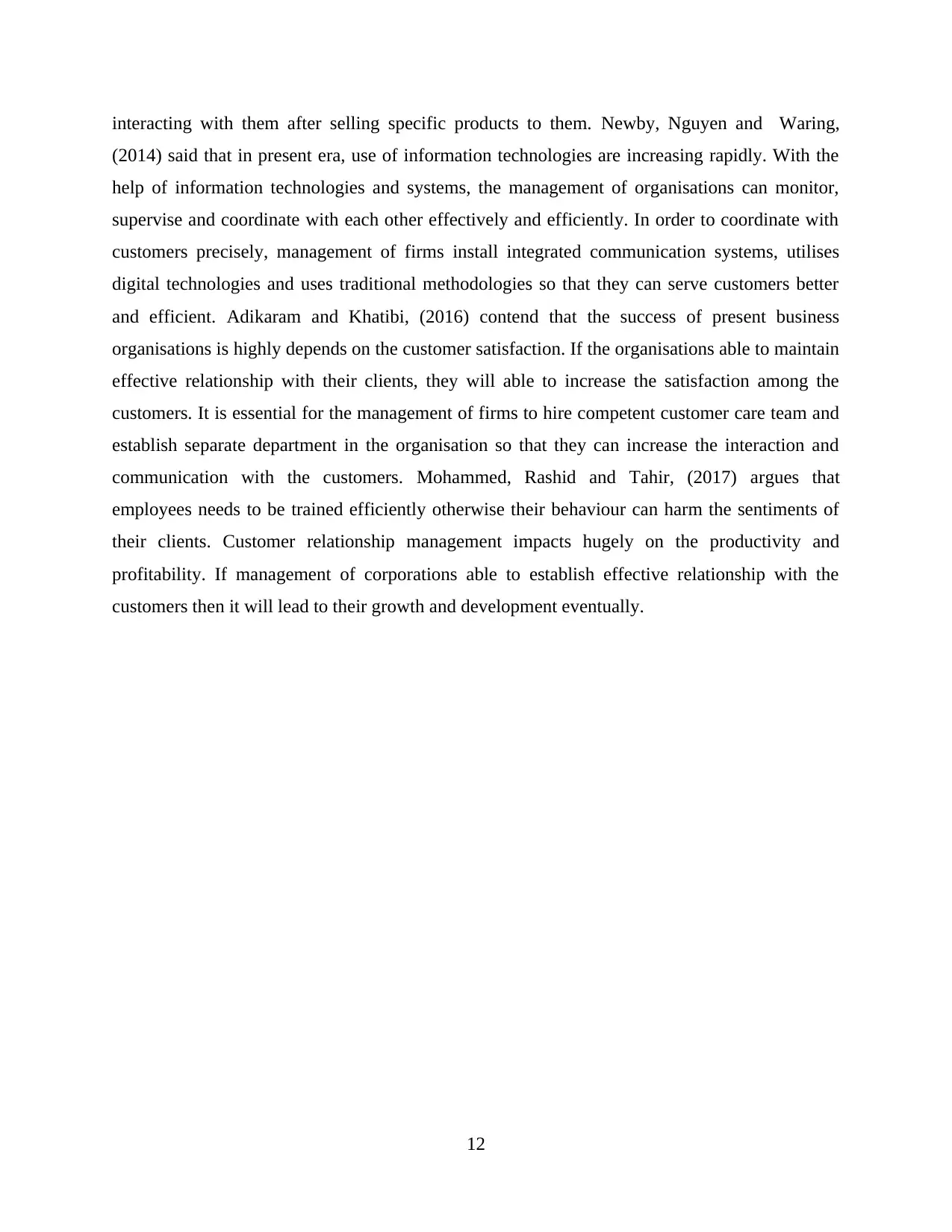
interacting with them after selling specific products to them. Newby, Nguyen and Waring,
(2014) said that in present era, use of information technologies are increasing rapidly. With the
help of information technologies and systems, the management of organisations can monitor,
supervise and coordinate with each other effectively and efficiently. In order to coordinate with
customers precisely, management of firms install integrated communication systems, utilises
digital technologies and uses traditional methodologies so that they can serve customers better
and efficient. Adikaram and Khatibi, (2016) contend that the success of present business
organisations is highly depends on the customer satisfaction. If the organisations able to maintain
effective relationship with their clients, they will able to increase the satisfaction among the
customers. It is essential for the management of firms to hire competent customer care team and
establish separate department in the organisation so that they can increase the interaction and
communication with the customers. Mohammed, Rashid and Tahir, (2017) argues that
employees needs to be trained efficiently otherwise their behaviour can harm the sentiments of
their clients. Customer relationship management impacts hugely on the productivity and
profitability. If management of corporations able to establish effective relationship with the
customers then it will lead to their growth and development eventually.
12
(2014) said that in present era, use of information technologies are increasing rapidly. With the
help of information technologies and systems, the management of organisations can monitor,
supervise and coordinate with each other effectively and efficiently. In order to coordinate with
customers precisely, management of firms install integrated communication systems, utilises
digital technologies and uses traditional methodologies so that they can serve customers better
and efficient. Adikaram and Khatibi, (2016) contend that the success of present business
organisations is highly depends on the customer satisfaction. If the organisations able to maintain
effective relationship with their clients, they will able to increase the satisfaction among the
customers. It is essential for the management of firms to hire competent customer care team and
establish separate department in the organisation so that they can increase the interaction and
communication with the customers. Mohammed, Rashid and Tahir, (2017) argues that
employees needs to be trained efficiently otherwise their behaviour can harm the sentiments of
their clients. Customer relationship management impacts hugely on the productivity and
profitability. If management of corporations able to establish effective relationship with the
customers then it will lead to their growth and development eventually.
12
Secure Best Marks with AI Grader
Need help grading? Try our AI Grader for instant feedback on your assignments.
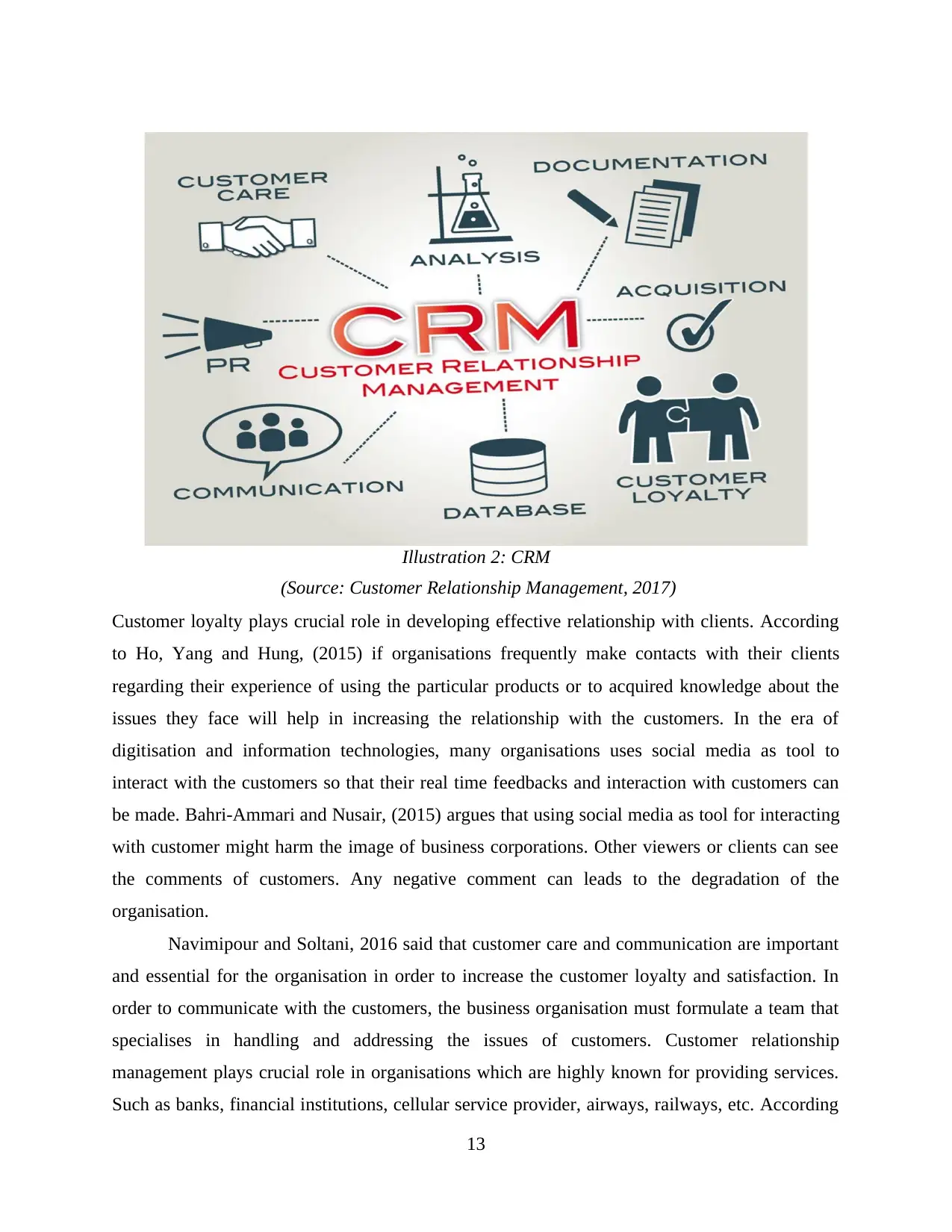
Customer loyalty plays crucial role in developing effective relationship with clients. According
to Ho, Yang and Hung, (2015) if organisations frequently make contacts with their clients
regarding their experience of using the particular products or to acquired knowledge about the
issues they face will help in increasing the relationship with the customers. In the era of
digitisation and information technologies, many organisations uses social media as tool to
interact with the customers so that their real time feedbacks and interaction with customers can
be made. Bahri-Ammari and Nusair, (2015) argues that using social media as tool for interacting
with customer might harm the image of business corporations. Other viewers or clients can see
the comments of customers. Any negative comment can leads to the degradation of the
organisation.
Navimipour and Soltani, 2016 said that customer care and communication are important
and essential for the organisation in order to increase the customer loyalty and satisfaction. In
order to communicate with the customers, the business organisation must formulate a team that
specialises in handling and addressing the issues of customers. Customer relationship
management plays crucial role in organisations which are highly known for providing services.
Such as banks, financial institutions, cellular service provider, airways, railways, etc. According
13
Illustration 2: CRM
(Source: Customer Relationship Management, 2017)
to Ho, Yang and Hung, (2015) if organisations frequently make contacts with their clients
regarding their experience of using the particular products or to acquired knowledge about the
issues they face will help in increasing the relationship with the customers. In the era of
digitisation and information technologies, many organisations uses social media as tool to
interact with the customers so that their real time feedbacks and interaction with customers can
be made. Bahri-Ammari and Nusair, (2015) argues that using social media as tool for interacting
with customer might harm the image of business corporations. Other viewers or clients can see
the comments of customers. Any negative comment can leads to the degradation of the
organisation.
Navimipour and Soltani, 2016 said that customer care and communication are important
and essential for the organisation in order to increase the customer loyalty and satisfaction. In
order to communicate with the customers, the business organisation must formulate a team that
specialises in handling and addressing the issues of customers. Customer relationship
management plays crucial role in organisations which are highly known for providing services.
Such as banks, financial institutions, cellular service provider, airways, railways, etc. According
13
Illustration 2: CRM
(Source: Customer Relationship Management, 2017)
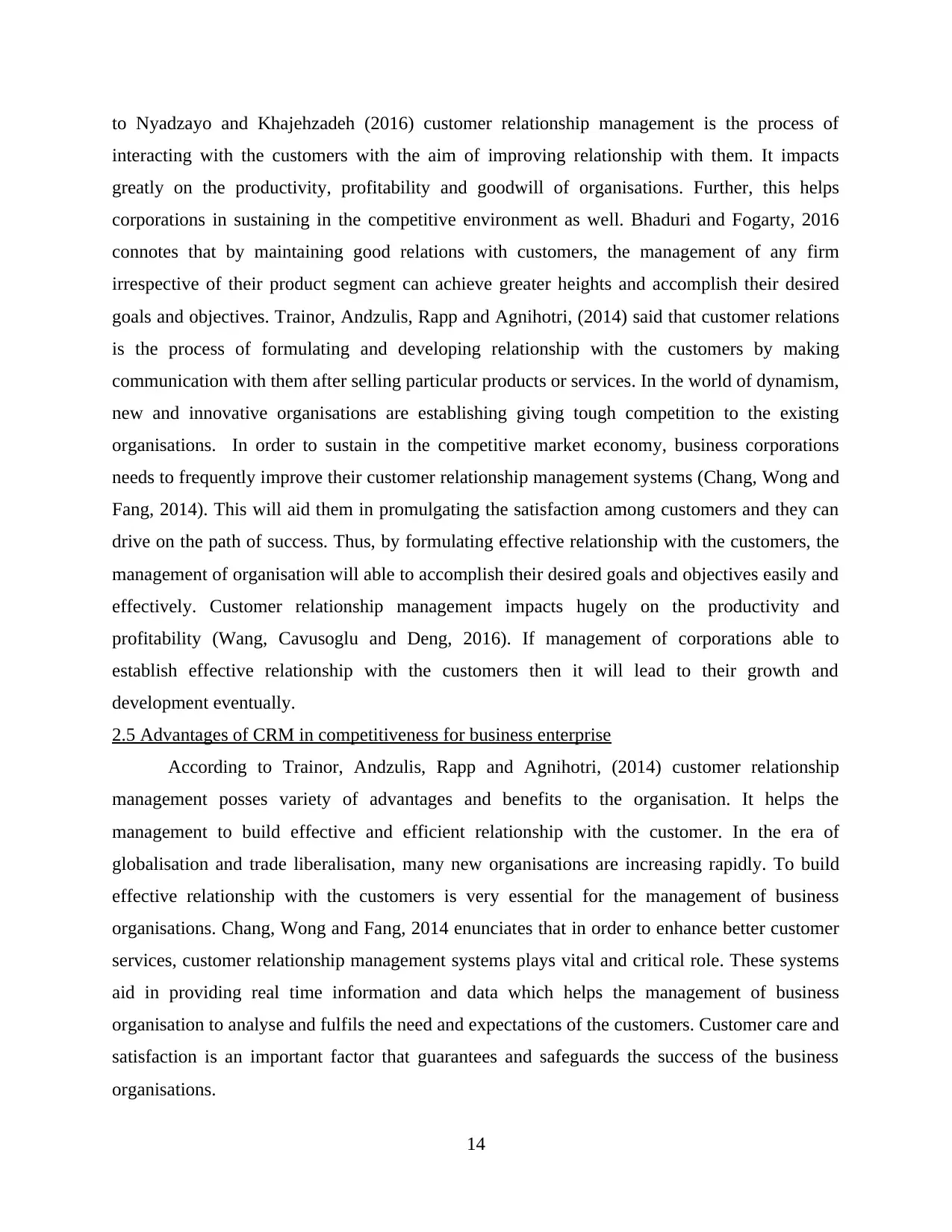
to Nyadzayo and Khajehzadeh (2016) customer relationship management is the process of
interacting with the customers with the aim of improving relationship with them. It impacts
greatly on the productivity, profitability and goodwill of organisations. Further, this helps
corporations in sustaining in the competitive environment as well. Bhaduri and Fogarty, 2016
connotes that by maintaining good relations with customers, the management of any firm
irrespective of their product segment can achieve greater heights and accomplish their desired
goals and objectives. Trainor, Andzulis, Rapp and Agnihotri, (2014) said that customer relations
is the process of formulating and developing relationship with the customers by making
communication with them after selling particular products or services. In the world of dynamism,
new and innovative organisations are establishing giving tough competition to the existing
organisations. In order to sustain in the competitive market economy, business corporations
needs to frequently improve their customer relationship management systems (Chang, Wong and
Fang, 2014). This will aid them in promulgating the satisfaction among customers and they can
drive on the path of success. Thus, by formulating effective relationship with the customers, the
management of organisation will able to accomplish their desired goals and objectives easily and
effectively. Customer relationship management impacts hugely on the productivity and
profitability (Wang, Cavusoglu and Deng, 2016). If management of corporations able to
establish effective relationship with the customers then it will lead to their growth and
development eventually.
2.5 Advantages of CRM in competitiveness for business enterprise
According to Trainor, Andzulis, Rapp and Agnihotri, (2014) customer relationship
management posses variety of advantages and benefits to the organisation. It helps the
management to build effective and efficient relationship with the customer. In the era of
globalisation and trade liberalisation, many new organisations are increasing rapidly. To build
effective relationship with the customers is very essential for the management of business
organisations. Chang, Wong and Fang, 2014 enunciates that in order to enhance better customer
services, customer relationship management systems plays vital and critical role. These systems
aid in providing real time information and data which helps the management of business
organisation to analyse and fulfils the need and expectations of the customers. Customer care and
satisfaction is an important factor that guarantees and safeguards the success of the business
organisations.
14
interacting with the customers with the aim of improving relationship with them. It impacts
greatly on the productivity, profitability and goodwill of organisations. Further, this helps
corporations in sustaining in the competitive environment as well. Bhaduri and Fogarty, 2016
connotes that by maintaining good relations with customers, the management of any firm
irrespective of their product segment can achieve greater heights and accomplish their desired
goals and objectives. Trainor, Andzulis, Rapp and Agnihotri, (2014) said that customer relations
is the process of formulating and developing relationship with the customers by making
communication with them after selling particular products or services. In the world of dynamism,
new and innovative organisations are establishing giving tough competition to the existing
organisations. In order to sustain in the competitive market economy, business corporations
needs to frequently improve their customer relationship management systems (Chang, Wong and
Fang, 2014). This will aid them in promulgating the satisfaction among customers and they can
drive on the path of success. Thus, by formulating effective relationship with the customers, the
management of organisation will able to accomplish their desired goals and objectives easily and
effectively. Customer relationship management impacts hugely on the productivity and
profitability (Wang, Cavusoglu and Deng, 2016). If management of corporations able to
establish effective relationship with the customers then it will lead to their growth and
development eventually.
2.5 Advantages of CRM in competitiveness for business enterprise
According to Trainor, Andzulis, Rapp and Agnihotri, (2014) customer relationship
management posses variety of advantages and benefits to the organisation. It helps the
management to build effective and efficient relationship with the customer. In the era of
globalisation and trade liberalisation, many new organisations are increasing rapidly. To build
effective relationship with the customers is very essential for the management of business
organisations. Chang, Wong and Fang, 2014 enunciates that in order to enhance better customer
services, customer relationship management systems plays vital and critical role. These systems
aid in providing real time information and data which helps the management of business
organisation to analyse and fulfils the need and expectations of the customers. Customer care and
satisfaction is an important factor that guarantees and safeguards the success of the business
organisations.
14

Wang, Cavusoglu and Deng, (2016) said that customer relationship management systems
helps in identifying new customers. With the help of effective systems and precise information
technology, the management of business firms able to attract new customers adequately. They
keep track of the profiles of the existing customers and uses them to identify the people to target
maximum returns. New customers are the indication of future growth and success. Newby,
Nguyen and Waring, (2014) connotes that by using customer relationship management system,
the business firms can increase the revenue. In the era of competition, it becomes difficult for the
management of business organisations to sustain and earn adequate amount of profits. By
maximising customer satisfaction by delivering them high quality of products and services, the
management can increase the customer revenue precisely. It is the duty and responsibility of the
management to consider the needs and expectations of the customers so that their satisfaction
and motivation can be promulgated adequately. As per Thakur and Workman, (2016) customer
relationship management systems helps the sales team in closing deal faster.
According to Tseng and Wu, (2014) customer relationship management systems makes
call centres more efficient. The software helps the employees of call centre departments to keep
the track record of the customers easily. The employees can easily check the details of the
customers, his or her past transactions and issues. Thus, they can support the clients easily and
appropriately. It also assists in increasing the client and employee engagement time. This helps
in better understanding of the needs and expectations of the customers.
According to Bhaduri and Fogarty, (2016) customer relationship management systems
reduces the obstacles in sales and marketing process by providing smooth and user friendly
framework. There are ample of advancements in the customer relationship systems that aid the
marketing personnel to make effective communication and interaction with the customers. Thus,
with the help of CRM system, the marketing management of the organisation able to simplifies
the marketing and sales process effectively and efficiently. As per Adikaram and Khatibi, (2016)
customer relationship management systems helps in enhancing the loyalty of the customers. The
CRM software is so useful in measuring loyalty cost efficient manner. In order to sustain in the
competitive environment, it is very important for the management of business organisations to
increase the loyalty of customers by providing them precise and timely customer care services.
This will hugely impact on the profitability and productivity of the customers.
15
helps in identifying new customers. With the help of effective systems and precise information
technology, the management of business firms able to attract new customers adequately. They
keep track of the profiles of the existing customers and uses them to identify the people to target
maximum returns. New customers are the indication of future growth and success. Newby,
Nguyen and Waring, (2014) connotes that by using customer relationship management system,
the business firms can increase the revenue. In the era of competition, it becomes difficult for the
management of business organisations to sustain and earn adequate amount of profits. By
maximising customer satisfaction by delivering them high quality of products and services, the
management can increase the customer revenue precisely. It is the duty and responsibility of the
management to consider the needs and expectations of the customers so that their satisfaction
and motivation can be promulgated adequately. As per Thakur and Workman, (2016) customer
relationship management systems helps the sales team in closing deal faster.
According to Tseng and Wu, (2014) customer relationship management systems makes
call centres more efficient. The software helps the employees of call centre departments to keep
the track record of the customers easily. The employees can easily check the details of the
customers, his or her past transactions and issues. Thus, they can support the clients easily and
appropriately. It also assists in increasing the client and employee engagement time. This helps
in better understanding of the needs and expectations of the customers.
According to Bhaduri and Fogarty, (2016) customer relationship management systems
reduces the obstacles in sales and marketing process by providing smooth and user friendly
framework. There are ample of advancements in the customer relationship systems that aid the
marketing personnel to make effective communication and interaction with the customers. Thus,
with the help of CRM system, the marketing management of the organisation able to simplifies
the marketing and sales process effectively and efficiently. As per Adikaram and Khatibi, (2016)
customer relationship management systems helps in enhancing the loyalty of the customers. The
CRM software is so useful in measuring loyalty cost efficient manner. In order to sustain in the
competitive environment, it is very important for the management of business organisations to
increase the loyalty of customers by providing them precise and timely customer care services.
This will hugely impact on the profitability and productivity of the customers.
15
Paraphrase This Document
Need a fresh take? Get an instant paraphrase of this document with our AI Paraphraser
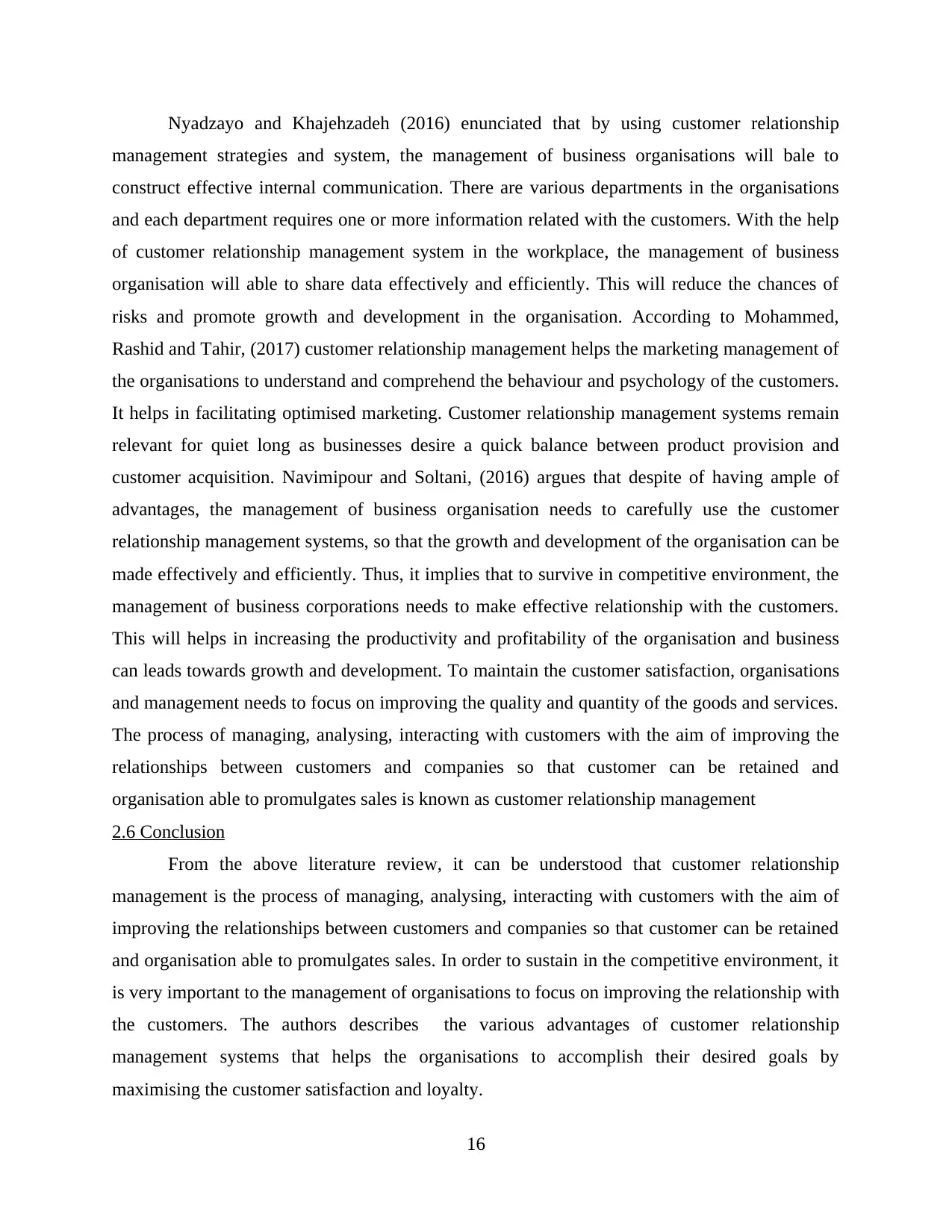
Nyadzayo and Khajehzadeh (2016) enunciated that by using customer relationship
management strategies and system, the management of business organisations will bale to
construct effective internal communication. There are various departments in the organisations
and each department requires one or more information related with the customers. With the help
of customer relationship management system in the workplace, the management of business
organisation will able to share data effectively and efficiently. This will reduce the chances of
risks and promote growth and development in the organisation. According to Mohammed,
Rashid and Tahir, (2017) customer relationship management helps the marketing management of
the organisations to understand and comprehend the behaviour and psychology of the customers.
It helps in facilitating optimised marketing. Customer relationship management systems remain
relevant for quiet long as businesses desire a quick balance between product provision and
customer acquisition. Navimipour and Soltani, (2016) argues that despite of having ample of
advantages, the management of business organisation needs to carefully use the customer
relationship management systems, so that the growth and development of the organisation can be
made effectively and efficiently. Thus, it implies that to survive in competitive environment, the
management of business corporations needs to make effective relationship with the customers.
This will helps in increasing the productivity and profitability of the organisation and business
can leads towards growth and development. To maintain the customer satisfaction, organisations
and management needs to focus on improving the quality and quantity of the goods and services.
The process of managing, analysing, interacting with customers with the aim of improving the
relationships between customers and companies so that customer can be retained and
organisation able to promulgates sales is known as customer relationship management
2.6 Conclusion
From the above literature review, it can be understood that customer relationship
management is the process of managing, analysing, interacting with customers with the aim of
improving the relationships between customers and companies so that customer can be retained
and organisation able to promulgates sales. In order to sustain in the competitive environment, it
is very important to the management of organisations to focus on improving the relationship with
the customers. The authors describes the various advantages of customer relationship
management systems that helps the organisations to accomplish their desired goals by
maximising the customer satisfaction and loyalty.
16
management strategies and system, the management of business organisations will bale to
construct effective internal communication. There are various departments in the organisations
and each department requires one or more information related with the customers. With the help
of customer relationship management system in the workplace, the management of business
organisation will able to share data effectively and efficiently. This will reduce the chances of
risks and promote growth and development in the organisation. According to Mohammed,
Rashid and Tahir, (2017) customer relationship management helps the marketing management of
the organisations to understand and comprehend the behaviour and psychology of the customers.
It helps in facilitating optimised marketing. Customer relationship management systems remain
relevant for quiet long as businesses desire a quick balance between product provision and
customer acquisition. Navimipour and Soltani, (2016) argues that despite of having ample of
advantages, the management of business organisation needs to carefully use the customer
relationship management systems, so that the growth and development of the organisation can be
made effectively and efficiently. Thus, it implies that to survive in competitive environment, the
management of business corporations needs to make effective relationship with the customers.
This will helps in increasing the productivity and profitability of the organisation and business
can leads towards growth and development. To maintain the customer satisfaction, organisations
and management needs to focus on improving the quality and quantity of the goods and services.
The process of managing, analysing, interacting with customers with the aim of improving the
relationships between customers and companies so that customer can be retained and
organisation able to promulgates sales is known as customer relationship management
2.6 Conclusion
From the above literature review, it can be understood that customer relationship
management is the process of managing, analysing, interacting with customers with the aim of
improving the relationships between customers and companies so that customer can be retained
and organisation able to promulgates sales. In order to sustain in the competitive environment, it
is very important to the management of organisations to focus on improving the relationship with
the customers. The authors describes the various advantages of customer relationship
management systems that helps the organisations to accomplish their desired goals by
maximising the customer satisfaction and loyalty.
16
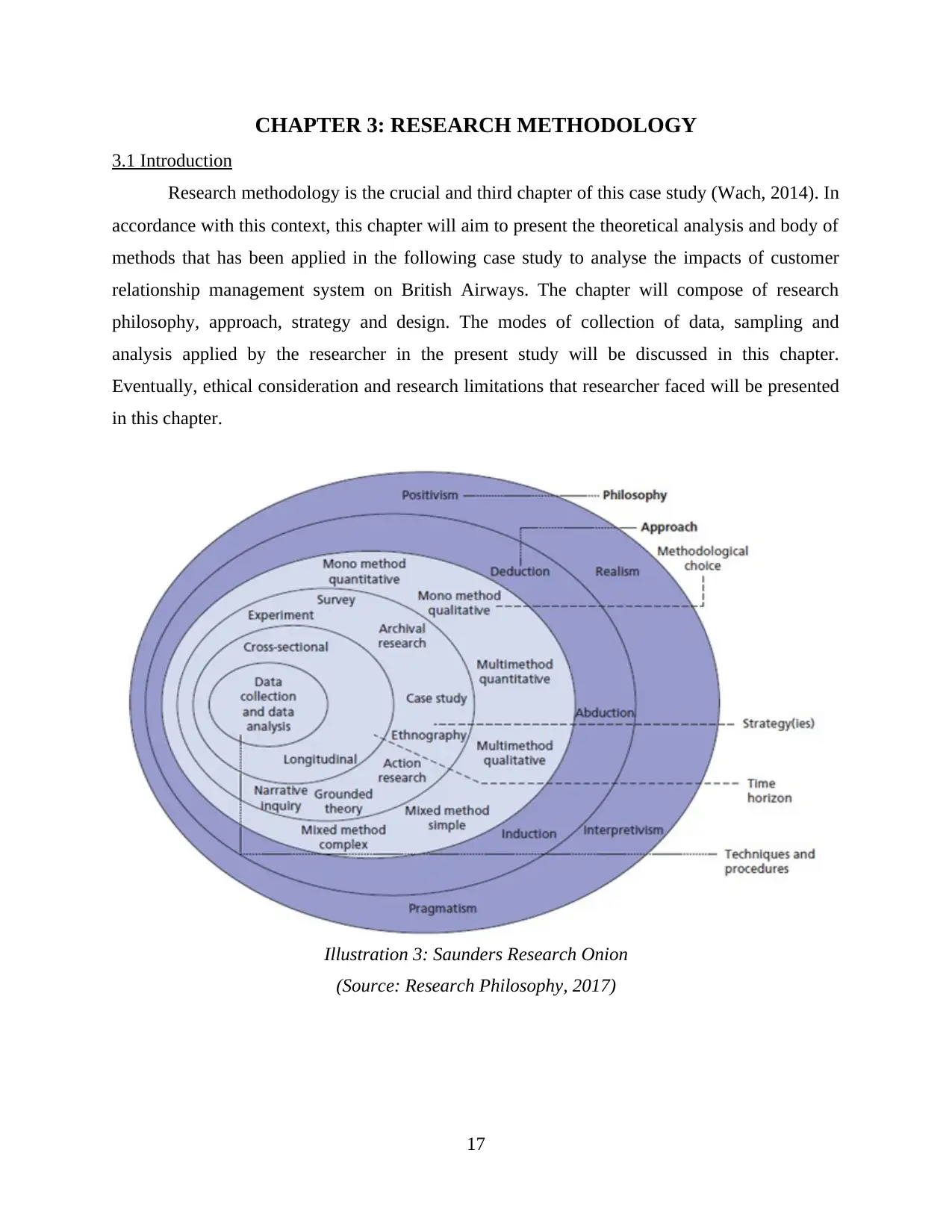
CHAPTER 3: RESEARCH METHODOLOGY
3.1 Introduction
Research methodology is the crucial and third chapter of this case study (Wach, 2014). In
accordance with this context, this chapter will aim to present the theoretical analysis and body of
methods that has been applied in the following case study to analyse the impacts of customer
relationship management system on British Airways. The chapter will compose of research
philosophy, approach, strategy and design. The modes of collection of data, sampling and
analysis applied by the researcher in the present study will be discussed in this chapter.
Eventually, ethical consideration and research limitations that researcher faced will be presented
in this chapter.
17
Illustration 3: Saunders Research Onion
(Source: Research Philosophy, 2017)
3.1 Introduction
Research methodology is the crucial and third chapter of this case study (Wach, 2014). In
accordance with this context, this chapter will aim to present the theoretical analysis and body of
methods that has been applied in the following case study to analyse the impacts of customer
relationship management system on British Airways. The chapter will compose of research
philosophy, approach, strategy and design. The modes of collection of data, sampling and
analysis applied by the researcher in the present study will be discussed in this chapter.
Eventually, ethical consideration and research limitations that researcher faced will be presented
in this chapter.
17
Illustration 3: Saunders Research Onion
(Source: Research Philosophy, 2017)
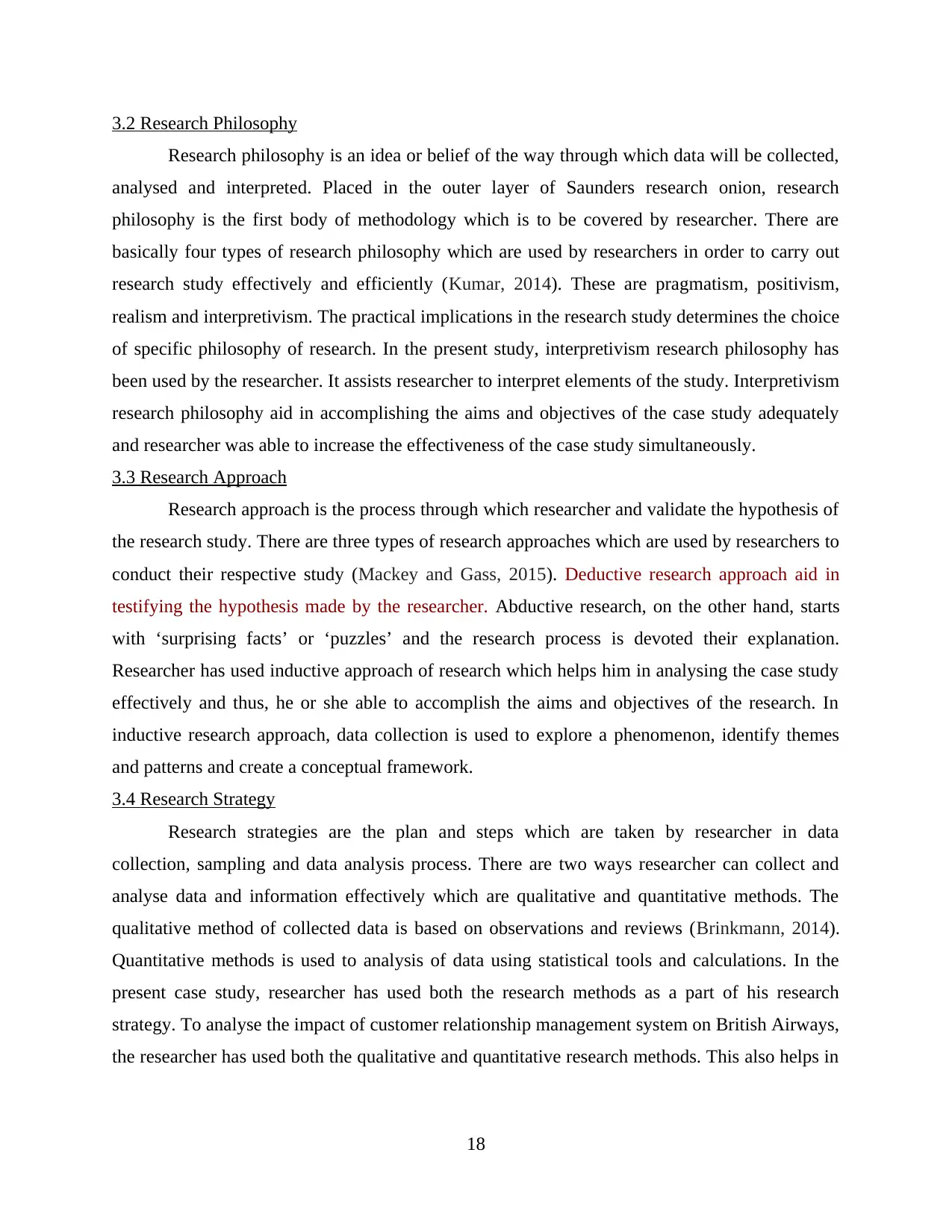
3.2 Research Philosophy
Research philosophy is an idea or belief of the way through which data will be collected,
analysed and interpreted. Placed in the outer layer of Saunders research onion, research
philosophy is the first body of methodology which is to be covered by researcher. There are
basically four types of research philosophy which are used by researchers in order to carry out
research study effectively and efficiently (Kumar, 2014). These are pragmatism, positivism,
realism and interpretivism. The practical implications in the research study determines the choice
of specific philosophy of research. In the present study, interpretivism research philosophy has
been used by the researcher. It assists researcher to interpret elements of the study. Interpretivism
research philosophy aid in accomplishing the aims and objectives of the case study adequately
and researcher was able to increase the effectiveness of the case study simultaneously.
3.3 Research Approach
Research approach is the process through which researcher and validate the hypothesis of
the research study. There are three types of research approaches which are used by researchers to
conduct their respective study (Mackey and Gass, 2015). Deductive research approach aid in
testifying the hypothesis made by the researcher. Abductive research, on the other hand, starts
with ‘surprising facts’ or ‘puzzles’ and the research process is devoted their explanation.
Researcher has used inductive approach of research which helps him in analysing the case study
effectively and thus, he or she able to accomplish the aims and objectives of the research. In
inductive research approach, data collection is used to explore a phenomenon, identify themes
and patterns and create a conceptual framework.
3.4 Research Strategy
Research strategies are the plan and steps which are taken by researcher in data
collection, sampling and data analysis process. There are two ways researcher can collect and
analyse data and information effectively which are qualitative and quantitative methods. The
qualitative method of collected data is based on observations and reviews (Brinkmann, 2014).
Quantitative methods is used to analysis of data using statistical tools and calculations. In the
present case study, researcher has used both the research methods as a part of his research
strategy. To analyse the impact of customer relationship management system on British Airways,
the researcher has used both the qualitative and quantitative research methods. This also helps in
18
Research philosophy is an idea or belief of the way through which data will be collected,
analysed and interpreted. Placed in the outer layer of Saunders research onion, research
philosophy is the first body of methodology which is to be covered by researcher. There are
basically four types of research philosophy which are used by researchers in order to carry out
research study effectively and efficiently (Kumar, 2014). These are pragmatism, positivism,
realism and interpretivism. The practical implications in the research study determines the choice
of specific philosophy of research. In the present study, interpretivism research philosophy has
been used by the researcher. It assists researcher to interpret elements of the study. Interpretivism
research philosophy aid in accomplishing the aims and objectives of the case study adequately
and researcher was able to increase the effectiveness of the case study simultaneously.
3.3 Research Approach
Research approach is the process through which researcher and validate the hypothesis of
the research study. There are three types of research approaches which are used by researchers to
conduct their respective study (Mackey and Gass, 2015). Deductive research approach aid in
testifying the hypothesis made by the researcher. Abductive research, on the other hand, starts
with ‘surprising facts’ or ‘puzzles’ and the research process is devoted their explanation.
Researcher has used inductive approach of research which helps him in analysing the case study
effectively and thus, he or she able to accomplish the aims and objectives of the research. In
inductive research approach, data collection is used to explore a phenomenon, identify themes
and patterns and create a conceptual framework.
3.4 Research Strategy
Research strategies are the plan and steps which are taken by researcher in data
collection, sampling and data analysis process. There are two ways researcher can collect and
analyse data and information effectively which are qualitative and quantitative methods. The
qualitative method of collected data is based on observations and reviews (Brinkmann, 2014).
Quantitative methods is used to analysis of data using statistical tools and calculations. In the
present case study, researcher has used both the research methods as a part of his research
strategy. To analyse the impact of customer relationship management system on British Airways,
the researcher has used both the qualitative and quantitative research methods. This also helps in
18
Secure Best Marks with AI Grader
Need help grading? Try our AI Grader for instant feedback on your assignments.
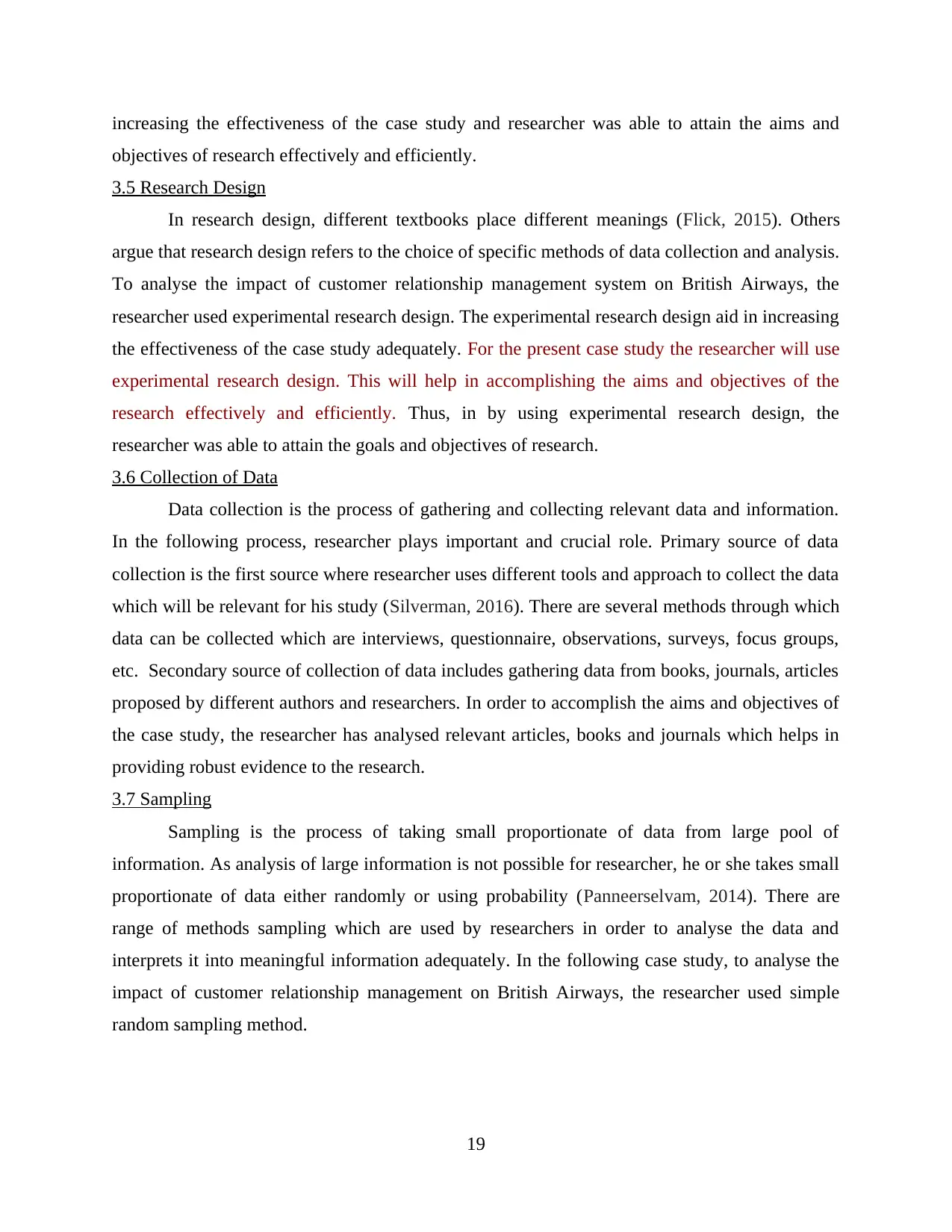
increasing the effectiveness of the case study and researcher was able to attain the aims and
objectives of research effectively and efficiently.
3.5 Research Design
In research design, different textbooks place different meanings (Flick, 2015). Others
argue that research design refers to the choice of specific methods of data collection and analysis.
To analyse the impact of customer relationship management system on British Airways, the
researcher used experimental research design. The experimental research design aid in increasing
the effectiveness of the case study adequately. For the present case study the researcher will use
experimental research design. This will help in accomplishing the aims and objectives of the
research effectively and efficiently. Thus, in by using experimental research design, the
researcher was able to attain the goals and objectives of research.
3.6 Collection of Data
Data collection is the process of gathering and collecting relevant data and information.
In the following process, researcher plays important and crucial role. Primary source of data
collection is the first source where researcher uses different tools and approach to collect the data
which will be relevant for his study (Silverman, 2016). There are several methods through which
data can be collected which are interviews, questionnaire, observations, surveys, focus groups,
etc. Secondary source of collection of data includes gathering data from books, journals, articles
proposed by different authors and researchers. In order to accomplish the aims and objectives of
the case study, the researcher has analysed relevant articles, books and journals which helps in
providing robust evidence to the research.
3.7 Sampling
Sampling is the process of taking small proportionate of data from large pool of
information. As analysis of large information is not possible for researcher, he or she takes small
proportionate of data either randomly or using probability (Panneerselvam, 2014). There are
range of methods sampling which are used by researchers in order to analyse the data and
interprets it into meaningful information adequately. In the following case study, to analyse the
impact of customer relationship management on British Airways, the researcher used simple
random sampling method.
19
objectives of research effectively and efficiently.
3.5 Research Design
In research design, different textbooks place different meanings (Flick, 2015). Others
argue that research design refers to the choice of specific methods of data collection and analysis.
To analyse the impact of customer relationship management system on British Airways, the
researcher used experimental research design. The experimental research design aid in increasing
the effectiveness of the case study adequately. For the present case study the researcher will use
experimental research design. This will help in accomplishing the aims and objectives of the
research effectively and efficiently. Thus, in by using experimental research design, the
researcher was able to attain the goals and objectives of research.
3.6 Collection of Data
Data collection is the process of gathering and collecting relevant data and information.
In the following process, researcher plays important and crucial role. Primary source of data
collection is the first source where researcher uses different tools and approach to collect the data
which will be relevant for his study (Silverman, 2016). There are several methods through which
data can be collected which are interviews, questionnaire, observations, surveys, focus groups,
etc. Secondary source of collection of data includes gathering data from books, journals, articles
proposed by different authors and researchers. In order to accomplish the aims and objectives of
the case study, the researcher has analysed relevant articles, books and journals which helps in
providing robust evidence to the research.
3.7 Sampling
Sampling is the process of taking small proportionate of data from large pool of
information. As analysis of large information is not possible for researcher, he or she takes small
proportionate of data either randomly or using probability (Panneerselvam, 2014). There are
range of methods sampling which are used by researchers in order to analyse the data and
interprets it into meaningful information adequately. In the following case study, to analyse the
impact of customer relationship management on British Airways, the researcher used simple
random sampling method.
19
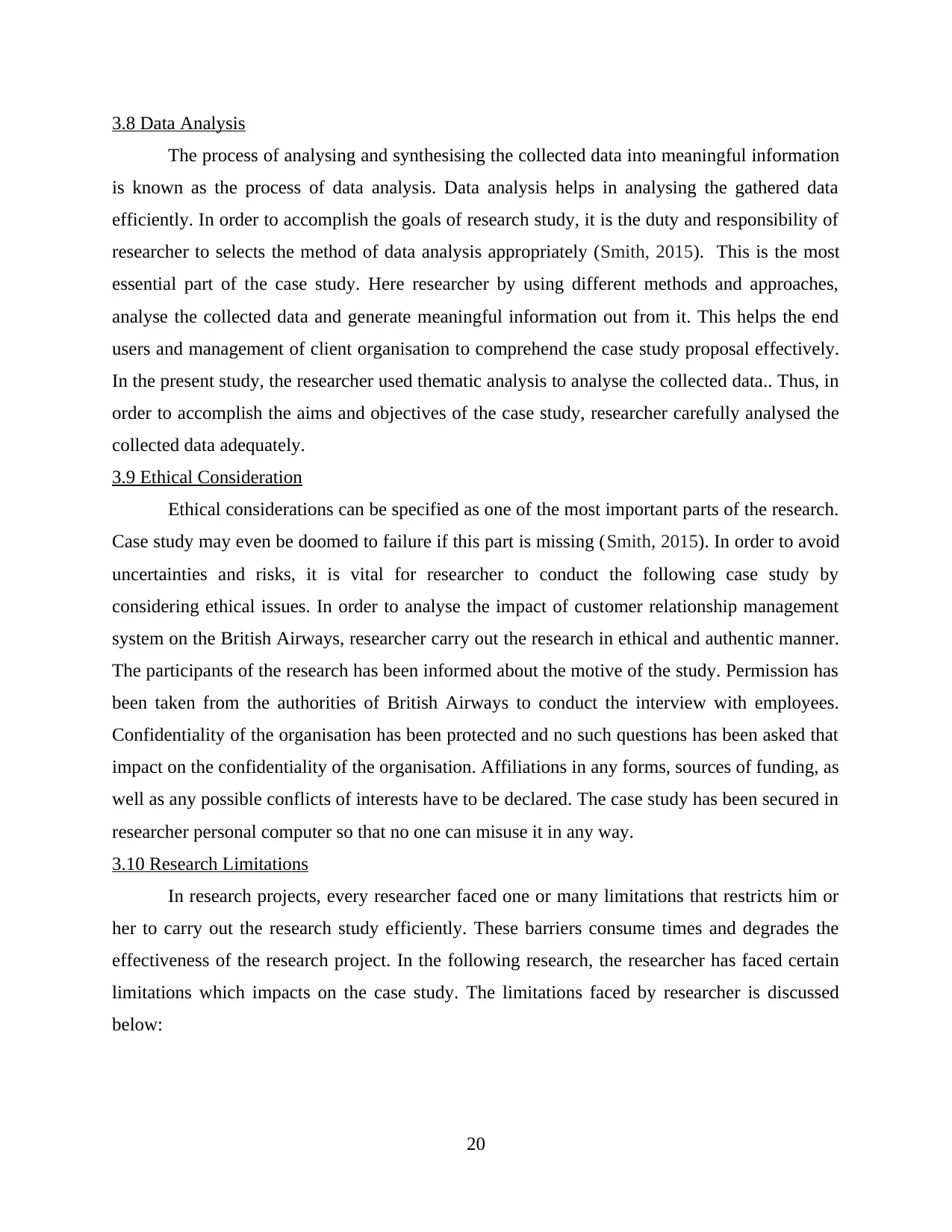
3.8 Data Analysis
The process of analysing and synthesising the collected data into meaningful information
is known as the process of data analysis. Data analysis helps in analysing the gathered data
efficiently. In order to accomplish the goals of research study, it is the duty and responsibility of
researcher to selects the method of data analysis appropriately (Smith, 2015). This is the most
essential part of the case study. Here researcher by using different methods and approaches,
analyse the collected data and generate meaningful information out from it. This helps the end
users and management of client organisation to comprehend the case study proposal effectively.
In the present study, the researcher used thematic analysis to analyse the collected data.. Thus, in
order to accomplish the aims and objectives of the case study, researcher carefully analysed the
collected data adequately.
3.9 Ethical Consideration
Ethical considerations can be specified as one of the most important parts of the research.
Case study may even be doomed to failure if this part is missing (Smith, 2015). In order to avoid
uncertainties and risks, it is vital for researcher to conduct the following case study by
considering ethical issues. In order to analyse the impact of customer relationship management
system on the British Airways, researcher carry out the research in ethical and authentic manner.
The participants of the research has been informed about the motive of the study. Permission has
been taken from the authorities of British Airways to conduct the interview with employees.
Confidentiality of the organisation has been protected and no such questions has been asked that
impact on the confidentiality of the organisation. Affiliations in any forms, sources of funding, as
well as any possible conflicts of interests have to be declared. The case study has been secured in
researcher personal computer so that no one can misuse it in any way.
3.10 Research Limitations
In research projects, every researcher faced one or many limitations that restricts him or
her to carry out the research study efficiently. These barriers consume times and degrades the
effectiveness of the research project. In the following research, the researcher has faced certain
limitations which impacts on the case study. The limitations faced by researcher is discussed
below:
20
The process of analysing and synthesising the collected data into meaningful information
is known as the process of data analysis. Data analysis helps in analysing the gathered data
efficiently. In order to accomplish the goals of research study, it is the duty and responsibility of
researcher to selects the method of data analysis appropriately (Smith, 2015). This is the most
essential part of the case study. Here researcher by using different methods and approaches,
analyse the collected data and generate meaningful information out from it. This helps the end
users and management of client organisation to comprehend the case study proposal effectively.
In the present study, the researcher used thematic analysis to analyse the collected data.. Thus, in
order to accomplish the aims and objectives of the case study, researcher carefully analysed the
collected data adequately.
3.9 Ethical Consideration
Ethical considerations can be specified as one of the most important parts of the research.
Case study may even be doomed to failure if this part is missing (Smith, 2015). In order to avoid
uncertainties and risks, it is vital for researcher to conduct the following case study by
considering ethical issues. In order to analyse the impact of customer relationship management
system on the British Airways, researcher carry out the research in ethical and authentic manner.
The participants of the research has been informed about the motive of the study. Permission has
been taken from the authorities of British Airways to conduct the interview with employees.
Confidentiality of the organisation has been protected and no such questions has been asked that
impact on the confidentiality of the organisation. Affiliations in any forms, sources of funding, as
well as any possible conflicts of interests have to be declared. The case study has been secured in
researcher personal computer so that no one can misuse it in any way.
3.10 Research Limitations
In research projects, every researcher faced one or many limitations that restricts him or
her to carry out the research study efficiently. These barriers consume times and degrades the
effectiveness of the research project. In the following research, the researcher has faced certain
limitations which impacts on the case study. The limitations faced by researcher is discussed
below:
20
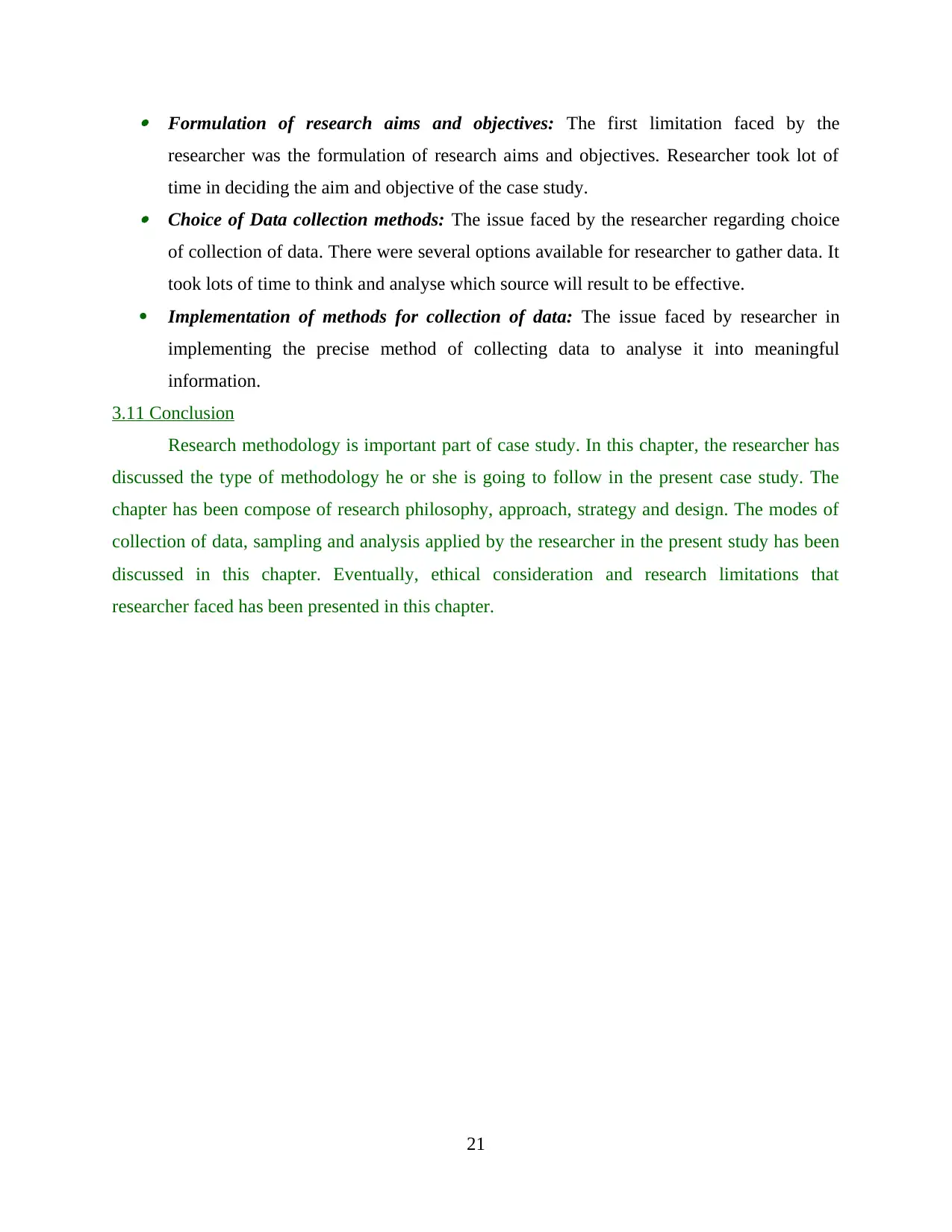
Formulation of research aims and objectives: The first limitation faced by the
researcher was the formulation of research aims and objectives. Researcher took lot of
time in deciding the aim and objective of the case study. Choice of Data collection methods: The issue faced by the researcher regarding choice
of collection of data. There were several options available for researcher to gather data. It
took lots of time to think and analyse which source will result to be effective.
Implementation of methods for collection of data: The issue faced by researcher in
implementing the precise method of collecting data to analyse it into meaningful
information.
3.11 Conclusion
Research methodology is important part of case study. In this chapter, the researcher has
discussed the type of methodology he or she is going to follow in the present case study. The
chapter has been compose of research philosophy, approach, strategy and design. The modes of
collection of data, sampling and analysis applied by the researcher in the present study has been
discussed in this chapter. Eventually, ethical consideration and research limitations that
researcher faced has been presented in this chapter.
21
researcher was the formulation of research aims and objectives. Researcher took lot of
time in deciding the aim and objective of the case study. Choice of Data collection methods: The issue faced by the researcher regarding choice
of collection of data. There were several options available for researcher to gather data. It
took lots of time to think and analyse which source will result to be effective.
Implementation of methods for collection of data: The issue faced by researcher in
implementing the precise method of collecting data to analyse it into meaningful
information.
3.11 Conclusion
Research methodology is important part of case study. In this chapter, the researcher has
discussed the type of methodology he or she is going to follow in the present case study. The
chapter has been compose of research philosophy, approach, strategy and design. The modes of
collection of data, sampling and analysis applied by the researcher in the present study has been
discussed in this chapter. Eventually, ethical consideration and research limitations that
researcher faced has been presented in this chapter.
21
Paraphrase This Document
Need a fresh take? Get an instant paraphrase of this document with our AI Paraphraser
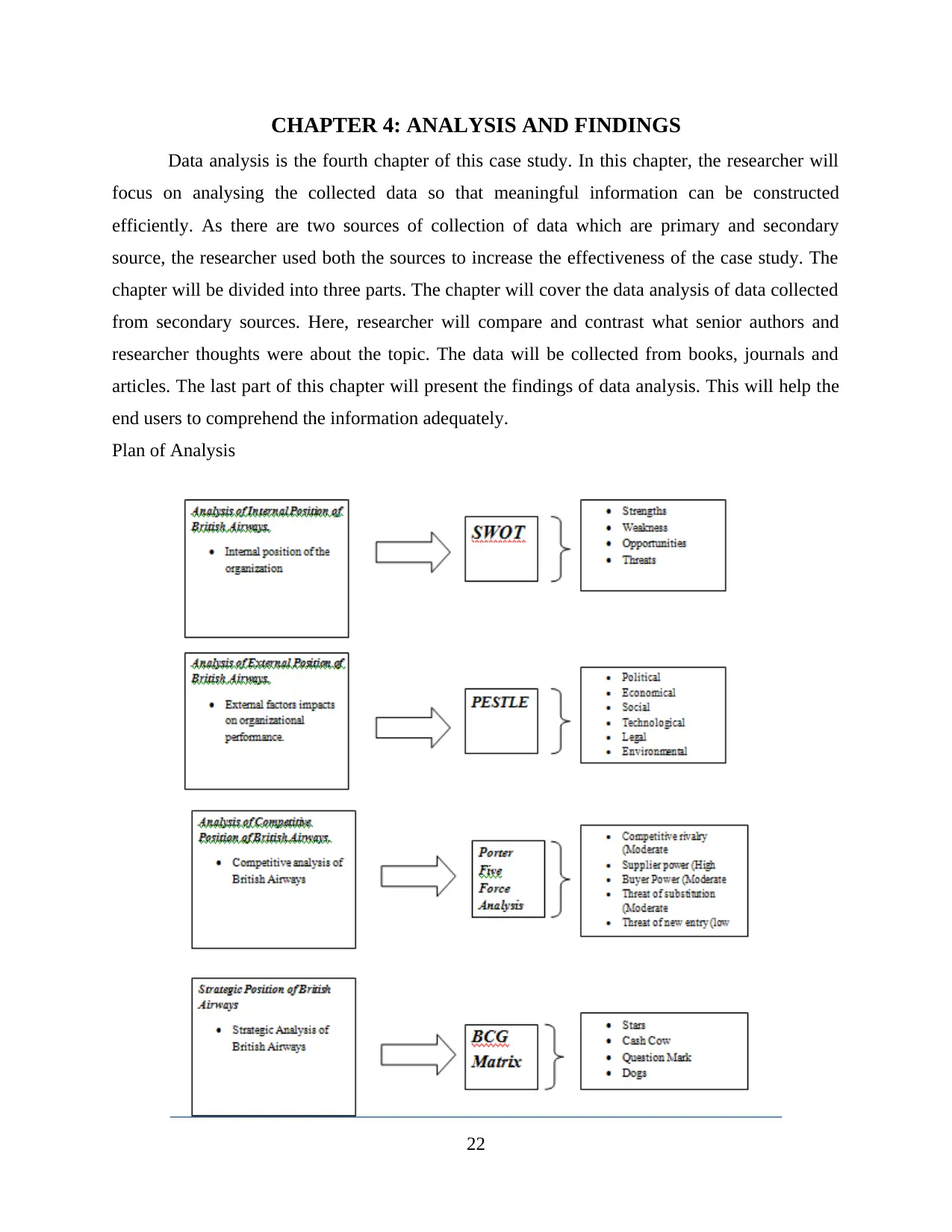
CHAPTER 4: ANALYSIS AND FINDINGS
Data analysis is the fourth chapter of this case study. In this chapter, the researcher will
focus on analysing the collected data so that meaningful information can be constructed
efficiently. As there are two sources of collection of data which are primary and secondary
source, the researcher used both the sources to increase the effectiveness of the case study. The
chapter will be divided into three parts. The chapter will cover the data analysis of data collected
from secondary sources. Here, researcher will compare and contrast what senior authors and
researcher thoughts were about the topic. The data will be collected from books, journals and
articles. The last part of this chapter will present the findings of data analysis. This will help the
end users to comprehend the information adequately.
Plan of Analysis
22
Data analysis is the fourth chapter of this case study. In this chapter, the researcher will
focus on analysing the collected data so that meaningful information can be constructed
efficiently. As there are two sources of collection of data which are primary and secondary
source, the researcher used both the sources to increase the effectiveness of the case study. The
chapter will be divided into three parts. The chapter will cover the data analysis of data collected
from secondary sources. Here, researcher will compare and contrast what senior authors and
researcher thoughts were about the topic. The data will be collected from books, journals and
articles. The last part of this chapter will present the findings of data analysis. This will help the
end users to comprehend the information adequately.
Plan of Analysis
22
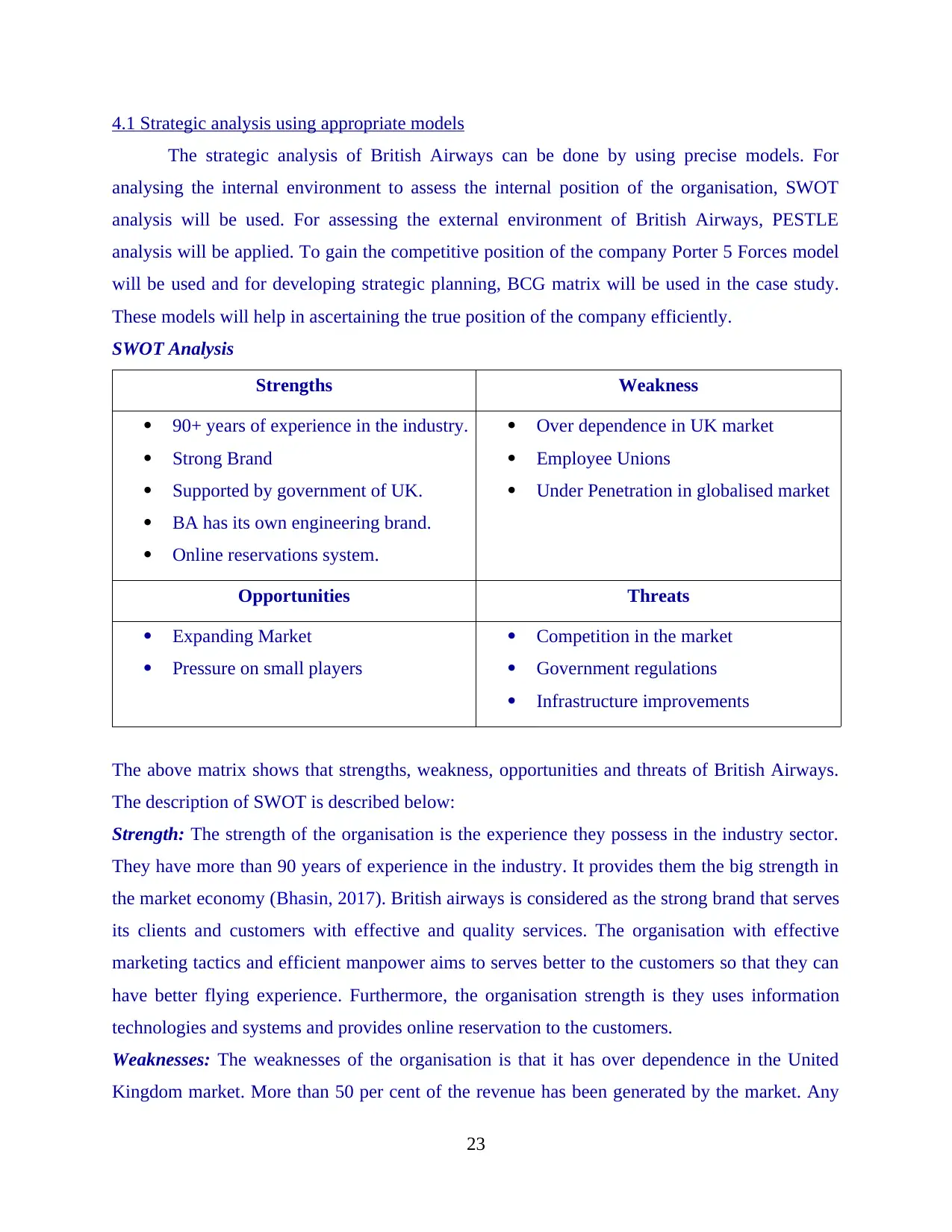
4.1 Strategic analysis using appropriate models
The strategic analysis of British Airways can be done by using precise models. For
analysing the internal environment to assess the internal position of the organisation, SWOT
analysis will be used. For assessing the external environment of British Airways, PESTLE
analysis will be applied. To gain the competitive position of the company Porter 5 Forces model
will be used and for developing strategic planning, BCG matrix will be used in the case study.
These models will help in ascertaining the true position of the company efficiently.
SWOT Analysis
Strengths Weakness
90+ years of experience in the industry.
Strong Brand
Supported by government of UK.
BA has its own engineering brand.
Online reservations system.
Over dependence in UK market
Employee Unions
Under Penetration in globalised market
Opportunities Threats
Expanding Market
Pressure on small players
Competition in the market
Government regulations
Infrastructure improvements
The above matrix shows that strengths, weakness, opportunities and threats of British Airways.
The description of SWOT is described below:
Strength: The strength of the organisation is the experience they possess in the industry sector.
They have more than 90 years of experience in the industry. It provides them the big strength in
the market economy (Bhasin, 2017). British airways is considered as the strong brand that serves
its clients and customers with effective and quality services. The organisation with effective
marketing tactics and efficient manpower aims to serves better to the customers so that they can
have better flying experience. Furthermore, the organisation strength is they uses information
technologies and systems and provides online reservation to the customers.
Weaknesses: The weaknesses of the organisation is that it has over dependence in the United
Kingdom market. More than 50 per cent of the revenue has been generated by the market. Any
23
The strategic analysis of British Airways can be done by using precise models. For
analysing the internal environment to assess the internal position of the organisation, SWOT
analysis will be used. For assessing the external environment of British Airways, PESTLE
analysis will be applied. To gain the competitive position of the company Porter 5 Forces model
will be used and for developing strategic planning, BCG matrix will be used in the case study.
These models will help in ascertaining the true position of the company efficiently.
SWOT Analysis
Strengths Weakness
90+ years of experience in the industry.
Strong Brand
Supported by government of UK.
BA has its own engineering brand.
Online reservations system.
Over dependence in UK market
Employee Unions
Under Penetration in globalised market
Opportunities Threats
Expanding Market
Pressure on small players
Competition in the market
Government regulations
Infrastructure improvements
The above matrix shows that strengths, weakness, opportunities and threats of British Airways.
The description of SWOT is described below:
Strength: The strength of the organisation is the experience they possess in the industry sector.
They have more than 90 years of experience in the industry. It provides them the big strength in
the market economy (Bhasin, 2017). British airways is considered as the strong brand that serves
its clients and customers with effective and quality services. The organisation with effective
marketing tactics and efficient manpower aims to serves better to the customers so that they can
have better flying experience. Furthermore, the organisation strength is they uses information
technologies and systems and provides online reservation to the customers.
Weaknesses: The weaknesses of the organisation is that it has over dependence in the United
Kingdom market. More than 50 per cent of the revenue has been generated by the market. Any
23
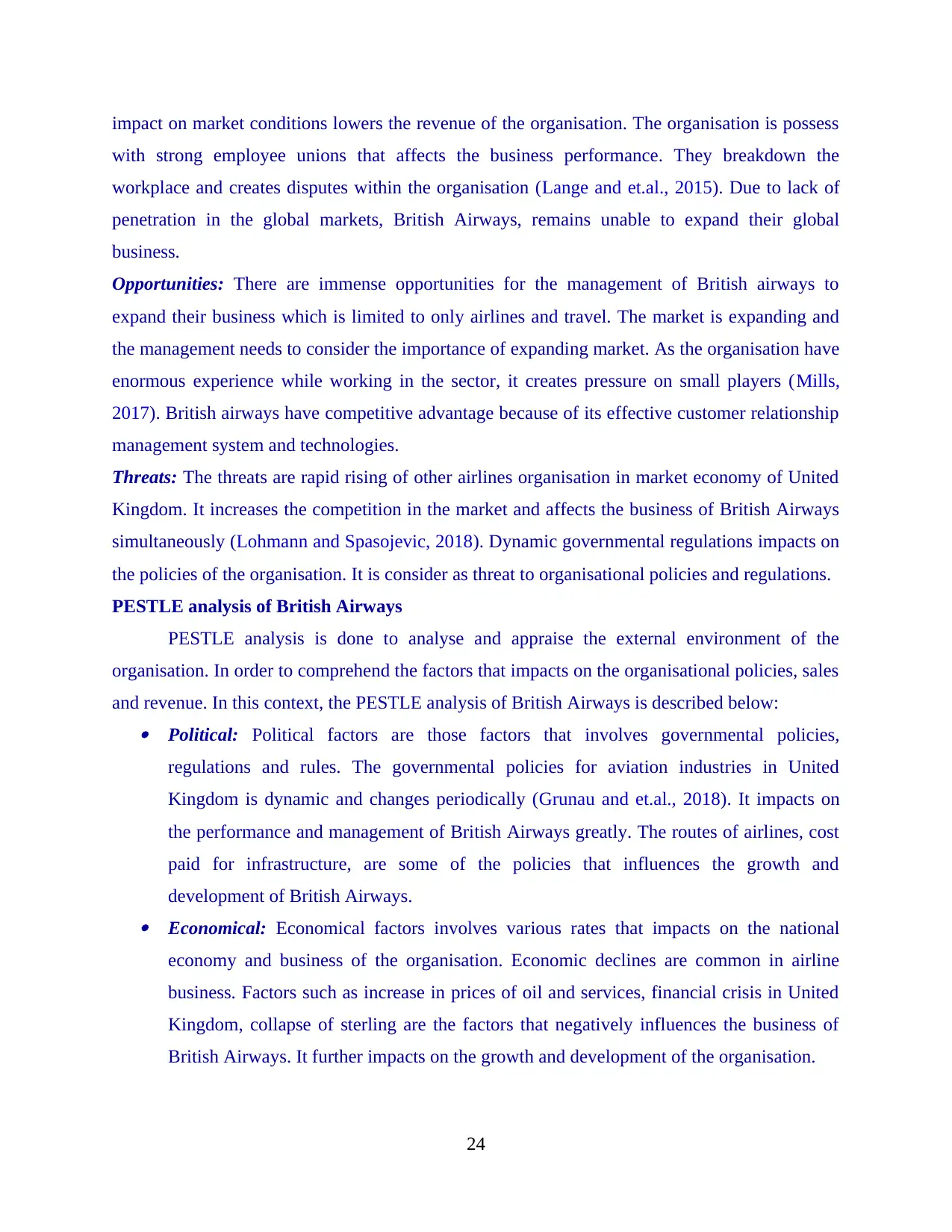
impact on market conditions lowers the revenue of the organisation. The organisation is possess
with strong employee unions that affects the business performance. They breakdown the
workplace and creates disputes within the organisation (Lange and et.al., 2015). Due to lack of
penetration in the global markets, British Airways, remains unable to expand their global
business.
Opportunities: There are immense opportunities for the management of British airways to
expand their business which is limited to only airlines and travel. The market is expanding and
the management needs to consider the importance of expanding market. As the organisation have
enormous experience while working in the sector, it creates pressure on small players (Mills,
2017). British airways have competitive advantage because of its effective customer relationship
management system and technologies.
Threats: The threats are rapid rising of other airlines organisation in market economy of United
Kingdom. It increases the competition in the market and affects the business of British Airways
simultaneously (Lohmann and Spasojevic, 2018). Dynamic governmental regulations impacts on
the policies of the organisation. It is consider as threat to organisational policies and regulations.
PESTLE analysis of British Airways
PESTLE analysis is done to analyse and appraise the external environment of the
organisation. In order to comprehend the factors that impacts on the organisational policies, sales
and revenue. In this context, the PESTLE analysis of British Airways is described below: Political: Political factors are those factors that involves governmental policies,
regulations and rules. The governmental policies for aviation industries in United
Kingdom is dynamic and changes periodically (Grunau and et.al., 2018). It impacts on
the performance and management of British Airways greatly. The routes of airlines, cost
paid for infrastructure, are some of the policies that influences the growth and
development of British Airways. Economical: Economical factors involves various rates that impacts on the national
economy and business of the organisation. Economic declines are common in airline
business. Factors such as increase in prices of oil and services, financial crisis in United
Kingdom, collapse of sterling are the factors that negatively influences the business of
British Airways. It further impacts on the growth and development of the organisation.
24
with strong employee unions that affects the business performance. They breakdown the
workplace and creates disputes within the organisation (Lange and et.al., 2015). Due to lack of
penetration in the global markets, British Airways, remains unable to expand their global
business.
Opportunities: There are immense opportunities for the management of British airways to
expand their business which is limited to only airlines and travel. The market is expanding and
the management needs to consider the importance of expanding market. As the organisation have
enormous experience while working in the sector, it creates pressure on small players (Mills,
2017). British airways have competitive advantage because of its effective customer relationship
management system and technologies.
Threats: The threats are rapid rising of other airlines organisation in market economy of United
Kingdom. It increases the competition in the market and affects the business of British Airways
simultaneously (Lohmann and Spasojevic, 2018). Dynamic governmental regulations impacts on
the policies of the organisation. It is consider as threat to organisational policies and regulations.
PESTLE analysis of British Airways
PESTLE analysis is done to analyse and appraise the external environment of the
organisation. In order to comprehend the factors that impacts on the organisational policies, sales
and revenue. In this context, the PESTLE analysis of British Airways is described below: Political: Political factors are those factors that involves governmental policies,
regulations and rules. The governmental policies for aviation industries in United
Kingdom is dynamic and changes periodically (Grunau and et.al., 2018). It impacts on
the performance and management of British Airways greatly. The routes of airlines, cost
paid for infrastructure, are some of the policies that influences the growth and
development of British Airways. Economical: Economical factors involves various rates that impacts on the national
economy and business of the organisation. Economic declines are common in airline
business. Factors such as increase in prices of oil and services, financial crisis in United
Kingdom, collapse of sterling are the factors that negatively influences the business of
British Airways. It further impacts on the growth and development of the organisation.
24
Secure Best Marks with AI Grader
Need help grading? Try our AI Grader for instant feedback on your assignments.

Social: Social factors involves the taste and preferences of society and consumers. People
and business travellers always seek for trusted airlines (Whyte and Lohmann, 2015). If
the organisation unable to provide them the quality services for what they have paid for,
they will unable to build trust with the customers and people will avoid these airlines.
Thus, in order to stand on the needs and expectations of customers, it is very important
for the management of British Airways to consider the needs and expectations of
customers. Technological: Technologies are rising rapidly and management needs to cope up with
advance technologies in order increase the customer satisfaction and loyalty. The
customer management relationship systems used in the organisation is effective enough
to generate the real time customer feedbacks and data to analyse their needs and
expectations. Legal: The airlines business is being controlled progressively. In order to sustain in the
competitive environment, the management of British Airways needs to follow all the
legal codes and legislation such Consumer Health and Safety act, etc. In this way ther
will be able to avoid legal consequence (Min and Joo, 2016).
Environmental: Pollution is the major concern and with the increase in airlines, pollution
in air, water and noise has been increases rapidly. It is the duty and responsibility of the
management to consider the importance of the issue and make preventive measures and
formulate precise strategies in order to protect the environment and its resources
efficiently.
Porter five forces
25
and business travellers always seek for trusted airlines (Whyte and Lohmann, 2015). If
the organisation unable to provide them the quality services for what they have paid for,
they will unable to build trust with the customers and people will avoid these airlines.
Thus, in order to stand on the needs and expectations of customers, it is very important
for the management of British Airways to consider the needs and expectations of
customers. Technological: Technologies are rising rapidly and management needs to cope up with
advance technologies in order increase the customer satisfaction and loyalty. The
customer management relationship systems used in the organisation is effective enough
to generate the real time customer feedbacks and data to analyse their needs and
expectations. Legal: The airlines business is being controlled progressively. In order to sustain in the
competitive environment, the management of British Airways needs to follow all the
legal codes and legislation such Consumer Health and Safety act, etc. In this way ther
will be able to avoid legal consequence (Min and Joo, 2016).
Environmental: Pollution is the major concern and with the increase in airlines, pollution
in air, water and noise has been increases rapidly. It is the duty and responsibility of the
management to consider the importance of the issue and make preventive measures and
formulate precise strategies in order to protect the environment and its resources
efficiently.
Porter five forces
25
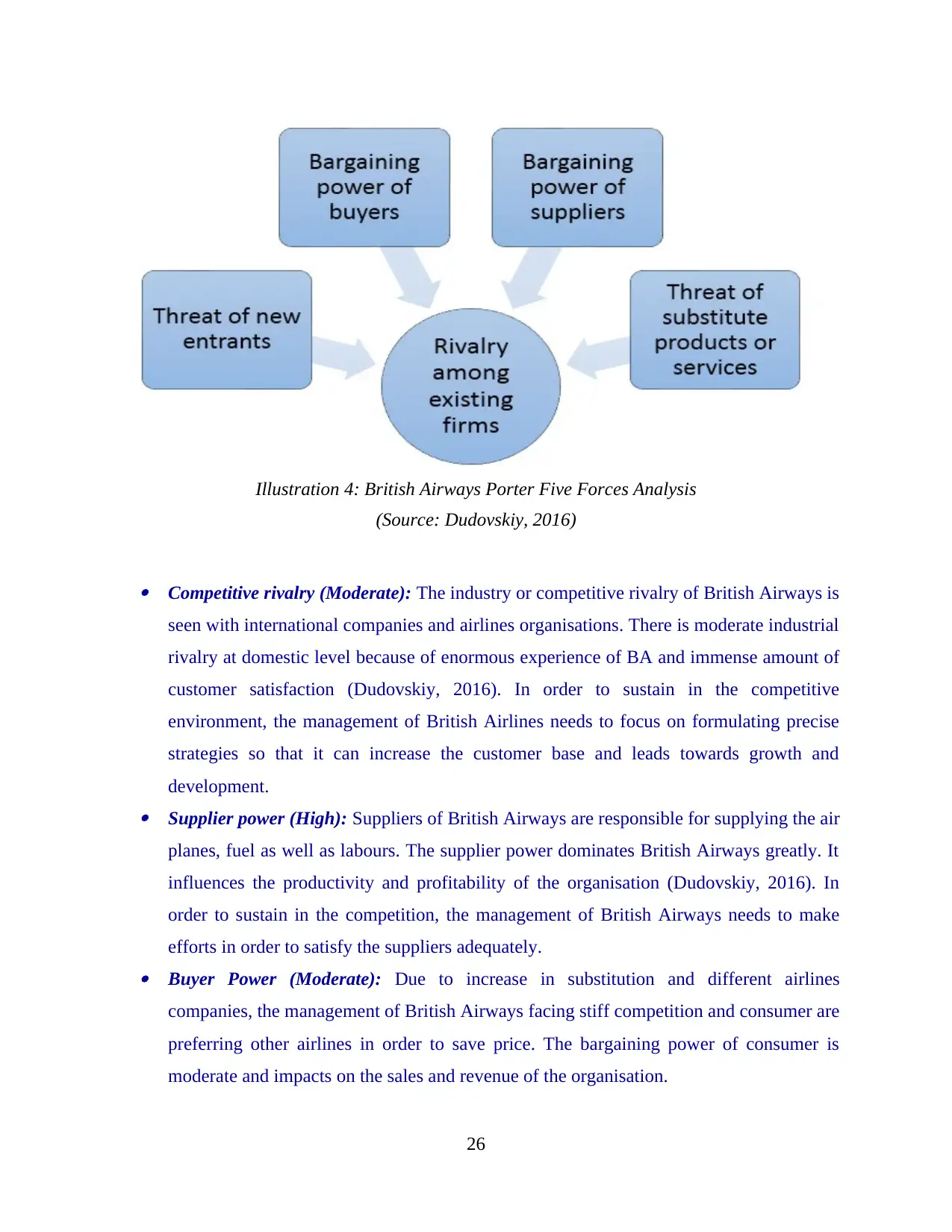
Competitive rivalry (Moderate): The industry or competitive rivalry of British Airways is
seen with international companies and airlines organisations. There is moderate industrial
rivalry at domestic level because of enormous experience of BA and immense amount of
customer satisfaction (Dudovskiy, 2016). In order to sustain in the competitive
environment, the management of British Airlines needs to focus on formulating precise
strategies so that it can increase the customer base and leads towards growth and
development. Supplier power (High): Suppliers of British Airways are responsible for supplying the air
planes, fuel as well as labours. The supplier power dominates British Airways greatly. It
influences the productivity and profitability of the organisation (Dudovskiy, 2016). In
order to sustain in the competition, the management of British Airways needs to make
efforts in order to satisfy the suppliers adequately. Buyer Power (Moderate): Due to increase in substitution and different airlines
companies, the management of British Airways facing stiff competition and consumer are
preferring other airlines in order to save price. The bargaining power of consumer is
moderate and impacts on the sales and revenue of the organisation.
26
Illustration 4: British Airways Porter Five Forces Analysis
(Source: Dudovskiy, 2016)
seen with international companies and airlines organisations. There is moderate industrial
rivalry at domestic level because of enormous experience of BA and immense amount of
customer satisfaction (Dudovskiy, 2016). In order to sustain in the competitive
environment, the management of British Airlines needs to focus on formulating precise
strategies so that it can increase the customer base and leads towards growth and
development. Supplier power (High): Suppliers of British Airways are responsible for supplying the air
planes, fuel as well as labours. The supplier power dominates British Airways greatly. It
influences the productivity and profitability of the organisation (Dudovskiy, 2016). In
order to sustain in the competition, the management of British Airways needs to make
efforts in order to satisfy the suppliers adequately. Buyer Power (Moderate): Due to increase in substitution and different airlines
companies, the management of British Airways facing stiff competition and consumer are
preferring other airlines in order to save price. The bargaining power of consumer is
moderate and impacts on the sales and revenue of the organisation.
26
Illustration 4: British Airways Porter Five Forces Analysis
(Source: Dudovskiy, 2016)
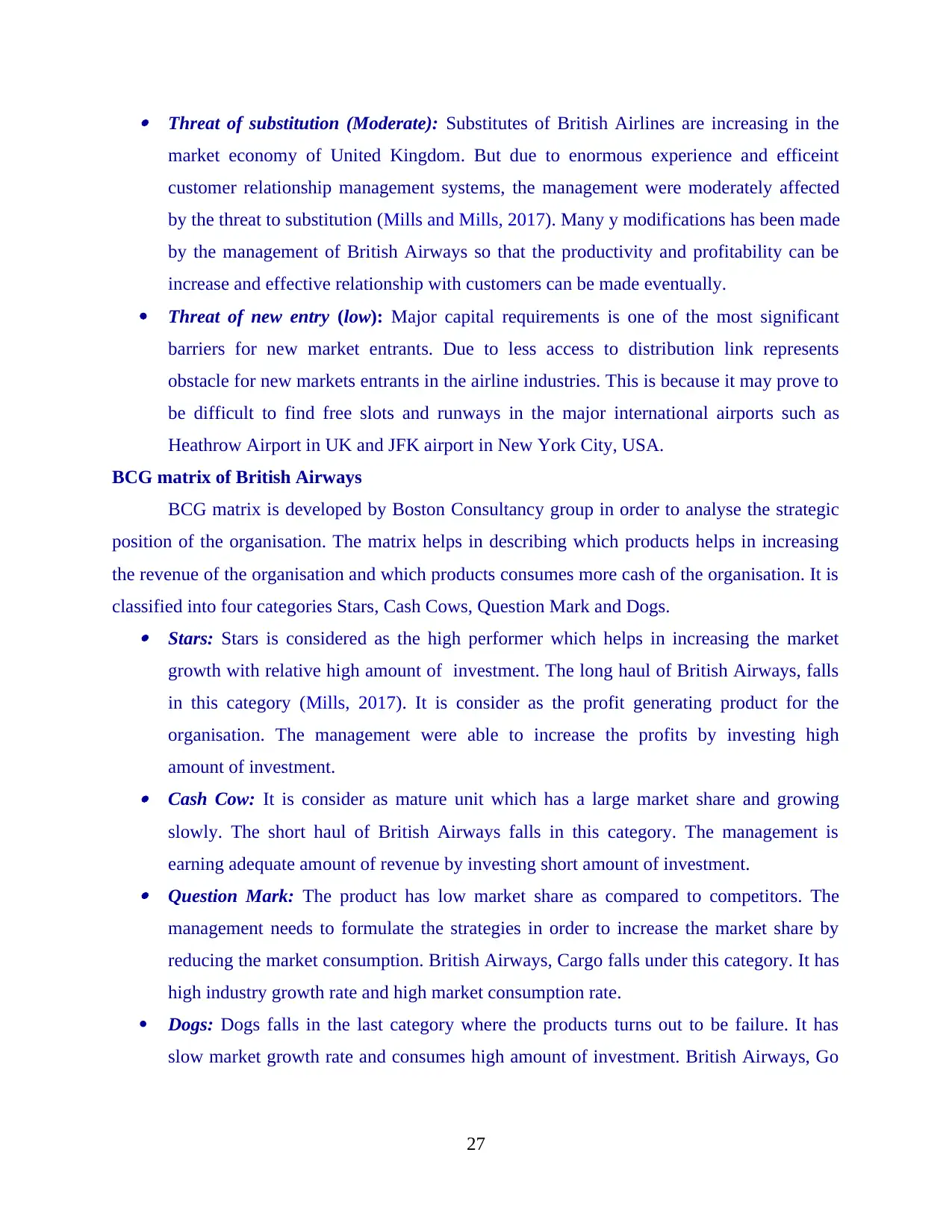
Threat of substitution (Moderate): Substitutes of British Airlines are increasing in the
market economy of United Kingdom. But due to enormous experience and efficeint
customer relationship management systems, the management were moderately affected
by the threat to substitution (Mills and Mills, 2017). Many y modifications has been made
by the management of British Airways so that the productivity and profitability can be
increase and effective relationship with customers can be made eventually.
Threat of new entry (low): Major capital requirements is one of the most significant
barriers for new market entrants. Due to less access to distribution link represents
obstacle for new markets entrants in the airline industries. This is because it may prove to
be difficult to find free slots and runways in the major international airports such as
Heathrow Airport in UK and JFK airport in New York City, USA.
BCG matrix of British Airways
BCG matrix is developed by Boston Consultancy group in order to analyse the strategic
position of the organisation. The matrix helps in describing which products helps in increasing
the revenue of the organisation and which products consumes more cash of the organisation. It is
classified into four categories Stars, Cash Cows, Question Mark and Dogs. Stars: Stars is considered as the high performer which helps in increasing the market
growth with relative high amount of investment. The long haul of British Airways, falls
in this category (Mills, 2017). It is consider as the profit generating product for the
organisation. The management were able to increase the profits by investing high
amount of investment. Cash Cow: It is consider as mature unit which has a large market share and growing
slowly. The short haul of British Airways falls in this category. The management is
earning adequate amount of revenue by investing short amount of investment. Question Mark: The product has low market share as compared to competitors. The
management needs to formulate the strategies in order to increase the market share by
reducing the market consumption. British Airways, Cargo falls under this category. It has
high industry growth rate and high market consumption rate.
Dogs: Dogs falls in the last category where the products turns out to be failure. It has
slow market growth rate and consumes high amount of investment. British Airways, Go
27
market economy of United Kingdom. But due to enormous experience and efficeint
customer relationship management systems, the management were moderately affected
by the threat to substitution (Mills and Mills, 2017). Many y modifications has been made
by the management of British Airways so that the productivity and profitability can be
increase and effective relationship with customers can be made eventually.
Threat of new entry (low): Major capital requirements is one of the most significant
barriers for new market entrants. Due to less access to distribution link represents
obstacle for new markets entrants in the airline industries. This is because it may prove to
be difficult to find free slots and runways in the major international airports such as
Heathrow Airport in UK and JFK airport in New York City, USA.
BCG matrix of British Airways
BCG matrix is developed by Boston Consultancy group in order to analyse the strategic
position of the organisation. The matrix helps in describing which products helps in increasing
the revenue of the organisation and which products consumes more cash of the organisation. It is
classified into four categories Stars, Cash Cows, Question Mark and Dogs. Stars: Stars is considered as the high performer which helps in increasing the market
growth with relative high amount of investment. The long haul of British Airways, falls
in this category (Mills, 2017). It is consider as the profit generating product for the
organisation. The management were able to increase the profits by investing high
amount of investment. Cash Cow: It is consider as mature unit which has a large market share and growing
slowly. The short haul of British Airways falls in this category. The management is
earning adequate amount of revenue by investing short amount of investment. Question Mark: The product has low market share as compared to competitors. The
management needs to formulate the strategies in order to increase the market share by
reducing the market consumption. British Airways, Cargo falls under this category. It has
high industry growth rate and high market consumption rate.
Dogs: Dogs falls in the last category where the products turns out to be failure. It has
slow market growth rate and consumes high amount of investment. British Airways, Go
27
Paraphrase This Document
Need a fresh take? Get an instant paraphrase of this document with our AI Paraphraser
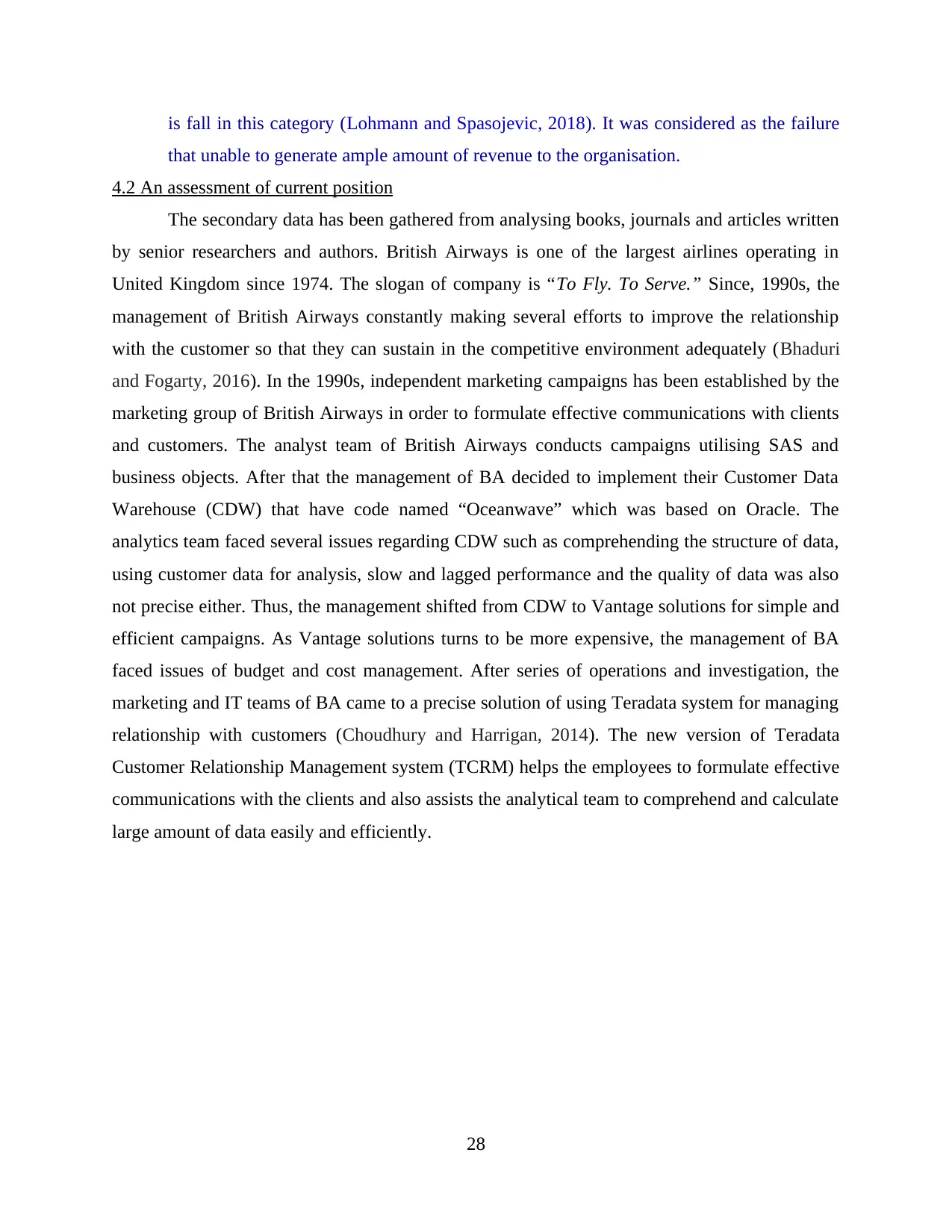
is fall in this category (Lohmann and Spasojevic, 2018). It was considered as the failure
that unable to generate ample amount of revenue to the organisation.
4.2 An assessment of current position
The secondary data has been gathered from analysing books, journals and articles written
by senior researchers and authors. British Airways is one of the largest airlines operating in
United Kingdom since 1974. The slogan of company is “To Fly. To Serve.” Since, 1990s, the
management of British Airways constantly making several efforts to improve the relationship
with the customer so that they can sustain in the competitive environment adequately (Bhaduri
and Fogarty, 2016). In the 1990s, independent marketing campaigns has been established by the
marketing group of British Airways in order to formulate effective communications with clients
and customers. The analyst team of British Airways conducts campaigns utilising SAS and
business objects. After that the management of BA decided to implement their Customer Data
Warehouse (CDW) that have code named “Oceanwave” which was based on Oracle. The
analytics team faced several issues regarding CDW such as comprehending the structure of data,
using customer data for analysis, slow and lagged performance and the quality of data was also
not precise either. Thus, the management shifted from CDW to Vantage solutions for simple and
efficient campaigns. As Vantage solutions turns to be more expensive, the management of BA
faced issues of budget and cost management. After series of operations and investigation, the
marketing and IT teams of BA came to a precise solution of using Teradata system for managing
relationship with customers (Choudhury and Harrigan, 2014). The new version of Teradata
Customer Relationship Management system (TCRM) helps the employees to formulate effective
communications with the clients and also assists the analytical team to comprehend and calculate
large amount of data easily and efficiently.
28
that unable to generate ample amount of revenue to the organisation.
4.2 An assessment of current position
The secondary data has been gathered from analysing books, journals and articles written
by senior researchers and authors. British Airways is one of the largest airlines operating in
United Kingdom since 1974. The slogan of company is “To Fly. To Serve.” Since, 1990s, the
management of British Airways constantly making several efforts to improve the relationship
with the customer so that they can sustain in the competitive environment adequately (Bhaduri
and Fogarty, 2016). In the 1990s, independent marketing campaigns has been established by the
marketing group of British Airways in order to formulate effective communications with clients
and customers. The analyst team of British Airways conducts campaigns utilising SAS and
business objects. After that the management of BA decided to implement their Customer Data
Warehouse (CDW) that have code named “Oceanwave” which was based on Oracle. The
analytics team faced several issues regarding CDW such as comprehending the structure of data,
using customer data for analysis, slow and lagged performance and the quality of data was also
not precise either. Thus, the management shifted from CDW to Vantage solutions for simple and
efficient campaigns. As Vantage solutions turns to be more expensive, the management of BA
faced issues of budget and cost management. After series of operations and investigation, the
marketing and IT teams of BA came to a precise solution of using Teradata system for managing
relationship with customers (Choudhury and Harrigan, 2014). The new version of Teradata
Customer Relationship Management system (TCRM) helps the employees to formulate effective
communications with the clients and also assists the analytical team to comprehend and calculate
large amount of data easily and efficiently.
28
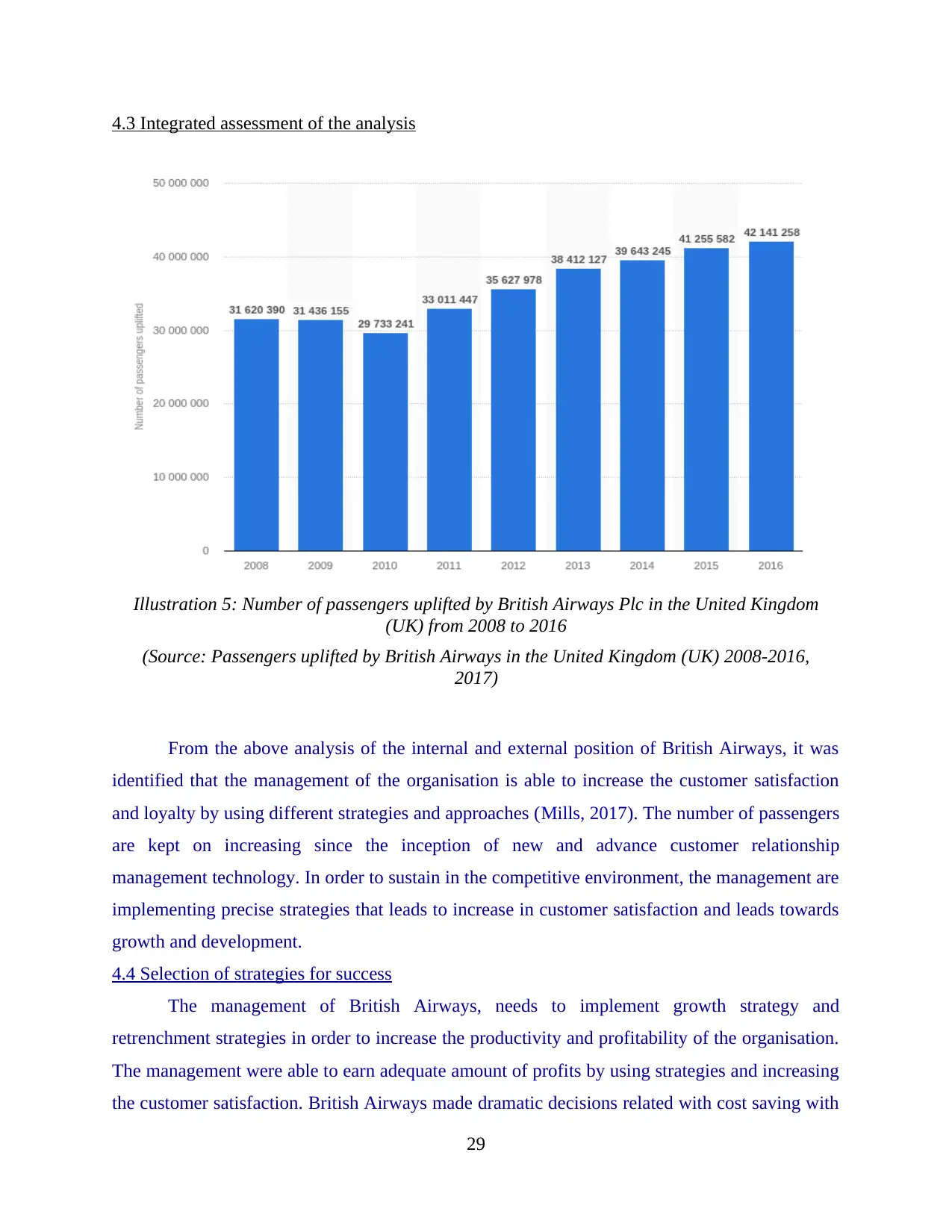
4.3 Integrated assessment of the analysis
From the above analysis of the internal and external position of British Airways, it was
identified that the management of the organisation is able to increase the customer satisfaction
and loyalty by using different strategies and approaches (Mills, 2017). The number of passengers
are kept on increasing since the inception of new and advance customer relationship
management technology. In order to sustain in the competitive environment, the management are
implementing precise strategies that leads to increase in customer satisfaction and leads towards
growth and development.
4.4 Selection of strategies for success
The management of British Airways, needs to implement growth strategy and
retrenchment strategies in order to increase the productivity and profitability of the organisation.
The management were able to earn adequate amount of profits by using strategies and increasing
the customer satisfaction. British Airways made dramatic decisions related with cost saving with
29
Illustration 5: Number of passengers uplifted by British Airways Plc in the United Kingdom
(UK) from 2008 to 2016
(Source: Passengers uplifted by British Airways in the United Kingdom (UK) 2008-2016,
2017)
From the above analysis of the internal and external position of British Airways, it was
identified that the management of the organisation is able to increase the customer satisfaction
and loyalty by using different strategies and approaches (Mills, 2017). The number of passengers
are kept on increasing since the inception of new and advance customer relationship
management technology. In order to sustain in the competitive environment, the management are
implementing precise strategies that leads to increase in customer satisfaction and leads towards
growth and development.
4.4 Selection of strategies for success
The management of British Airways, needs to implement growth strategy and
retrenchment strategies in order to increase the productivity and profitability of the organisation.
The management were able to earn adequate amount of profits by using strategies and increasing
the customer satisfaction. British Airways made dramatic decisions related with cost saving with
29
Illustration 5: Number of passengers uplifted by British Airways Plc in the United Kingdom
(UK) from 2008 to 2016
(Source: Passengers uplifted by British Airways in the United Kingdom (UK) 2008-2016,
2017)
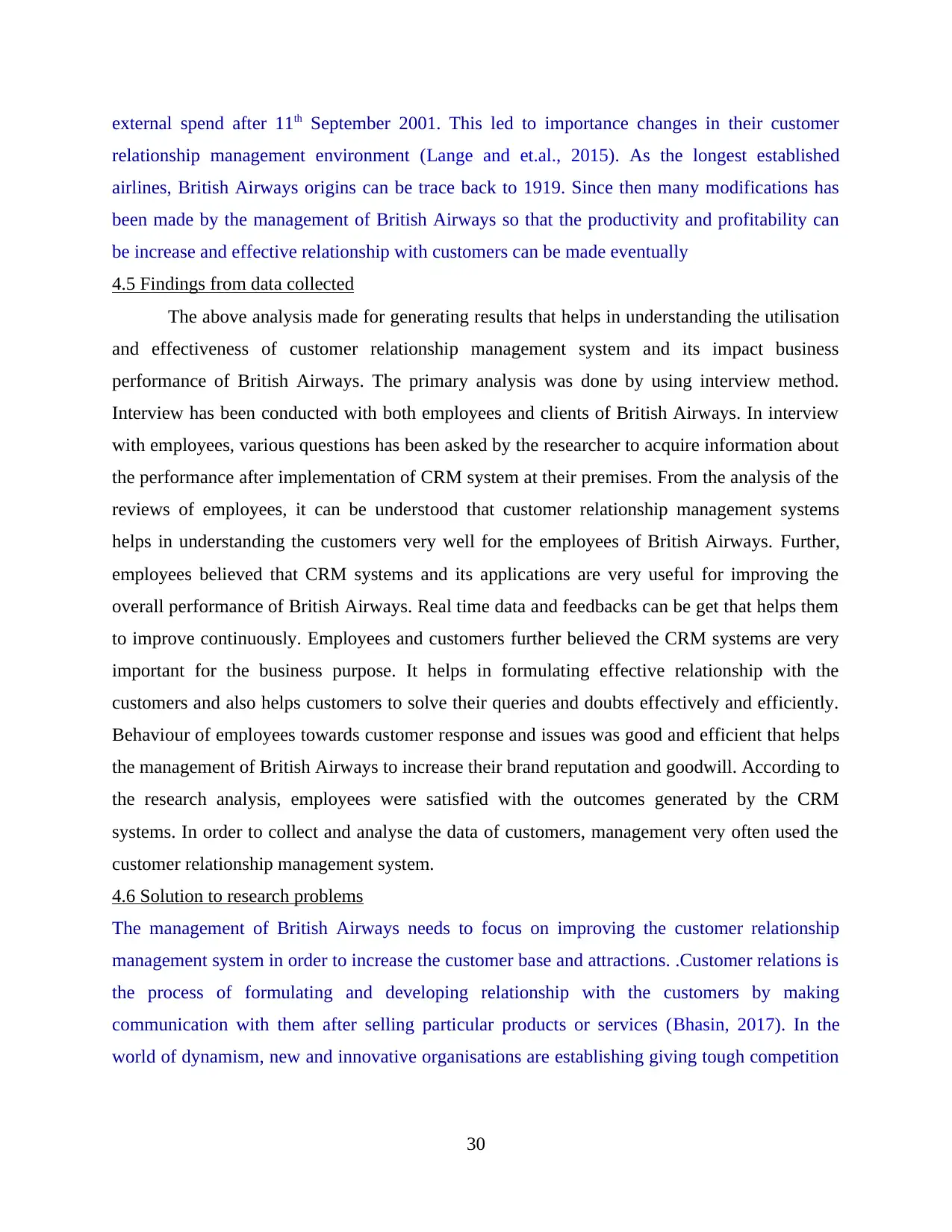
external spend after 11th September 2001. This led to importance changes in their customer
relationship management environment (Lange and et.al., 2015). As the longest established
airlines, British Airways origins can be trace back to 1919. Since then many modifications has
been made by the management of British Airways so that the productivity and profitability can
be increase and effective relationship with customers can be made eventually
4.5 Findings from data collected
The above analysis made for generating results that helps in understanding the utilisation
and effectiveness of customer relationship management system and its impact business
performance of British Airways. The primary analysis was done by using interview method.
Interview has been conducted with both employees and clients of British Airways. In interview
with employees, various questions has been asked by the researcher to acquire information about
the performance after implementation of CRM system at their premises. From the analysis of the
reviews of employees, it can be understood that customer relationship management systems
helps in understanding the customers very well for the employees of British Airways. Further,
employees believed that CRM systems and its applications are very useful for improving the
overall performance of British Airways. Real time data and feedbacks can be get that helps them
to improve continuously. Employees and customers further believed the CRM systems are very
important for the business purpose. It helps in formulating effective relationship with the
customers and also helps customers to solve their queries and doubts effectively and efficiently.
Behaviour of employees towards customer response and issues was good and efficient that helps
the management of British Airways to increase their brand reputation and goodwill. According to
the research analysis, employees were satisfied with the outcomes generated by the CRM
systems. In order to collect and analyse the data of customers, management very often used the
customer relationship management system.
4.6 Solution to research problems
The management of British Airways needs to focus on improving the customer relationship
management system in order to increase the customer base and attractions. .Customer relations is
the process of formulating and developing relationship with the customers by making
communication with them after selling particular products or services (Bhasin, 2017). In the
world of dynamism, new and innovative organisations are establishing giving tough competition
30
relationship management environment (Lange and et.al., 2015). As the longest established
airlines, British Airways origins can be trace back to 1919. Since then many modifications has
been made by the management of British Airways so that the productivity and profitability can
be increase and effective relationship with customers can be made eventually
4.5 Findings from data collected
The above analysis made for generating results that helps in understanding the utilisation
and effectiveness of customer relationship management system and its impact business
performance of British Airways. The primary analysis was done by using interview method.
Interview has been conducted with both employees and clients of British Airways. In interview
with employees, various questions has been asked by the researcher to acquire information about
the performance after implementation of CRM system at their premises. From the analysis of the
reviews of employees, it can be understood that customer relationship management systems
helps in understanding the customers very well for the employees of British Airways. Further,
employees believed that CRM systems and its applications are very useful for improving the
overall performance of British Airways. Real time data and feedbacks can be get that helps them
to improve continuously. Employees and customers further believed the CRM systems are very
important for the business purpose. It helps in formulating effective relationship with the
customers and also helps customers to solve their queries and doubts effectively and efficiently.
Behaviour of employees towards customer response and issues was good and efficient that helps
the management of British Airways to increase their brand reputation and goodwill. According to
the research analysis, employees were satisfied with the outcomes generated by the CRM
systems. In order to collect and analyse the data of customers, management very often used the
customer relationship management system.
4.6 Solution to research problems
The management of British Airways needs to focus on improving the customer relationship
management system in order to increase the customer base and attractions. .Customer relations is
the process of formulating and developing relationship with the customers by making
communication with them after selling particular products or services (Bhasin, 2017). In the
world of dynamism, new and innovative organisations are establishing giving tough competition
30
Secure Best Marks with AI Grader
Need help grading? Try our AI Grader for instant feedback on your assignments.
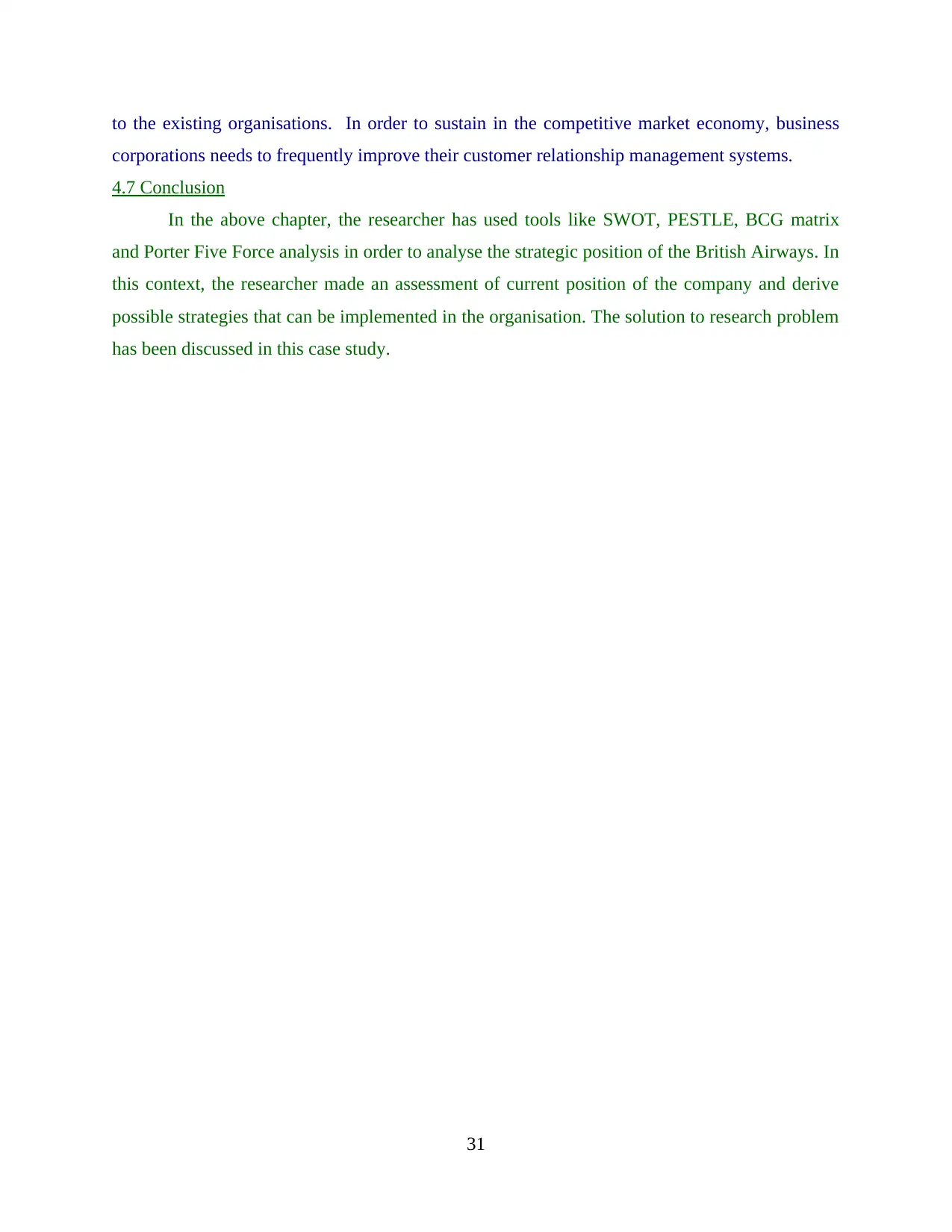
to the existing organisations. In order to sustain in the competitive market economy, business
corporations needs to frequently improve their customer relationship management systems.
4.7 Conclusion
In the above chapter, the researcher has used tools like SWOT, PESTLE, BCG matrix
and Porter Five Force analysis in order to analyse the strategic position of the British Airways. In
this context, the researcher made an assessment of current position of the company and derive
possible strategies that can be implemented in the organisation. The solution to research problem
has been discussed in this case study.
31
corporations needs to frequently improve their customer relationship management systems.
4.7 Conclusion
In the above chapter, the researcher has used tools like SWOT, PESTLE, BCG matrix
and Porter Five Force analysis in order to analyse the strategic position of the British Airways. In
this context, the researcher made an assessment of current position of the company and derive
possible strategies that can be implemented in the organisation. The solution to research problem
has been discussed in this case study.
31
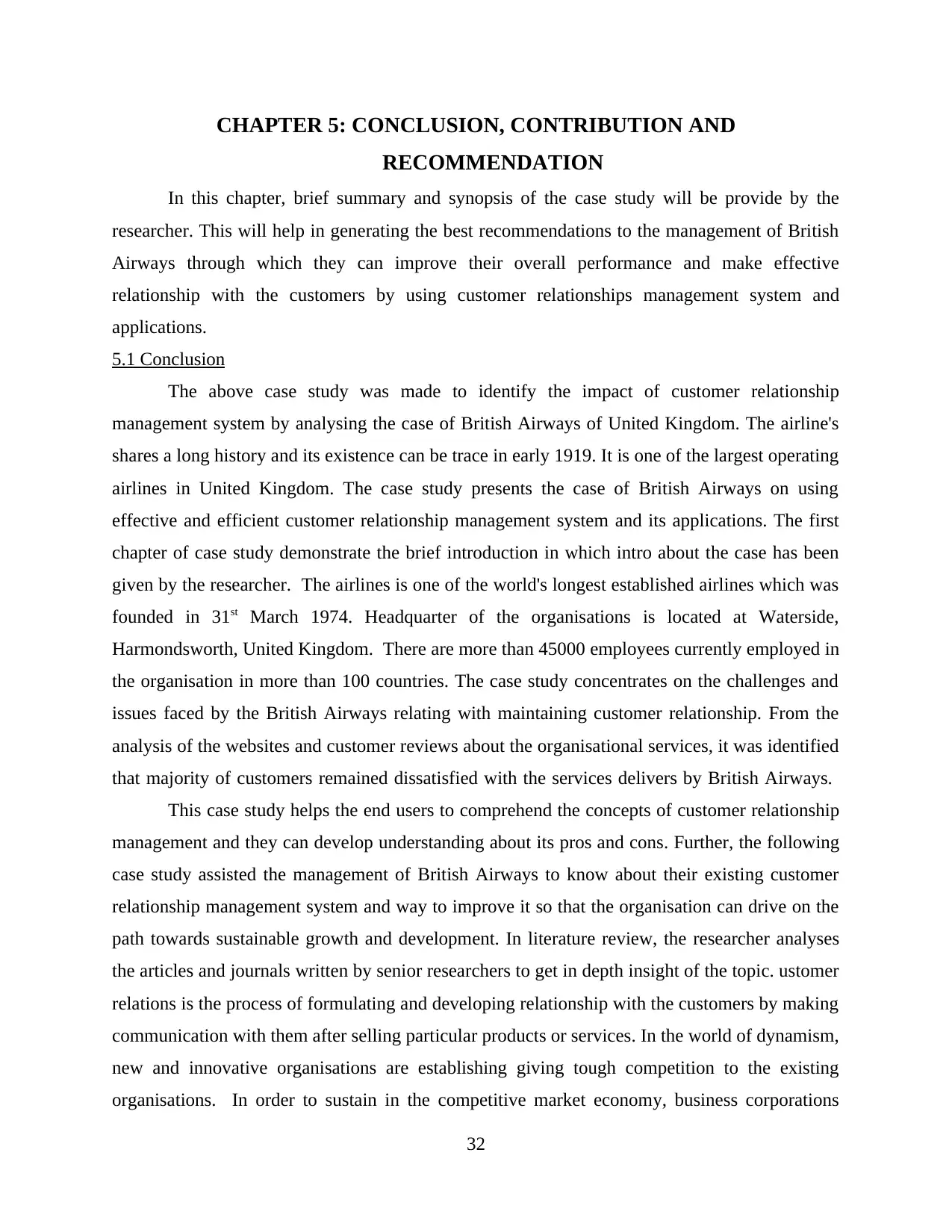
CHAPTER 5: CONCLUSION, CONTRIBUTION AND
RECOMMENDATION
In this chapter, brief summary and synopsis of the case study will be provide by the
researcher. This will help in generating the best recommendations to the management of British
Airways through which they can improve their overall performance and make effective
relationship with the customers by using customer relationships management system and
applications.
5.1 Conclusion
The above case study was made to identify the impact of customer relationship
management system by analysing the case of British Airways of United Kingdom. The airline's
shares a long history and its existence can be trace in early 1919. It is one of the largest operating
airlines in United Kingdom. The case study presents the case of British Airways on using
effective and efficient customer relationship management system and its applications. The first
chapter of case study demonstrate the brief introduction in which intro about the case has been
given by the researcher. The airlines is one of the world's longest established airlines which was
founded in 31st March 1974. Headquarter of the organisations is located at Waterside,
Harmondsworth, United Kingdom. There are more than 45000 employees currently employed in
the organisation in more than 100 countries. The case study concentrates on the challenges and
issues faced by the British Airways relating with maintaining customer relationship. From the
analysis of the websites and customer reviews about the organisational services, it was identified
that majority of customers remained dissatisfied with the services delivers by British Airways.
This case study helps the end users to comprehend the concepts of customer relationship
management and they can develop understanding about its pros and cons. Further, the following
case study assisted the management of British Airways to know about their existing customer
relationship management system and way to improve it so that the organisation can drive on the
path towards sustainable growth and development. In literature review, the researcher analyses
the articles and journals written by senior researchers to get in depth insight of the topic. ustomer
relations is the process of formulating and developing relationship with the customers by making
communication with them after selling particular products or services. In the world of dynamism,
new and innovative organisations are establishing giving tough competition to the existing
organisations. In order to sustain in the competitive market economy, business corporations
32
RECOMMENDATION
In this chapter, brief summary and synopsis of the case study will be provide by the
researcher. This will help in generating the best recommendations to the management of British
Airways through which they can improve their overall performance and make effective
relationship with the customers by using customer relationships management system and
applications.
5.1 Conclusion
The above case study was made to identify the impact of customer relationship
management system by analysing the case of British Airways of United Kingdom. The airline's
shares a long history and its existence can be trace in early 1919. It is one of the largest operating
airlines in United Kingdom. The case study presents the case of British Airways on using
effective and efficient customer relationship management system and its applications. The first
chapter of case study demonstrate the brief introduction in which intro about the case has been
given by the researcher. The airlines is one of the world's longest established airlines which was
founded in 31st March 1974. Headquarter of the organisations is located at Waterside,
Harmondsworth, United Kingdom. There are more than 45000 employees currently employed in
the organisation in more than 100 countries. The case study concentrates on the challenges and
issues faced by the British Airways relating with maintaining customer relationship. From the
analysis of the websites and customer reviews about the organisational services, it was identified
that majority of customers remained dissatisfied with the services delivers by British Airways.
This case study helps the end users to comprehend the concepts of customer relationship
management and they can develop understanding about its pros and cons. Further, the following
case study assisted the management of British Airways to know about their existing customer
relationship management system and way to improve it so that the organisation can drive on the
path towards sustainable growth and development. In literature review, the researcher analyses
the articles and journals written by senior researchers to get in depth insight of the topic. ustomer
relations is the process of formulating and developing relationship with the customers by making
communication with them after selling particular products or services. In the world of dynamism,
new and innovative organisations are establishing giving tough competition to the existing
organisations. In order to sustain in the competitive market economy, business corporations
32
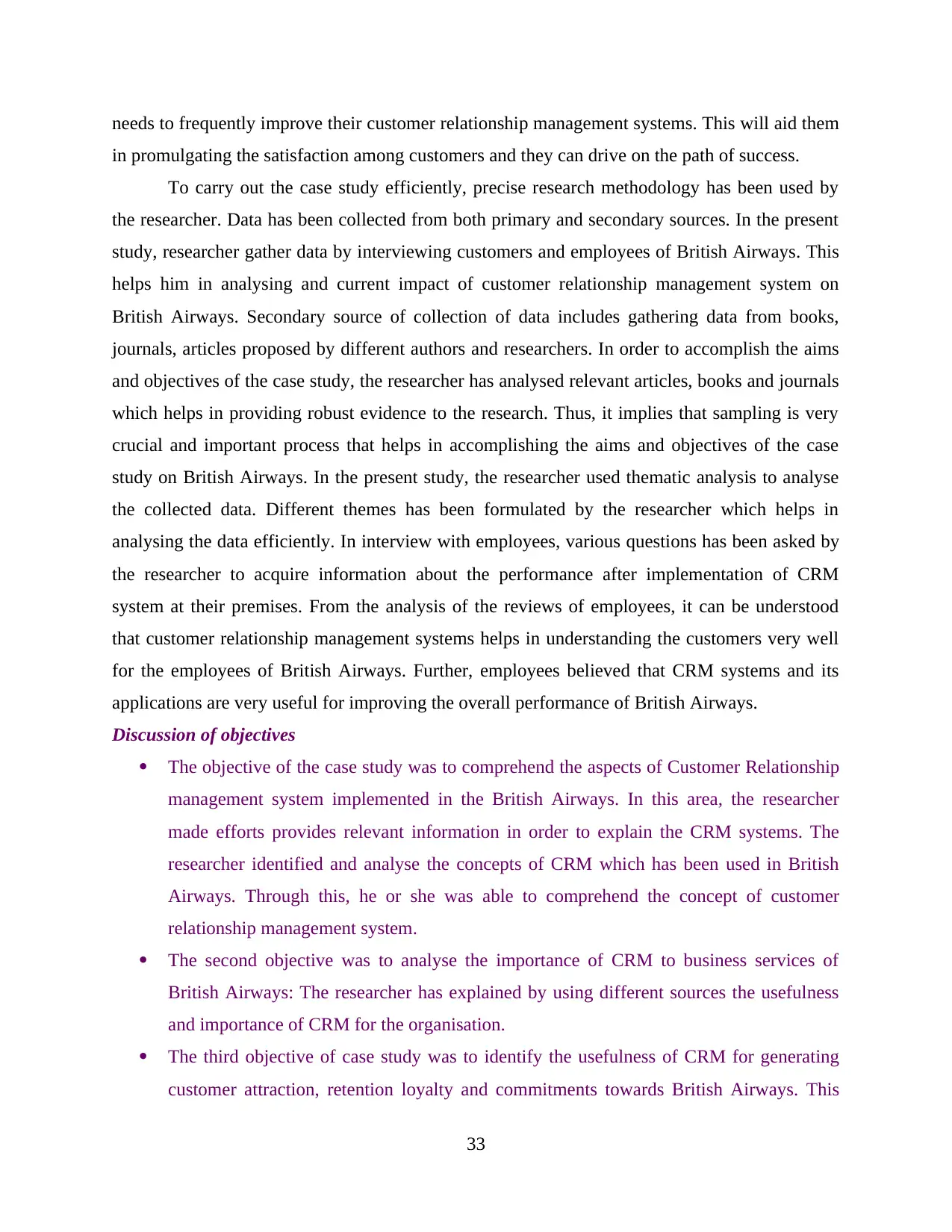
needs to frequently improve their customer relationship management systems. This will aid them
in promulgating the satisfaction among customers and they can drive on the path of success.
To carry out the case study efficiently, precise research methodology has been used by
the researcher. Data has been collected from both primary and secondary sources. In the present
study, researcher gather data by interviewing customers and employees of British Airways. This
helps him in analysing and current impact of customer relationship management system on
British Airways. Secondary source of collection of data includes gathering data from books,
journals, articles proposed by different authors and researchers. In order to accomplish the aims
and objectives of the case study, the researcher has analysed relevant articles, books and journals
which helps in providing robust evidence to the research. Thus, it implies that sampling is very
crucial and important process that helps in accomplishing the aims and objectives of the case
study on British Airways. In the present study, the researcher used thematic analysis to analyse
the collected data. Different themes has been formulated by the researcher which helps in
analysing the data efficiently. In interview with employees, various questions has been asked by
the researcher to acquire information about the performance after implementation of CRM
system at their premises. From the analysis of the reviews of employees, it can be understood
that customer relationship management systems helps in understanding the customers very well
for the employees of British Airways. Further, employees believed that CRM systems and its
applications are very useful for improving the overall performance of British Airways.
Discussion of objectives
The objective of the case study was to comprehend the aspects of Customer Relationship
management system implemented in the British Airways. In this area, the researcher
made efforts provides relevant information in order to explain the CRM systems. The
researcher identified and analyse the concepts of CRM which has been used in British
Airways. Through this, he or she was able to comprehend the concept of customer
relationship management system.
The second objective was to analyse the importance of CRM to business services of
British Airways: The researcher has explained by using different sources the usefulness
and importance of CRM for the organisation.
The third objective of case study was to identify the usefulness of CRM for generating
customer attraction, retention loyalty and commitments towards British Airways. This
33
in promulgating the satisfaction among customers and they can drive on the path of success.
To carry out the case study efficiently, precise research methodology has been used by
the researcher. Data has been collected from both primary and secondary sources. In the present
study, researcher gather data by interviewing customers and employees of British Airways. This
helps him in analysing and current impact of customer relationship management system on
British Airways. Secondary source of collection of data includes gathering data from books,
journals, articles proposed by different authors and researchers. In order to accomplish the aims
and objectives of the case study, the researcher has analysed relevant articles, books and journals
which helps in providing robust evidence to the research. Thus, it implies that sampling is very
crucial and important process that helps in accomplishing the aims and objectives of the case
study on British Airways. In the present study, the researcher used thematic analysis to analyse
the collected data. Different themes has been formulated by the researcher which helps in
analysing the data efficiently. In interview with employees, various questions has been asked by
the researcher to acquire information about the performance after implementation of CRM
system at their premises. From the analysis of the reviews of employees, it can be understood
that customer relationship management systems helps in understanding the customers very well
for the employees of British Airways. Further, employees believed that CRM systems and its
applications are very useful for improving the overall performance of British Airways.
Discussion of objectives
The objective of the case study was to comprehend the aspects of Customer Relationship
management system implemented in the British Airways. In this area, the researcher
made efforts provides relevant information in order to explain the CRM systems. The
researcher identified and analyse the concepts of CRM which has been used in British
Airways. Through this, he or she was able to comprehend the concept of customer
relationship management system.
The second objective was to analyse the importance of CRM to business services of
British Airways: The researcher has explained by using different sources the usefulness
and importance of CRM for the organisation.
The third objective of case study was to identify the usefulness of CRM for generating
customer attraction, retention loyalty and commitments towards British Airways. This
33
Paraphrase This Document
Need a fresh take? Get an instant paraphrase of this document with our AI Paraphraser
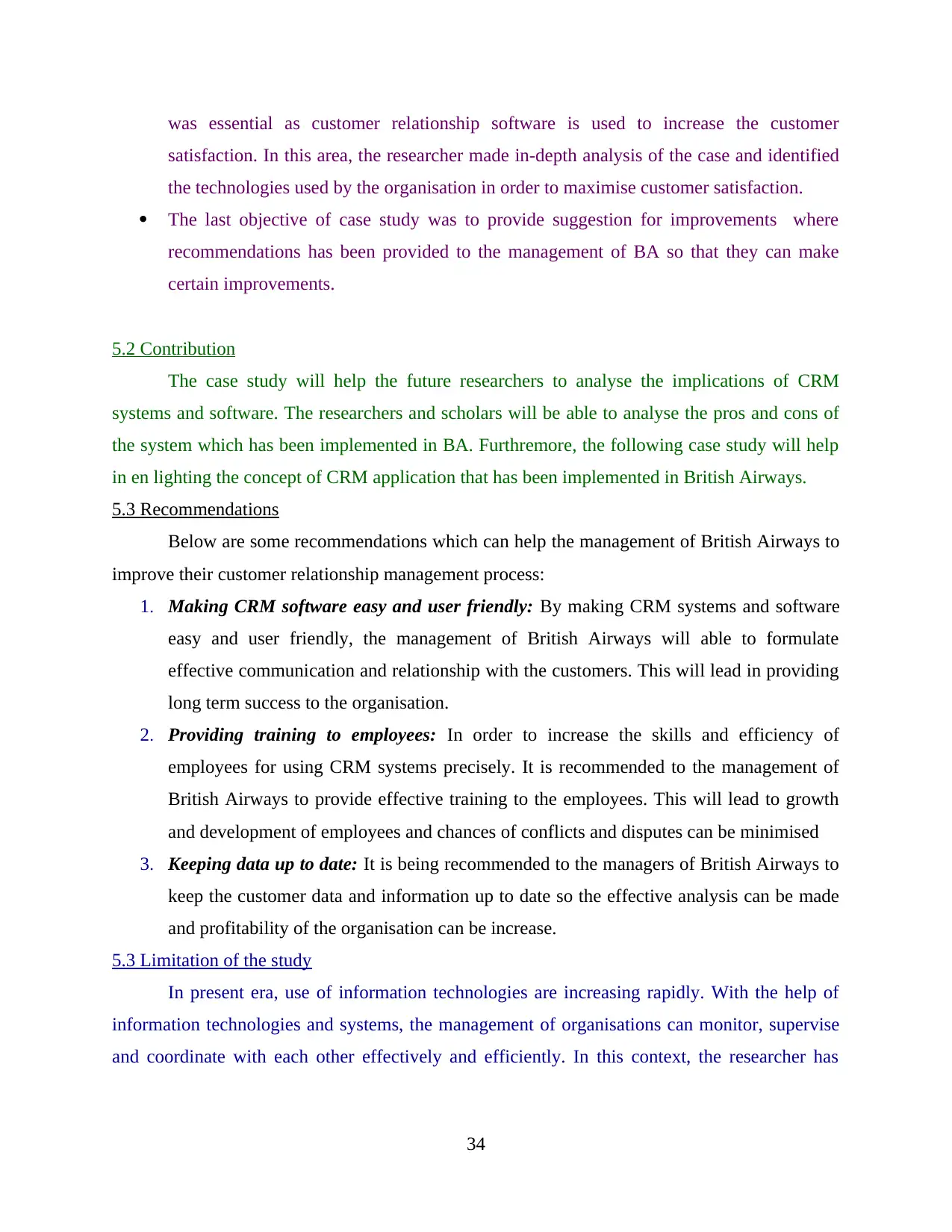
was essential as customer relationship software is used to increase the customer
satisfaction. In this area, the researcher made in-depth analysis of the case and identified
the technologies used by the organisation in order to maximise customer satisfaction.
The last objective of case study was to provide suggestion for improvements where
recommendations has been provided to the management of BA so that they can make
certain improvements.
5.2 Contribution
The case study will help the future researchers to analyse the implications of CRM
systems and software. The researchers and scholars will be able to analyse the pros and cons of
the system which has been implemented in BA. Furthremore, the following case study will help
in en lighting the concept of CRM application that has been implemented in British Airways.
5.3 Recommendations
Below are some recommendations which can help the management of British Airways to
improve their customer relationship management process:
1. Making CRM software easy and user friendly: By making CRM systems and software
easy and user friendly, the management of British Airways will able to formulate
effective communication and relationship with the customers. This will lead in providing
long term success to the organisation.
2. Providing training to employees: In order to increase the skills and efficiency of
employees for using CRM systems precisely. It is recommended to the management of
British Airways to provide effective training to the employees. This will lead to growth
and development of employees and chances of conflicts and disputes can be minimised
3. Keeping data up to date: It is being recommended to the managers of British Airways to
keep the customer data and information up to date so the effective analysis can be made
and profitability of the organisation can be increase.
5.3 Limitation of the study
In present era, use of information technologies are increasing rapidly. With the help of
information technologies and systems, the management of organisations can monitor, supervise
and coordinate with each other effectively and efficiently. In this context, the researcher has
34
satisfaction. In this area, the researcher made in-depth analysis of the case and identified
the technologies used by the organisation in order to maximise customer satisfaction.
The last objective of case study was to provide suggestion for improvements where
recommendations has been provided to the management of BA so that they can make
certain improvements.
5.2 Contribution
The case study will help the future researchers to analyse the implications of CRM
systems and software. The researchers and scholars will be able to analyse the pros and cons of
the system which has been implemented in BA. Furthremore, the following case study will help
in en lighting the concept of CRM application that has been implemented in British Airways.
5.3 Recommendations
Below are some recommendations which can help the management of British Airways to
improve their customer relationship management process:
1. Making CRM software easy and user friendly: By making CRM systems and software
easy and user friendly, the management of British Airways will able to formulate
effective communication and relationship with the customers. This will lead in providing
long term success to the organisation.
2. Providing training to employees: In order to increase the skills and efficiency of
employees for using CRM systems precisely. It is recommended to the management of
British Airways to provide effective training to the employees. This will lead to growth
and development of employees and chances of conflicts and disputes can be minimised
3. Keeping data up to date: It is being recommended to the managers of British Airways to
keep the customer data and information up to date so the effective analysis can be made
and profitability of the organisation can be increase.
5.3 Limitation of the study
In present era, use of information technologies are increasing rapidly. With the help of
information technologies and systems, the management of organisations can monitor, supervise
and coordinate with each other effectively and efficiently. In this context, the researcher has
34
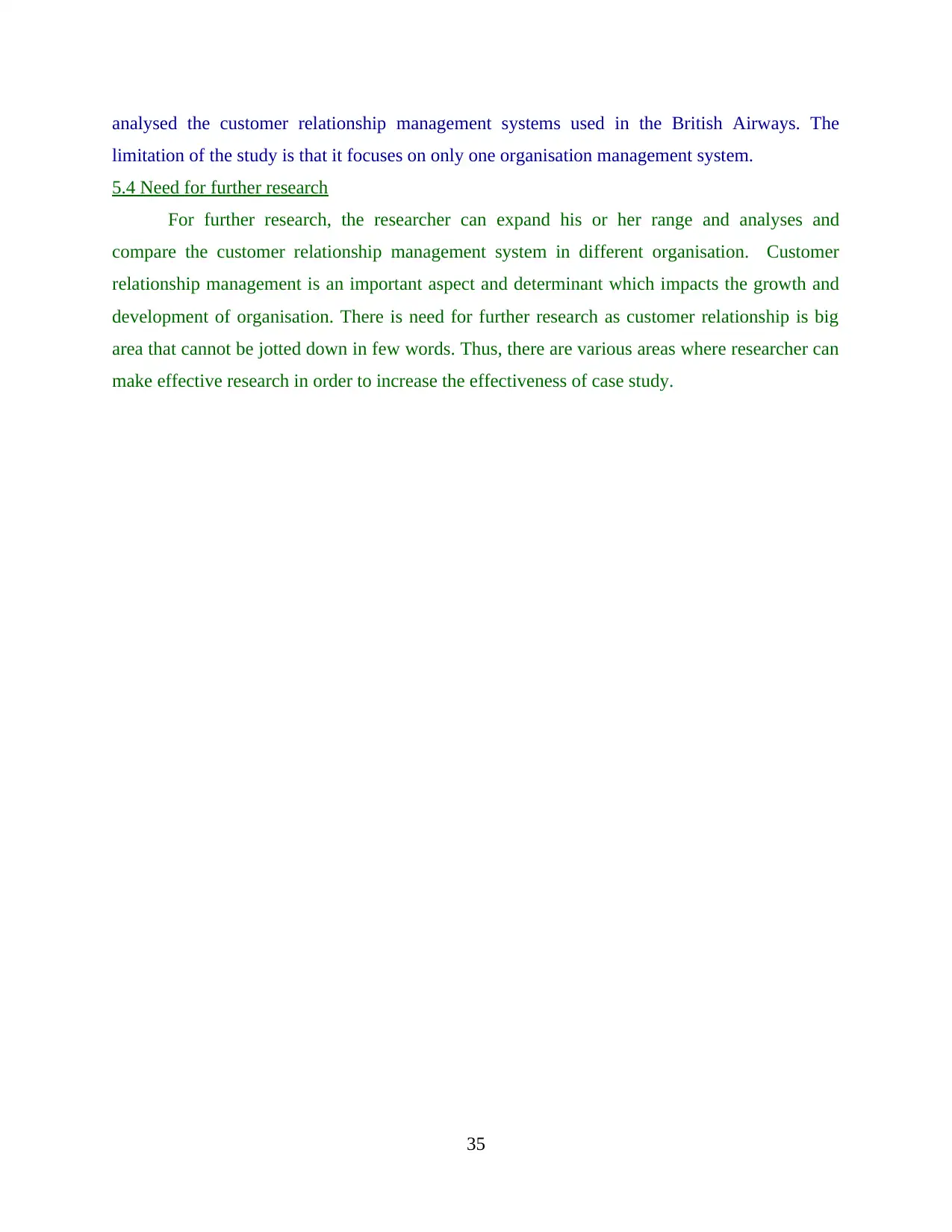
analysed the customer relationship management systems used in the British Airways. The
limitation of the study is that it focuses on only one organisation management system.
5.4 Need for further research
For further research, the researcher can expand his or her range and analyses and
compare the customer relationship management system in different organisation. Customer
relationship management is an important aspect and determinant which impacts the growth and
development of organisation. There is need for further research as customer relationship is big
area that cannot be jotted down in few words. Thus, there are various areas where researcher can
make effective research in order to increase the effectiveness of case study.
35
limitation of the study is that it focuses on only one organisation management system.
5.4 Need for further research
For further research, the researcher can expand his or her range and analyses and
compare the customer relationship management system in different organisation. Customer
relationship management is an important aspect and determinant which impacts the growth and
development of organisation. There is need for further research as customer relationship is big
area that cannot be jotted down in few words. Thus, there are various areas where researcher can
make effective research in order to increase the effectiveness of case study.
35
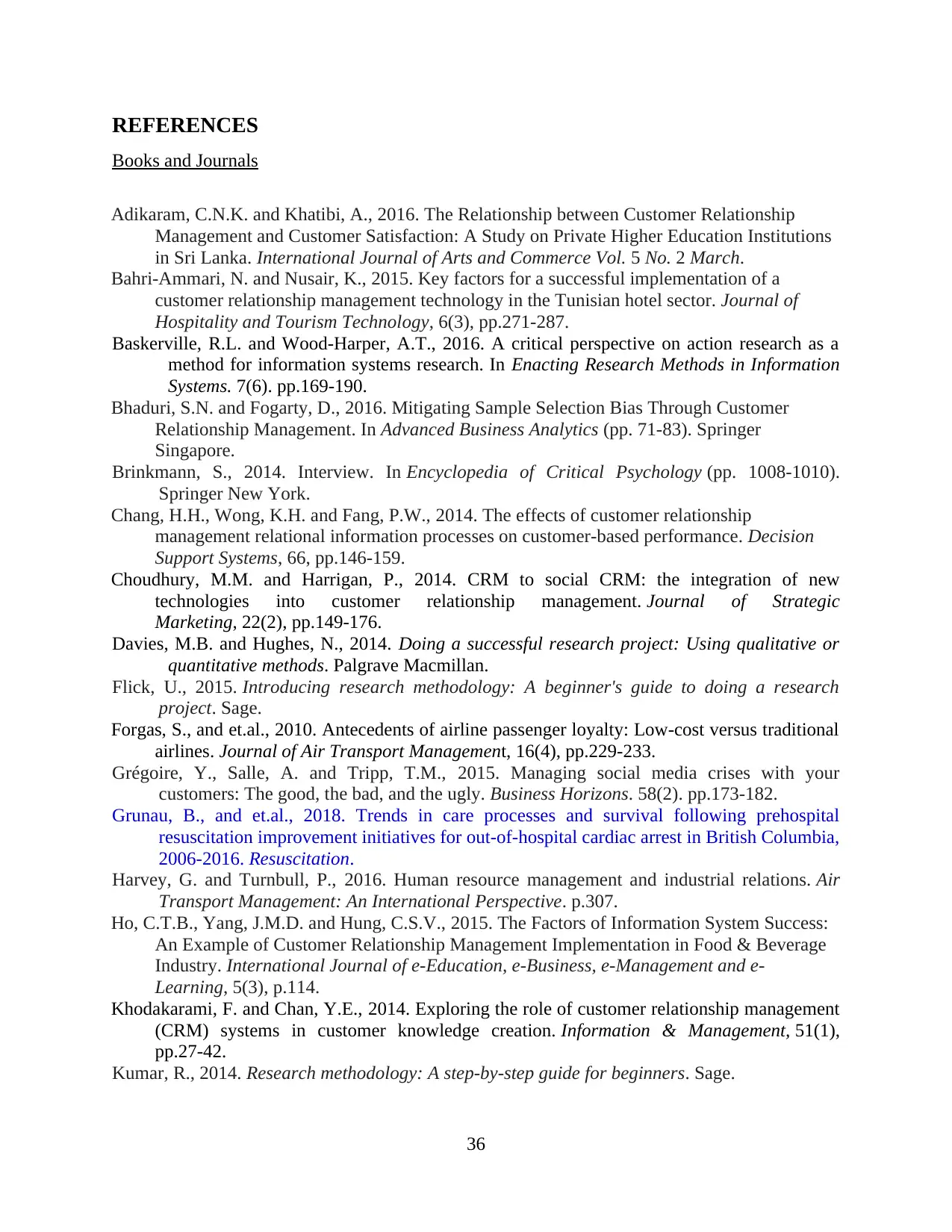
REFERENCES
Books and Journals
Adikaram, C.N.K. and Khatibi, A., 2016. The Relationship between Customer Relationship
Management and Customer Satisfaction: A Study on Private Higher Education Institutions
in Sri Lanka. International Journal of Arts and Commerce Vol. 5 No. 2 March.
Bahri-Ammari, N. and Nusair, K., 2015. Key factors for a successful implementation of a
customer relationship management technology in the Tunisian hotel sector. Journal of
Hospitality and Tourism Technology, 6(3), pp.271-287.
Baskerville, R.L. and Wood-Harper, A.T., 2016. A critical perspective on action research as a
method for information systems research. In Enacting Research Methods in Information
Systems. 7(6). pp.169-190.
Bhaduri, S.N. and Fogarty, D., 2016. Mitigating Sample Selection Bias Through Customer
Relationship Management. In Advanced Business Analytics (pp. 71-83). Springer
Singapore.
Brinkmann, S., 2014. Interview. In Encyclopedia of Critical Psychology (pp. 1008-1010).
Springer New York.
Chang, H.H., Wong, K.H. and Fang, P.W., 2014. The effects of customer relationship
management relational information processes on customer-based performance. Decision
Support Systems, 66, pp.146-159.
Choudhury, M.M. and Harrigan, P., 2014. CRM to social CRM: the integration of new
technologies into customer relationship management. Journal of Strategic
Marketing, 22(2), pp.149-176.
Davies, M.B. and Hughes, N., 2014. Doing a successful research project: Using qualitative or
quantitative methods. Palgrave Macmillan.
Flick, U., 2015. Introducing research methodology: A beginner's guide to doing a research
project. Sage.
Forgas, S., and et.al., 2010. Antecedents of airline passenger loyalty: Low-cost versus traditional
airlines. Journal of Air Transport Management, 16(4), pp.229-233.
Grégoire, Y., Salle, A. and Tripp, T.M., 2015. Managing social media crises with your
customers: The good, the bad, and the ugly. Business Horizons. 58(2). pp.173-182.
Grunau, B., and et.al., 2018. Trends in care processes and survival following prehospital
resuscitation improvement initiatives for out-of-hospital cardiac arrest in British Columbia,
2006-2016. Resuscitation.
Harvey, G. and Turnbull, P., 2016. Human resource management and industrial relations. Air
Transport Management: An International Perspective. p.307.
Ho, C.T.B., Yang, J.M.D. and Hung, C.S.V., 2015. The Factors of Information System Success:
An Example of Customer Relationship Management Implementation in Food & Beverage
Industry. International Journal of e-Education, e-Business, e-Management and e-
Learning, 5(3), p.114.
Khodakarami, F. and Chan, Y.E., 2014. Exploring the role of customer relationship management
(CRM) systems in customer knowledge creation. Information & Management, 51(1),
pp.27-42.
Kumar, R., 2014. Research methodology: A step-by-step guide for beginners. Sage.
36
Books and Journals
Adikaram, C.N.K. and Khatibi, A., 2016. The Relationship between Customer Relationship
Management and Customer Satisfaction: A Study on Private Higher Education Institutions
in Sri Lanka. International Journal of Arts and Commerce Vol. 5 No. 2 March.
Bahri-Ammari, N. and Nusair, K., 2015. Key factors for a successful implementation of a
customer relationship management technology in the Tunisian hotel sector. Journal of
Hospitality and Tourism Technology, 6(3), pp.271-287.
Baskerville, R.L. and Wood-Harper, A.T., 2016. A critical perspective on action research as a
method for information systems research. In Enacting Research Methods in Information
Systems. 7(6). pp.169-190.
Bhaduri, S.N. and Fogarty, D., 2016. Mitigating Sample Selection Bias Through Customer
Relationship Management. In Advanced Business Analytics (pp. 71-83). Springer
Singapore.
Brinkmann, S., 2014. Interview. In Encyclopedia of Critical Psychology (pp. 1008-1010).
Springer New York.
Chang, H.H., Wong, K.H. and Fang, P.W., 2014. The effects of customer relationship
management relational information processes on customer-based performance. Decision
Support Systems, 66, pp.146-159.
Choudhury, M.M. and Harrigan, P., 2014. CRM to social CRM: the integration of new
technologies into customer relationship management. Journal of Strategic
Marketing, 22(2), pp.149-176.
Davies, M.B. and Hughes, N., 2014. Doing a successful research project: Using qualitative or
quantitative methods. Palgrave Macmillan.
Flick, U., 2015. Introducing research methodology: A beginner's guide to doing a research
project. Sage.
Forgas, S., and et.al., 2010. Antecedents of airline passenger loyalty: Low-cost versus traditional
airlines. Journal of Air Transport Management, 16(4), pp.229-233.
Grégoire, Y., Salle, A. and Tripp, T.M., 2015. Managing social media crises with your
customers: The good, the bad, and the ugly. Business Horizons. 58(2). pp.173-182.
Grunau, B., and et.al., 2018. Trends in care processes and survival following prehospital
resuscitation improvement initiatives for out-of-hospital cardiac arrest in British Columbia,
2006-2016. Resuscitation.
Harvey, G. and Turnbull, P., 2016. Human resource management and industrial relations. Air
Transport Management: An International Perspective. p.307.
Ho, C.T.B., Yang, J.M.D. and Hung, C.S.V., 2015. The Factors of Information System Success:
An Example of Customer Relationship Management Implementation in Food & Beverage
Industry. International Journal of e-Education, e-Business, e-Management and e-
Learning, 5(3), p.114.
Khodakarami, F. and Chan, Y.E., 2014. Exploring the role of customer relationship management
(CRM) systems in customer knowledge creation. Information & Management, 51(1),
pp.27-42.
Kumar, R., 2014. Research methodology: A step-by-step guide for beginners. Sage.
36
Secure Best Marks with AI Grader
Need help grading? Try our AI Grader for instant feedback on your assignments.
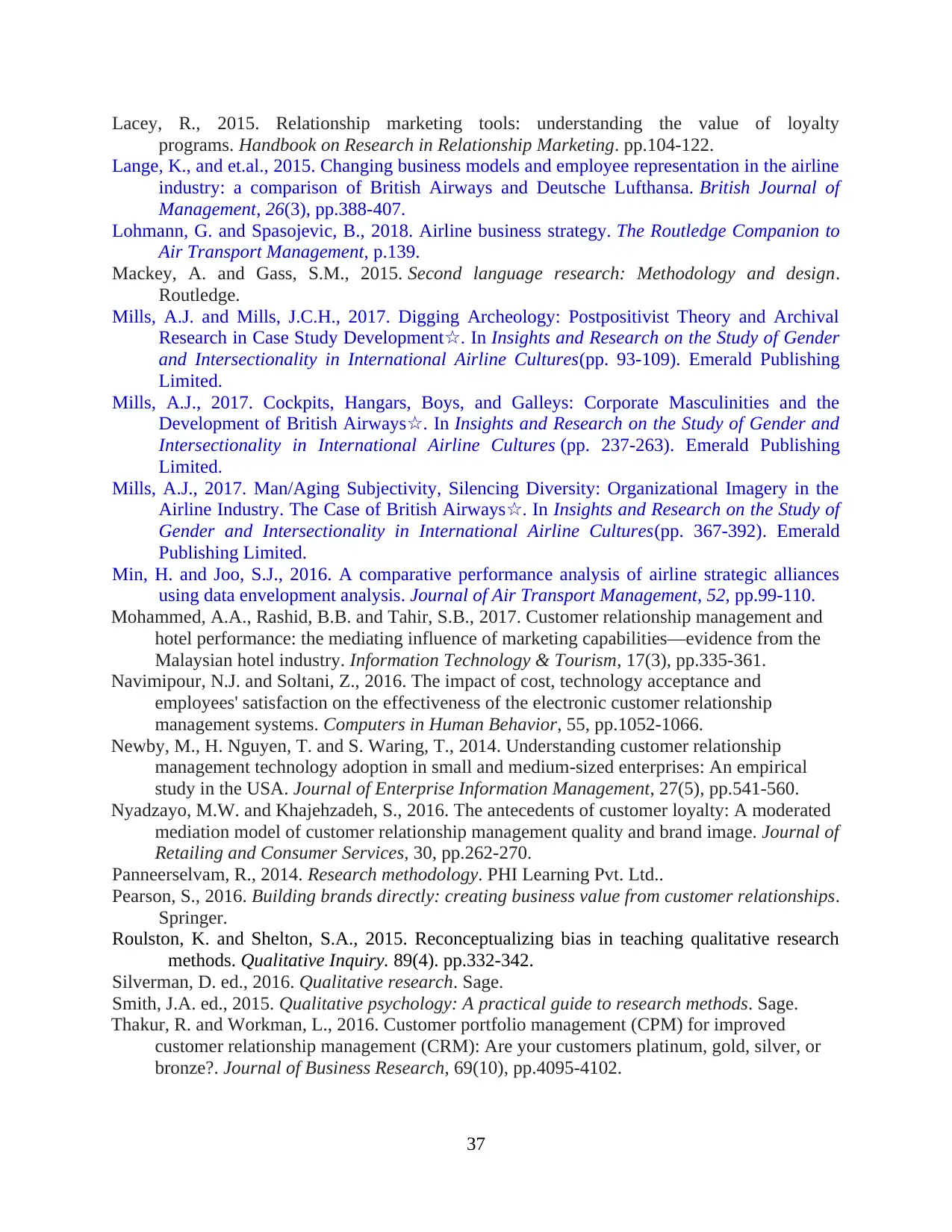
Lacey, R., 2015. Relationship marketing tools: understanding the value of loyalty
programs. Handbook on Research in Relationship Marketing. pp.104-122.
Lange, K., and et.al., 2015. Changing business models and employee representation in the airline
industry: a comparison of British Airways and Deutsche Lufthansa. British Journal of
Management, 26(3), pp.388-407.
Lohmann, G. and Spasojevic, B., 2018. Airline business strategy. The Routledge Companion to
Air Transport Management, p.139.
Mackey, A. and Gass, S.M., 2015. Second language research: Methodology and design.
Routledge.
Mills, A.J. and Mills, J.C.H., 2017. Digging Archeology: Postpositivist Theory and Archival
Research in Case Study Development . In☆ Insights and Research on the Study of Gender
and Intersectionality in International Airline Cultures(pp. 93-109). Emerald Publishing
Limited.
Mills, A.J., 2017. Cockpits, Hangars, Boys, and Galleys: Corporate Masculinities and the
Development of British Airways . In☆ Insights and Research on the Study of Gender and
Intersectionality in International Airline Cultures (pp. 237-263). Emerald Publishing
Limited.
Mills, A.J., 2017. Man/Aging Subjectivity, Silencing Diversity: Organizational Imagery in the
Airline Industry. The Case of British Airways . In☆ Insights and Research on the Study of
Gender and Intersectionality in International Airline Cultures(pp. 367-392). Emerald
Publishing Limited.
Min, H. and Joo, S.J., 2016. A comparative performance analysis of airline strategic alliances
using data envelopment analysis. Journal of Air Transport Management, 52, pp.99-110.
Mohammed, A.A., Rashid, B.B. and Tahir, S.B., 2017. Customer relationship management and
hotel performance: the mediating influence of marketing capabilities—evidence from the
Malaysian hotel industry. Information Technology & Tourism, 17(3), pp.335-361.
Navimipour, N.J. and Soltani, Z., 2016. The impact of cost, technology acceptance and
employees' satisfaction on the effectiveness of the electronic customer relationship
management systems. Computers in Human Behavior, 55, pp.1052-1066.
Newby, M., H. Nguyen, T. and S. Waring, T., 2014. Understanding customer relationship
management technology adoption in small and medium-sized enterprises: An empirical
study in the USA. Journal of Enterprise Information Management, 27(5), pp.541-560.
Nyadzayo, M.W. and Khajehzadeh, S., 2016. The antecedents of customer loyalty: A moderated
mediation model of customer relationship management quality and brand image. Journal of
Retailing and Consumer Services, 30, pp.262-270.
Panneerselvam, R., 2014. Research methodology. PHI Learning Pvt. Ltd..
Pearson, S., 2016. Building brands directly: creating business value from customer relationships.
Springer.
Roulston, K. and Shelton, S.A., 2015. Reconceptualizing bias in teaching qualitative research
methods. Qualitative Inquiry. 89(4). pp.332-342.
Silverman, D. ed., 2016. Qualitative research. Sage.
Smith, J.A. ed., 2015. Qualitative psychology: A practical guide to research methods. Sage.
Thakur, R. and Workman, L., 2016. Customer portfolio management (CPM) for improved
customer relationship management (CRM): Are your customers platinum, gold, silver, or
bronze?. Journal of Business Research, 69(10), pp.4095-4102.
37
programs. Handbook on Research in Relationship Marketing. pp.104-122.
Lange, K., and et.al., 2015. Changing business models and employee representation in the airline
industry: a comparison of British Airways and Deutsche Lufthansa. British Journal of
Management, 26(3), pp.388-407.
Lohmann, G. and Spasojevic, B., 2018. Airline business strategy. The Routledge Companion to
Air Transport Management, p.139.
Mackey, A. and Gass, S.M., 2015. Second language research: Methodology and design.
Routledge.
Mills, A.J. and Mills, J.C.H., 2017. Digging Archeology: Postpositivist Theory and Archival
Research in Case Study Development . In☆ Insights and Research on the Study of Gender
and Intersectionality in International Airline Cultures(pp. 93-109). Emerald Publishing
Limited.
Mills, A.J., 2017. Cockpits, Hangars, Boys, and Galleys: Corporate Masculinities and the
Development of British Airways . In☆ Insights and Research on the Study of Gender and
Intersectionality in International Airline Cultures (pp. 237-263). Emerald Publishing
Limited.
Mills, A.J., 2017. Man/Aging Subjectivity, Silencing Diversity: Organizational Imagery in the
Airline Industry. The Case of British Airways . In☆ Insights and Research on the Study of
Gender and Intersectionality in International Airline Cultures(pp. 367-392). Emerald
Publishing Limited.
Min, H. and Joo, S.J., 2016. A comparative performance analysis of airline strategic alliances
using data envelopment analysis. Journal of Air Transport Management, 52, pp.99-110.
Mohammed, A.A., Rashid, B.B. and Tahir, S.B., 2017. Customer relationship management and
hotel performance: the mediating influence of marketing capabilities—evidence from the
Malaysian hotel industry. Information Technology & Tourism, 17(3), pp.335-361.
Navimipour, N.J. and Soltani, Z., 2016. The impact of cost, technology acceptance and
employees' satisfaction on the effectiveness of the electronic customer relationship
management systems. Computers in Human Behavior, 55, pp.1052-1066.
Newby, M., H. Nguyen, T. and S. Waring, T., 2014. Understanding customer relationship
management technology adoption in small and medium-sized enterprises: An empirical
study in the USA. Journal of Enterprise Information Management, 27(5), pp.541-560.
Nyadzayo, M.W. and Khajehzadeh, S., 2016. The antecedents of customer loyalty: A moderated
mediation model of customer relationship management quality and brand image. Journal of
Retailing and Consumer Services, 30, pp.262-270.
Panneerselvam, R., 2014. Research methodology. PHI Learning Pvt. Ltd..
Pearson, S., 2016. Building brands directly: creating business value from customer relationships.
Springer.
Roulston, K. and Shelton, S.A., 2015. Reconceptualizing bias in teaching qualitative research
methods. Qualitative Inquiry. 89(4). pp.332-342.
Silverman, D. ed., 2016. Qualitative research. Sage.
Smith, J.A. ed., 2015. Qualitative psychology: A practical guide to research methods. Sage.
Thakur, R. and Workman, L., 2016. Customer portfolio management (CPM) for improved
customer relationship management (CRM): Are your customers platinum, gold, silver, or
bronze?. Journal of Business Research, 69(10), pp.4095-4102.
37
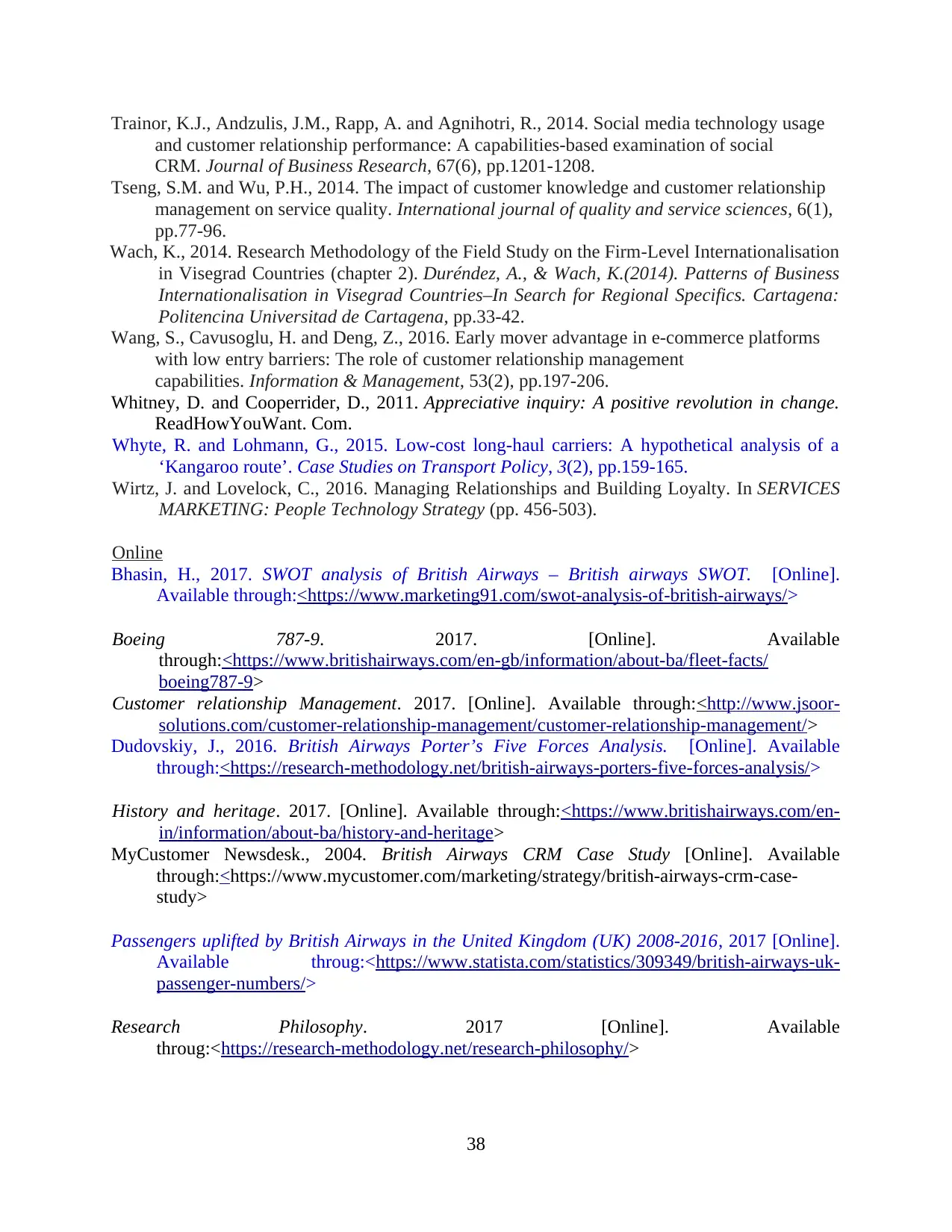
Trainor, K.J., Andzulis, J.M., Rapp, A. and Agnihotri, R., 2014. Social media technology usage
and customer relationship performance: A capabilities-based examination of social
CRM. Journal of Business Research, 67(6), pp.1201-1208.
Tseng, S.M. and Wu, P.H., 2014. The impact of customer knowledge and customer relationship
management on service quality. International journal of quality and service sciences, 6(1),
pp.77-96.
Wach, K., 2014. Research Methodology of the Field Study on the Firm-Level Internationalisation
in Visegrad Countries (chapter 2). Duréndez, A., & Wach, K.(2014). Patterns of Business
Internationalisation in Visegrad Countries–In Search for Regional Specifics. Cartagena:
Politencina Universitad de Cartagena, pp.33-42.
Wang, S., Cavusoglu, H. and Deng, Z., 2016. Early mover advantage in e-commerce platforms
with low entry barriers: The role of customer relationship management
capabilities. Information & Management, 53(2), pp.197-206.
Whitney, D. and Cooperrider, D., 2011. Appreciative inquiry: A positive revolution in change.
ReadHowYouWant. Com.
Whyte, R. and Lohmann, G., 2015. Low-cost long-haul carriers: A hypothetical analysis of a
‘Kangaroo route’. Case Studies on Transport Policy, 3(2), pp.159-165.
Wirtz, J. and Lovelock, C., 2016. Managing Relationships and Building Loyalty. In SERVICES
MARKETING: People Technology Strategy (pp. 456-503).
Online
Bhasin, H., 2017. SWOT analysis of British Airways – British airways SWOT. [Online].
Available through:<https://www.marketing91.com/swot-analysis-of-british-airways/>
Boeing 787-9. 2017. [Online]. Available
through:<https://www.britishairways.com/en-gb/information/about-ba/fleet-facts/
boeing787-9>
Customer relationship Management. 2017. [Online]. Available through:<http://www.jsoor-
solutions.com/customer-relationship-management/customer-relationship-management/>
Dudovskiy, J., 2016. British Airways Porter’s Five Forces Analysis. [Online]. Available
through:<https://research-methodology.net/british-airways-porters-five-forces-analysis/>
History and heritage. 2017. [Online]. Available through:<https://www.britishairways.com/en-
in/information/about-ba/history-and-heritage>
MyCustomer Newsdesk., 2004. British Airways CRM Case Study [Online]. Available
through:<https://www.mycustomer.com/marketing/strategy/british-airways-crm-case-
study>
Passengers uplifted by British Airways in the United Kingdom (UK) 2008-2016, 2017 [Online].
Available throug:<https://www.statista.com/statistics/309349/british-airways-uk-
passenger-numbers/>
Research Philosophy. 2017 [Online]. Available
throug:<https://research-methodology.net/research-philosophy/>
38
and customer relationship performance: A capabilities-based examination of social
CRM. Journal of Business Research, 67(6), pp.1201-1208.
Tseng, S.M. and Wu, P.H., 2014. The impact of customer knowledge and customer relationship
management on service quality. International journal of quality and service sciences, 6(1),
pp.77-96.
Wach, K., 2014. Research Methodology of the Field Study on the Firm-Level Internationalisation
in Visegrad Countries (chapter 2). Duréndez, A., & Wach, K.(2014). Patterns of Business
Internationalisation in Visegrad Countries–In Search for Regional Specifics. Cartagena:
Politencina Universitad de Cartagena, pp.33-42.
Wang, S., Cavusoglu, H. and Deng, Z., 2016. Early mover advantage in e-commerce platforms
with low entry barriers: The role of customer relationship management
capabilities. Information & Management, 53(2), pp.197-206.
Whitney, D. and Cooperrider, D., 2011. Appreciative inquiry: A positive revolution in change.
ReadHowYouWant. Com.
Whyte, R. and Lohmann, G., 2015. Low-cost long-haul carriers: A hypothetical analysis of a
‘Kangaroo route’. Case Studies on Transport Policy, 3(2), pp.159-165.
Wirtz, J. and Lovelock, C., 2016. Managing Relationships and Building Loyalty. In SERVICES
MARKETING: People Technology Strategy (pp. 456-503).
Online
Bhasin, H., 2017. SWOT analysis of British Airways – British airways SWOT. [Online].
Available through:<https://www.marketing91.com/swot-analysis-of-british-airways/>
Boeing 787-9. 2017. [Online]. Available
through:<https://www.britishairways.com/en-gb/information/about-ba/fleet-facts/
boeing787-9>
Customer relationship Management. 2017. [Online]. Available through:<http://www.jsoor-
solutions.com/customer-relationship-management/customer-relationship-management/>
Dudovskiy, J., 2016. British Airways Porter’s Five Forces Analysis. [Online]. Available
through:<https://research-methodology.net/british-airways-porters-five-forces-analysis/>
History and heritage. 2017. [Online]. Available through:<https://www.britishairways.com/en-
in/information/about-ba/history-and-heritage>
MyCustomer Newsdesk., 2004. British Airways CRM Case Study [Online]. Available
through:<https://www.mycustomer.com/marketing/strategy/british-airways-crm-case-
study>
Passengers uplifted by British Airways in the United Kingdom (UK) 2008-2016, 2017 [Online].
Available throug:<https://www.statista.com/statistics/309349/british-airways-uk-
passenger-numbers/>
Research Philosophy. 2017 [Online]. Available
throug:<https://research-methodology.net/research-philosophy/>
38

Rouse, M., 2017. Customer relationship management (CRM) [Online]. Available
through:<http://searchcrm.techtarget.com/definition/CRM>
39
through:<http://searchcrm.techtarget.com/definition/CRM>
39
1 out of 43
Related Documents
Your All-in-One AI-Powered Toolkit for Academic Success.
+13062052269
info@desklib.com
Available 24*7 on WhatsApp / Email
![[object Object]](/_next/static/media/star-bottom.7253800d.svg)
Unlock your academic potential
© 2024 | Zucol Services PVT LTD | All rights reserved.





